Inbox and Environment News: Issue 490
April 18 - 24, 2021: Issue 490
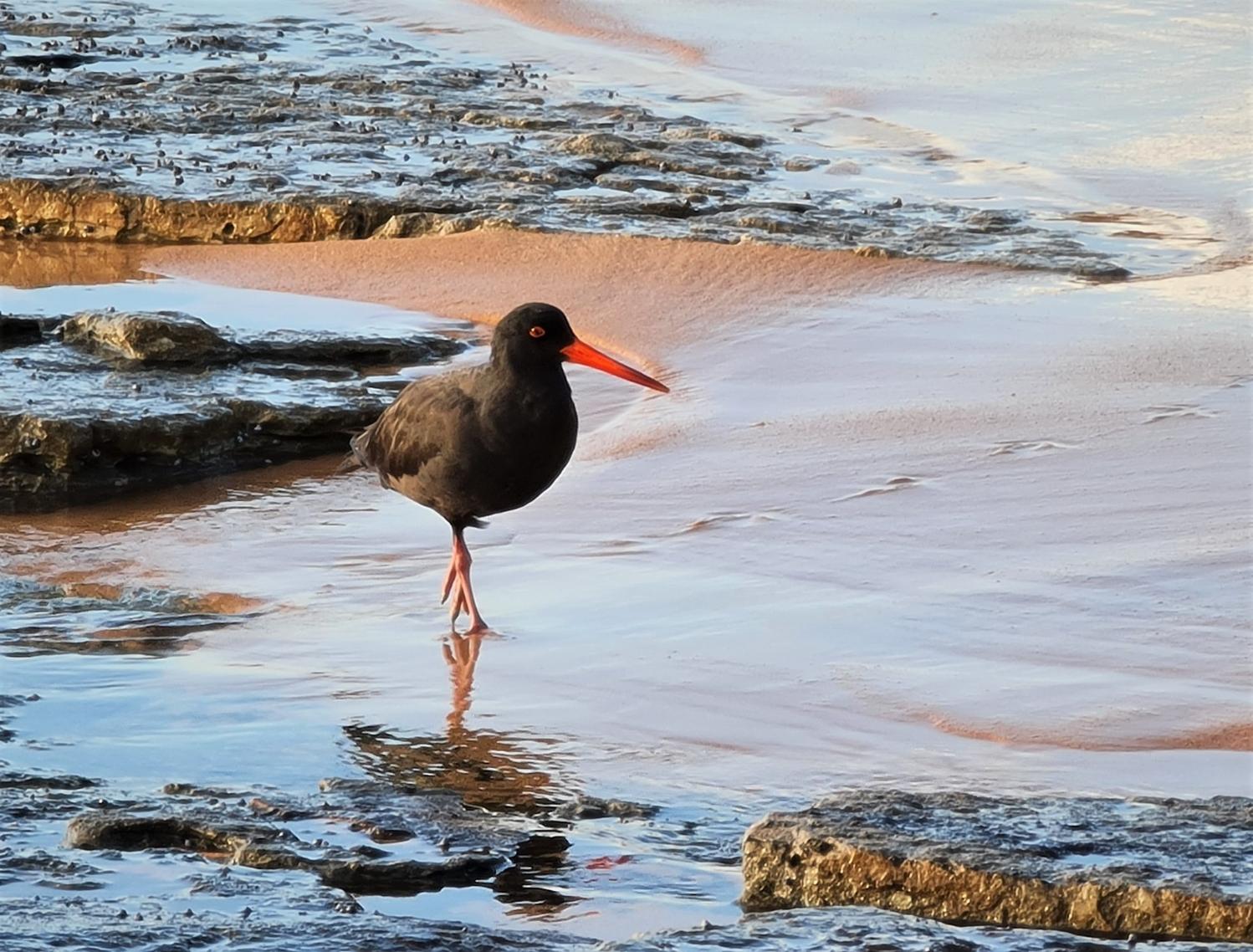
Avalon Golf Course Bushcare Needs You
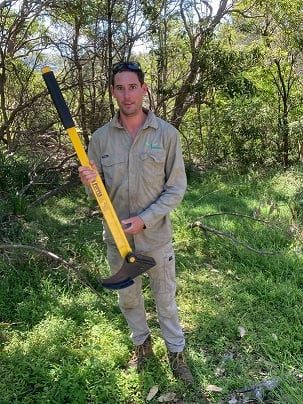
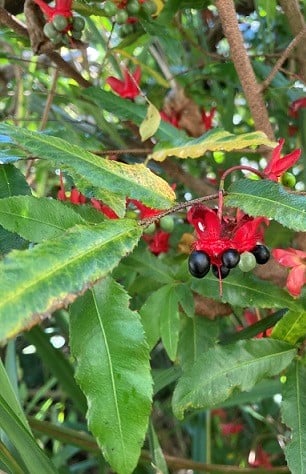
Offshore Petroleum And Greenhouse Gas Storage Amendment Bill: Have Your Say
- expand existing trailing liability provisions
- increase oversight of changes in titleholder ownership and control
- increase regulatory scrutiny of the suitability of companies operating, or looking to operate, within Australia’s offshore petroleum regulatory regime
- expand information gathering powers to enable scrutiny
Ant Lion
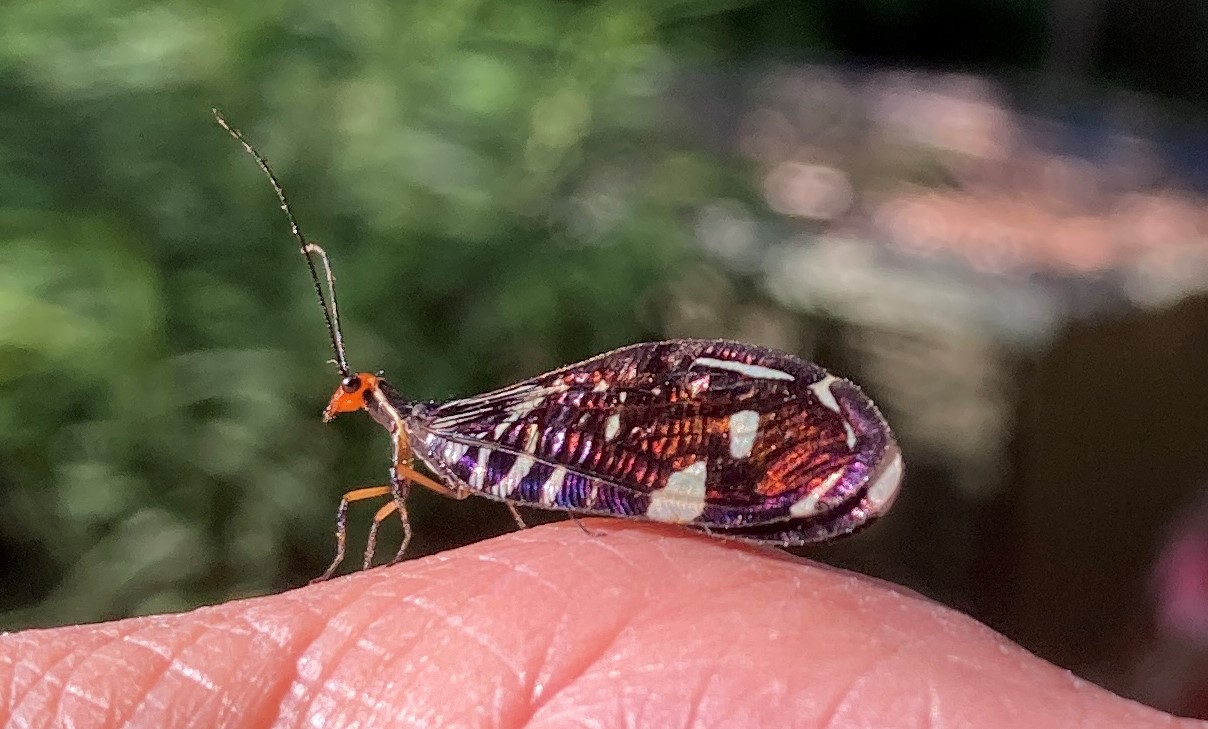
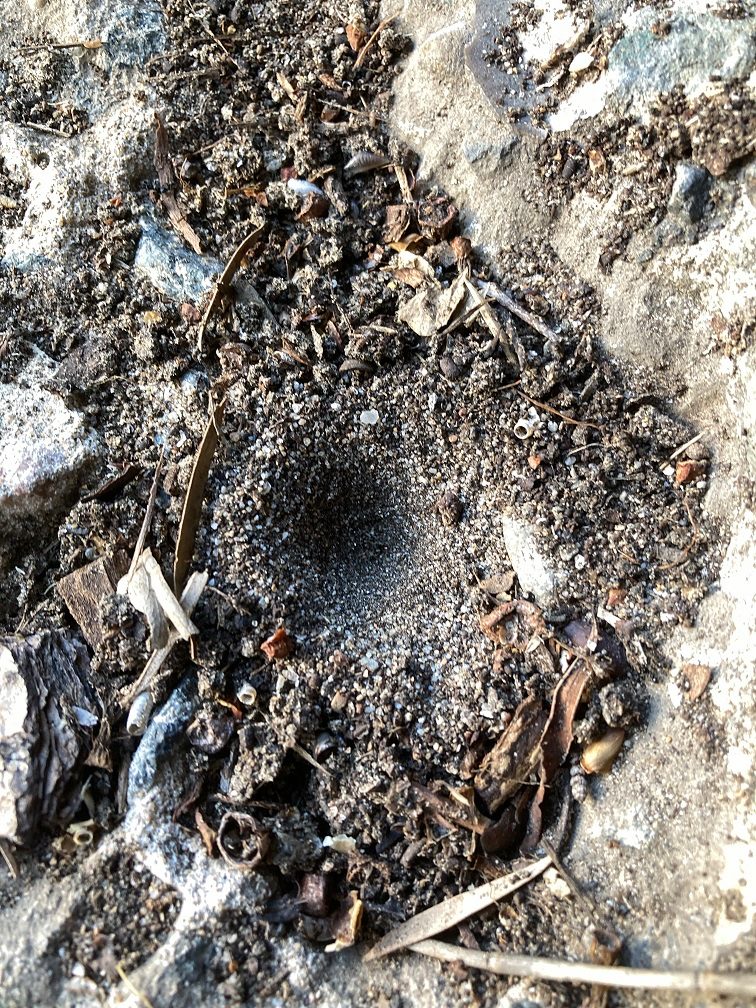
Mona Vale Village Park Trees Now 'Unwired'
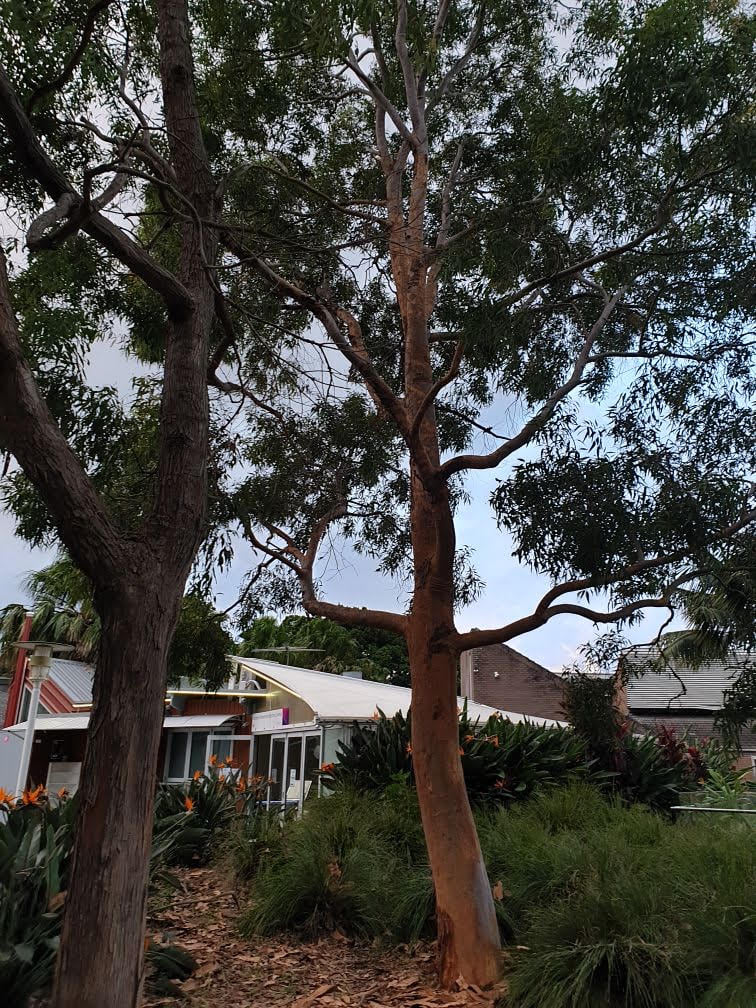
Mona Vale Dunes Bushcare Restoration Update + PNHA Autumn 2021 Newsletter
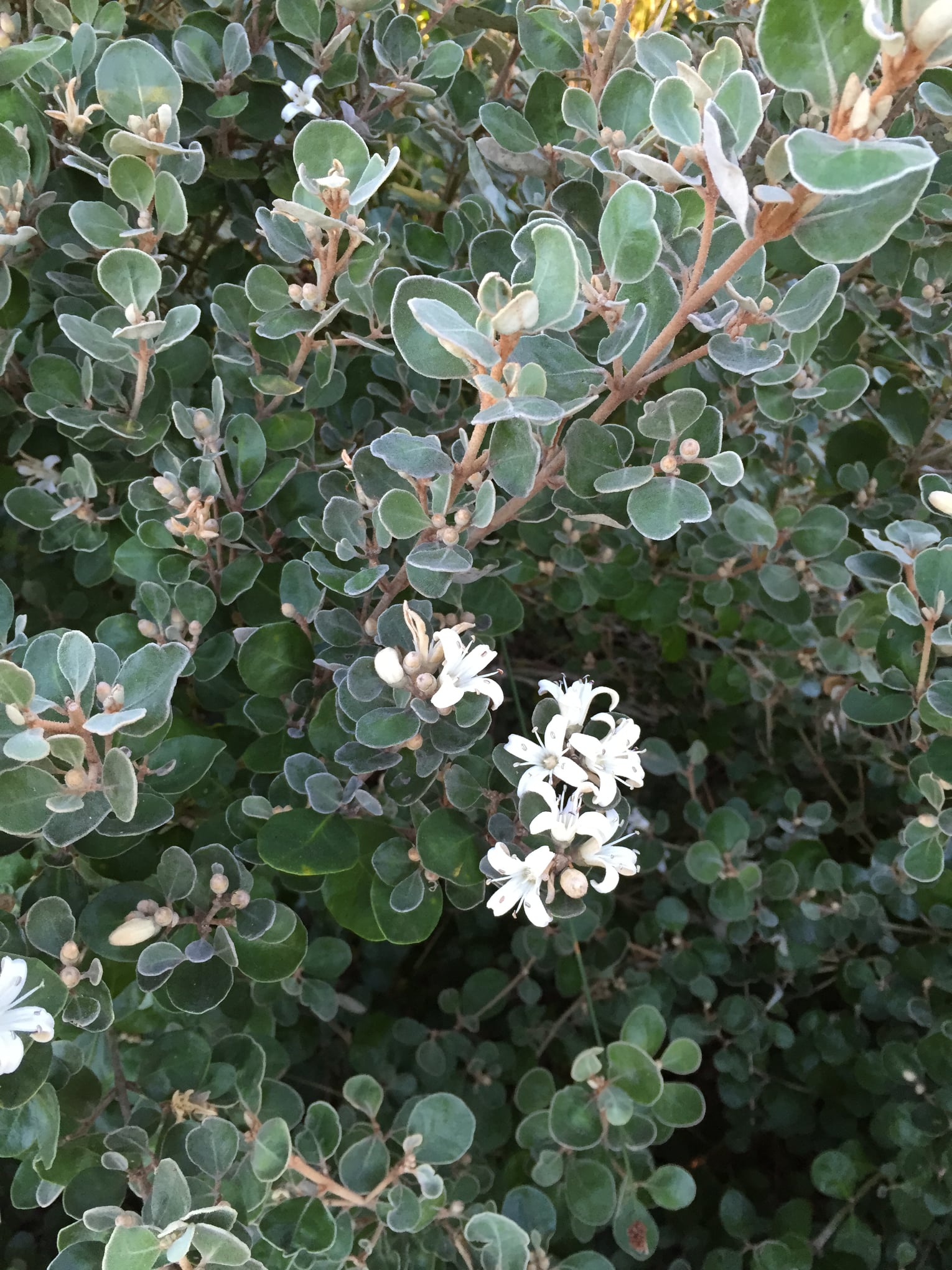
Autumn Edition of PNHA Newsletter - Issue 87
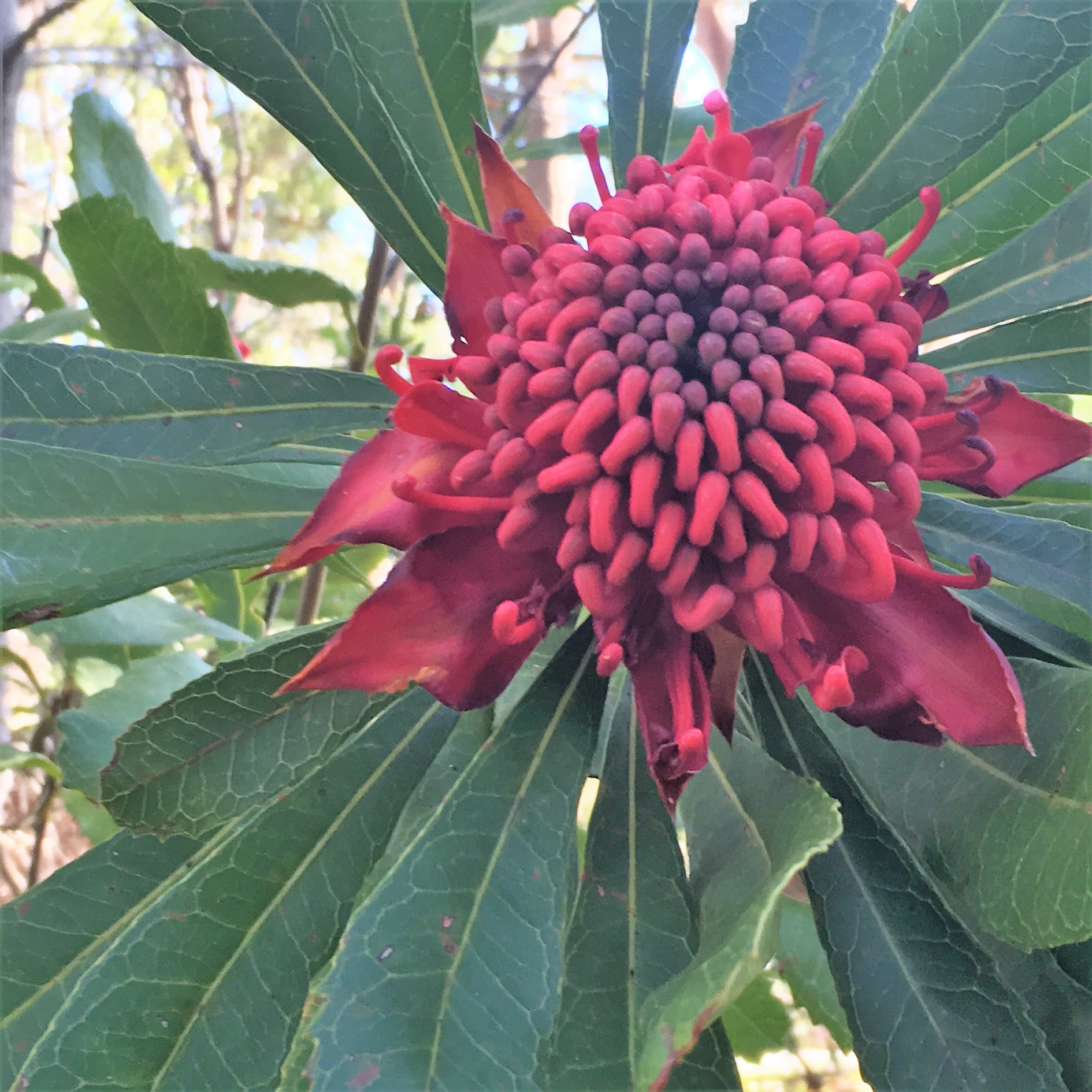
Friends Of Narrabeen Lagoon Catchment: Next Forum + May Activities
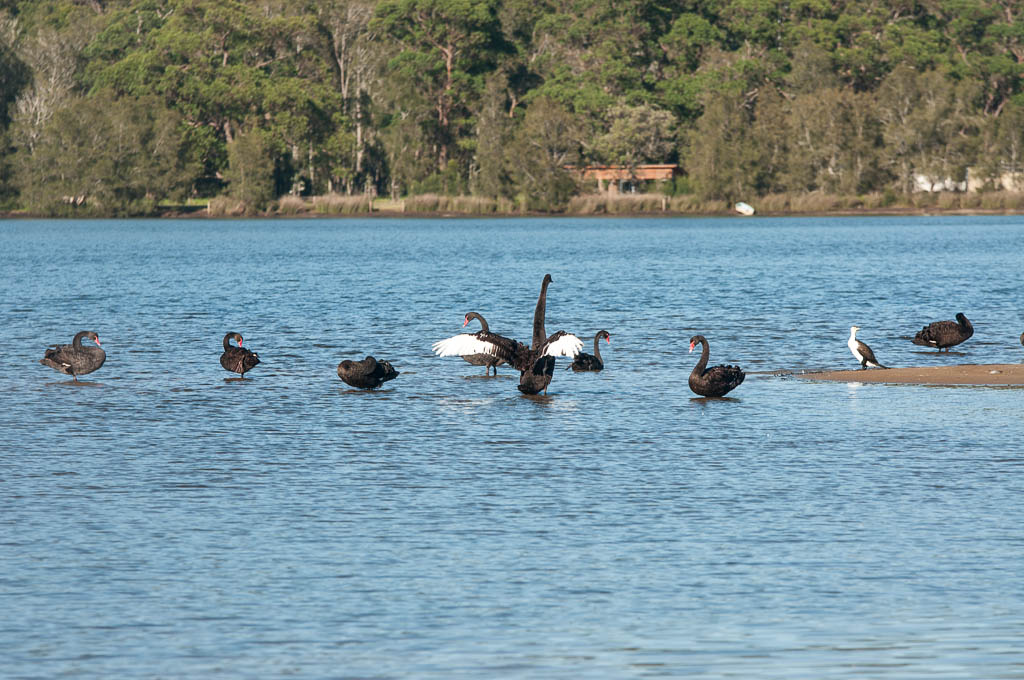
Northern Beaches Clean Up Crew: Update
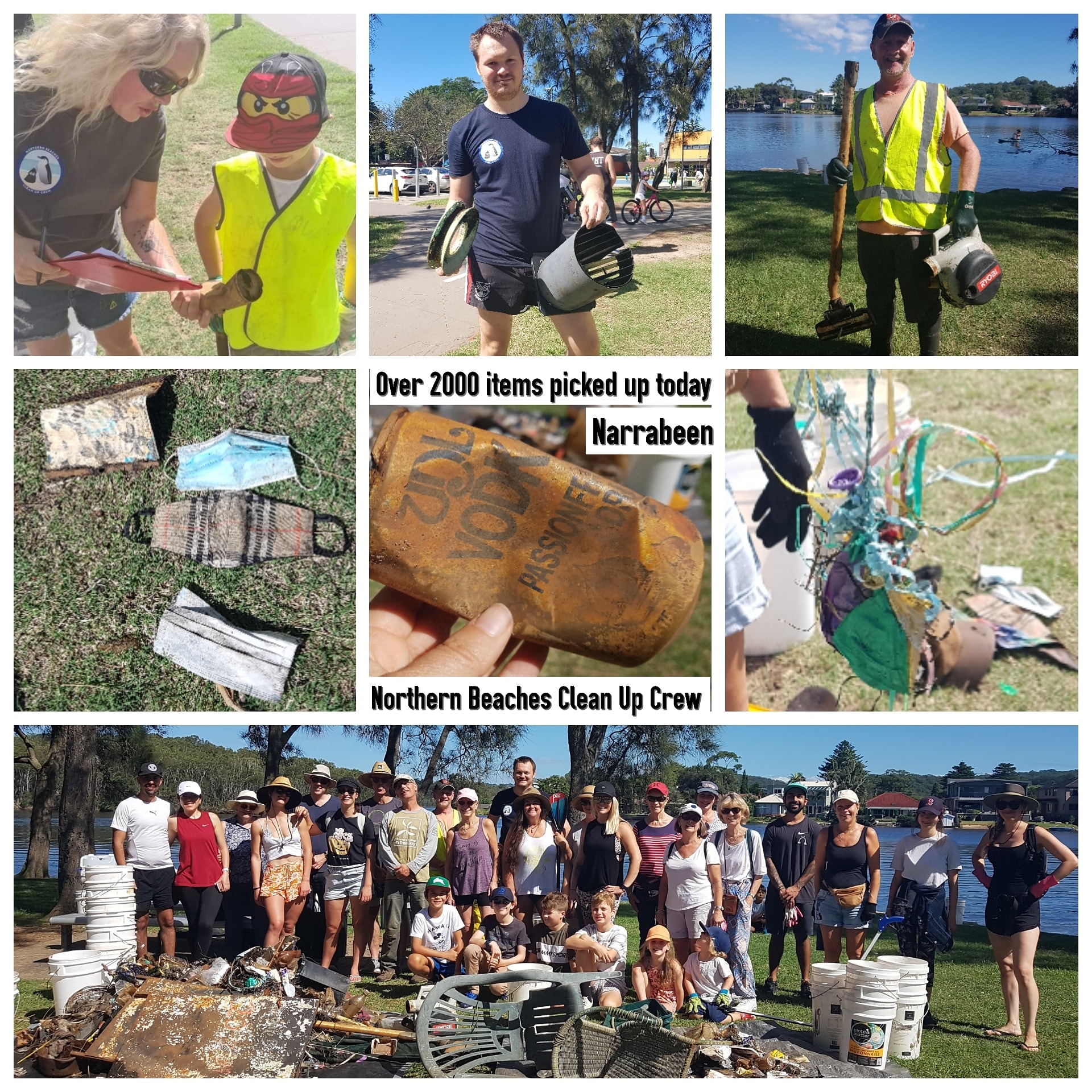
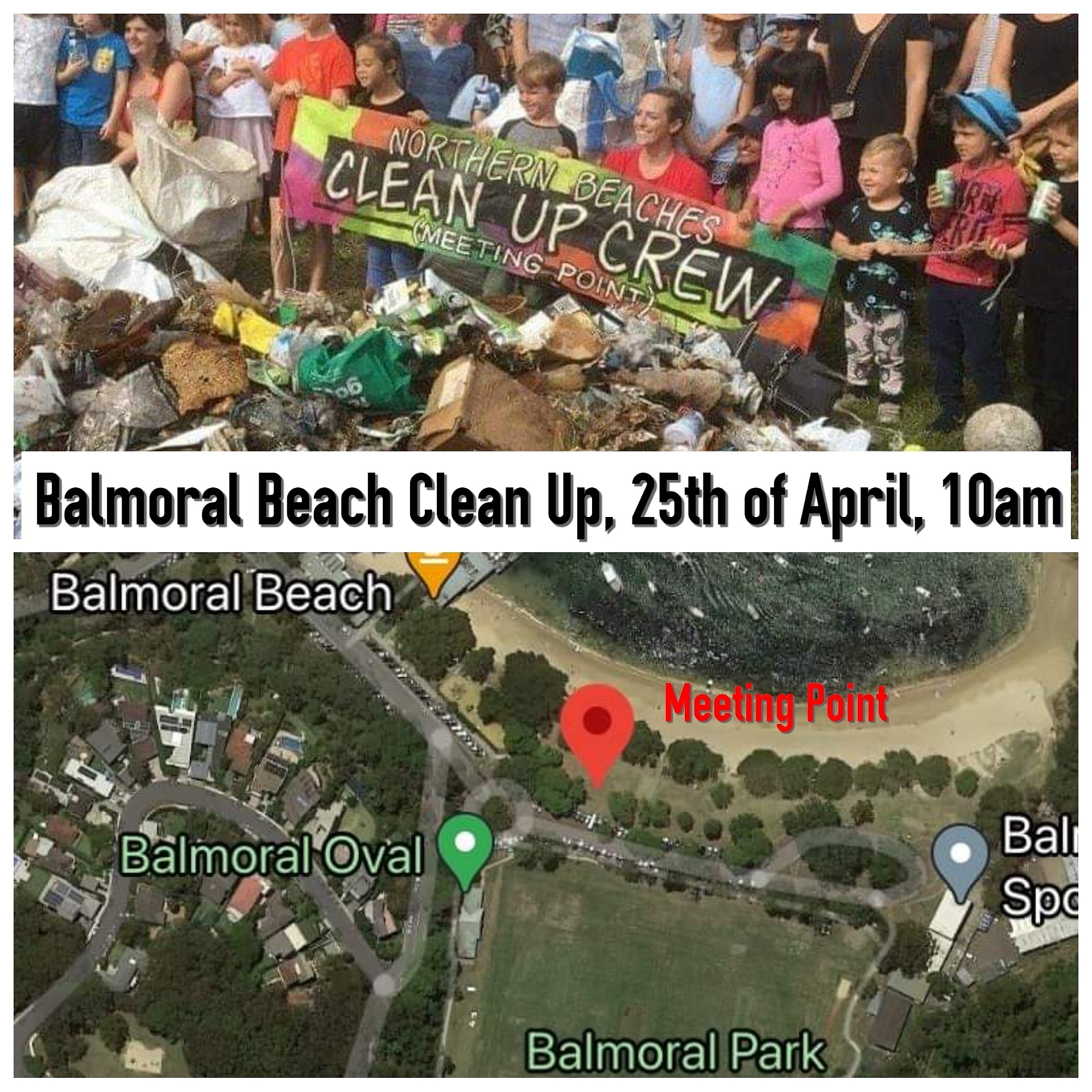
Sculptural Trees: 100 Year Old Angophora Kept In Local Park
Avalon Community Garden
Avalon Community Garden’s primary purpose is to foster, encourage and facilitate community gardening in Pittwater on a not-for-profit basis.
The garden was started in 2010 by a group of locals who worked in conjunction with the support of Barrenjoey High School to develop a space that could be used by the local community, to grow
vegetables, herbs, plants and flowers, and practice sustainable gardening techniques to benefit its members and the community overall.
The garden has been very successful and has grown and developed since its inception, in terms of its footprint, infrastructure, variety of produce and diversity of members. The garden welcomes new members all year round. Levels of contribution range from multiple times a week, to once a month. Your contribution is always welcome, and it is acknowledged people will have varying levels of commitment.
We encourage you to join and start enjoying the following benefits associated with community gardening:
They provide benefits for individuals and for the community as a whole. Community gardens provide education on gardening, recycling and sustainable use of natural resources.
They develop community connections and provide a means of engaging youth, children, the elderly and the disabled and otherwise marginalised individuals in mutually enjoyable and rewarding activities, thus helping to develop more functional and resilient communities.
People involved in community gardens say they improve wellbeing by increasing physical activity and reducing stress, providing opportunities to interact meaningfully with new friends, give time for relaxation and reflection as well as an opportunity to improve their interconnectedness with nature.
To get involved take a look around the site, join the Facebook group and come along and visit on a Sunday morning between 10 and 12 at the garden within Barrenjoey High School on Tasman Road, North Avalon.
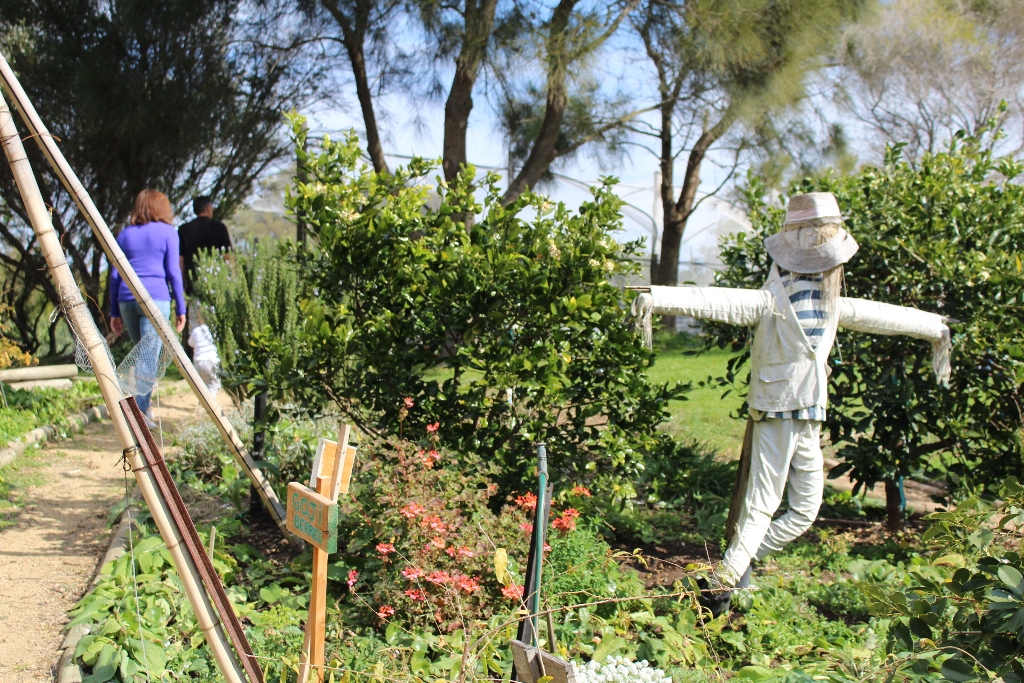
BirdLife Australia Autumn Survey Time
- Breeding behaviours - If you see a bird carrying nesting materials, sitting on a nest or feeding chicks, let us know. Select the option under 'Breeding Activity' that best matches your observation (remember to keep your distance though from birds who are breeding. We don't want to disturb any nests. Be sure to limit your observations and don't get close enough to scare a bird off it's nest.)
- Aggressive interactions – Let us know if you have observed any species initiate interactions with other birds and whether this interaction could be classed as aggressive – you can do this in the sighting details tab using the specific species interactions option.
- Have you seen any birds feeding on the native plants in your garden? If so – who was dining on what? – you can tell us in the notes section when you record the species you have observed under “sighting details”
- Have any birds been dabbling in some Oscar-worthy acting? – tell us about the weird and wonderful things your backyard birds have been up to you using the notes section in the sighting details tabs.
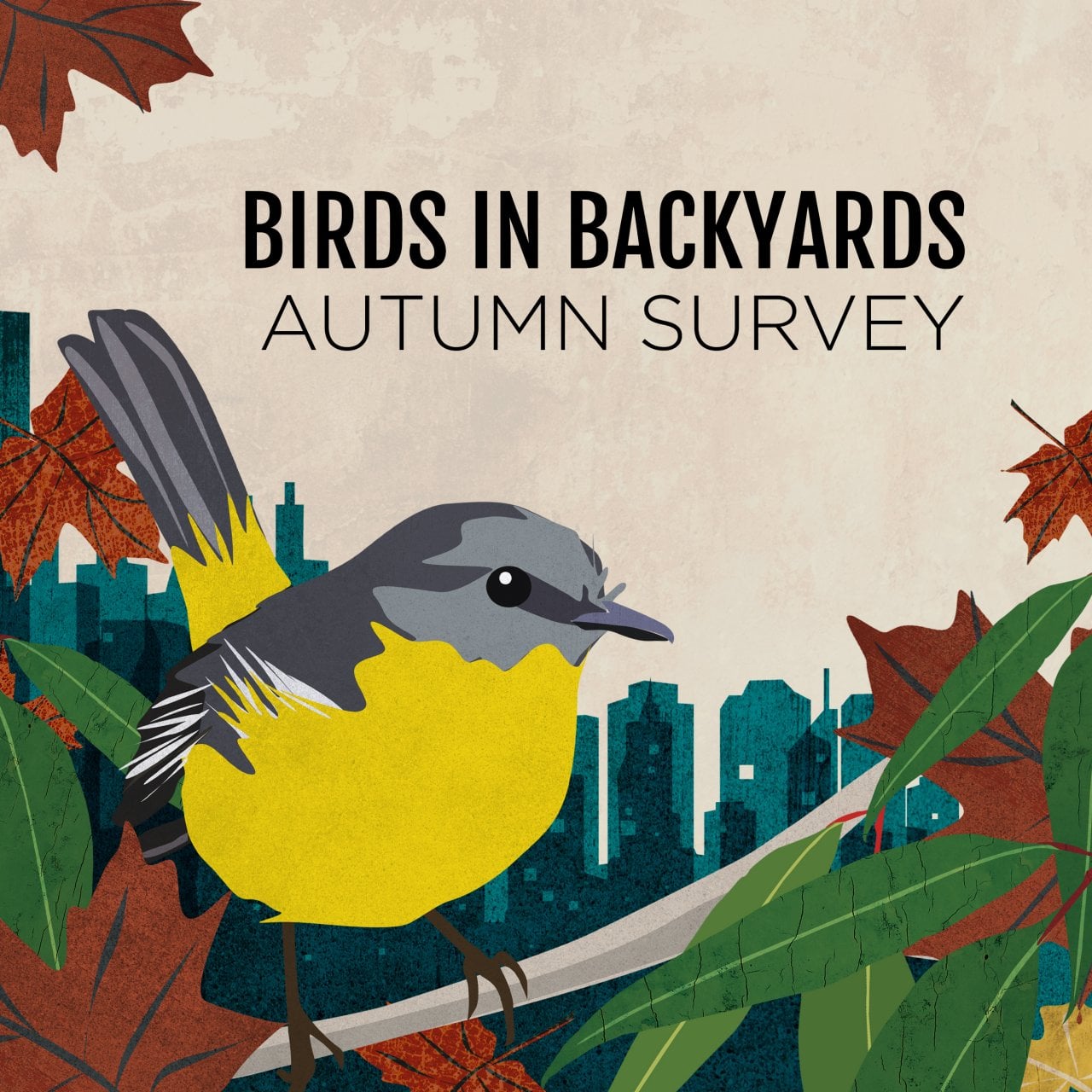
Four Corners Reveals Morrison’s Gas Plan Driven By Ideology Not Logic
Barilaro Can’t Blow Smoke Over Upper Hunter Eyes As Mangoola Tries To Expand
Draft NSW Clean Air Strategy: Public Consultation
- first name
- last name
- organisation you represent (if applicable)
- email address
- postcode.
Inquiry Into Declining Numbers Of Macropods
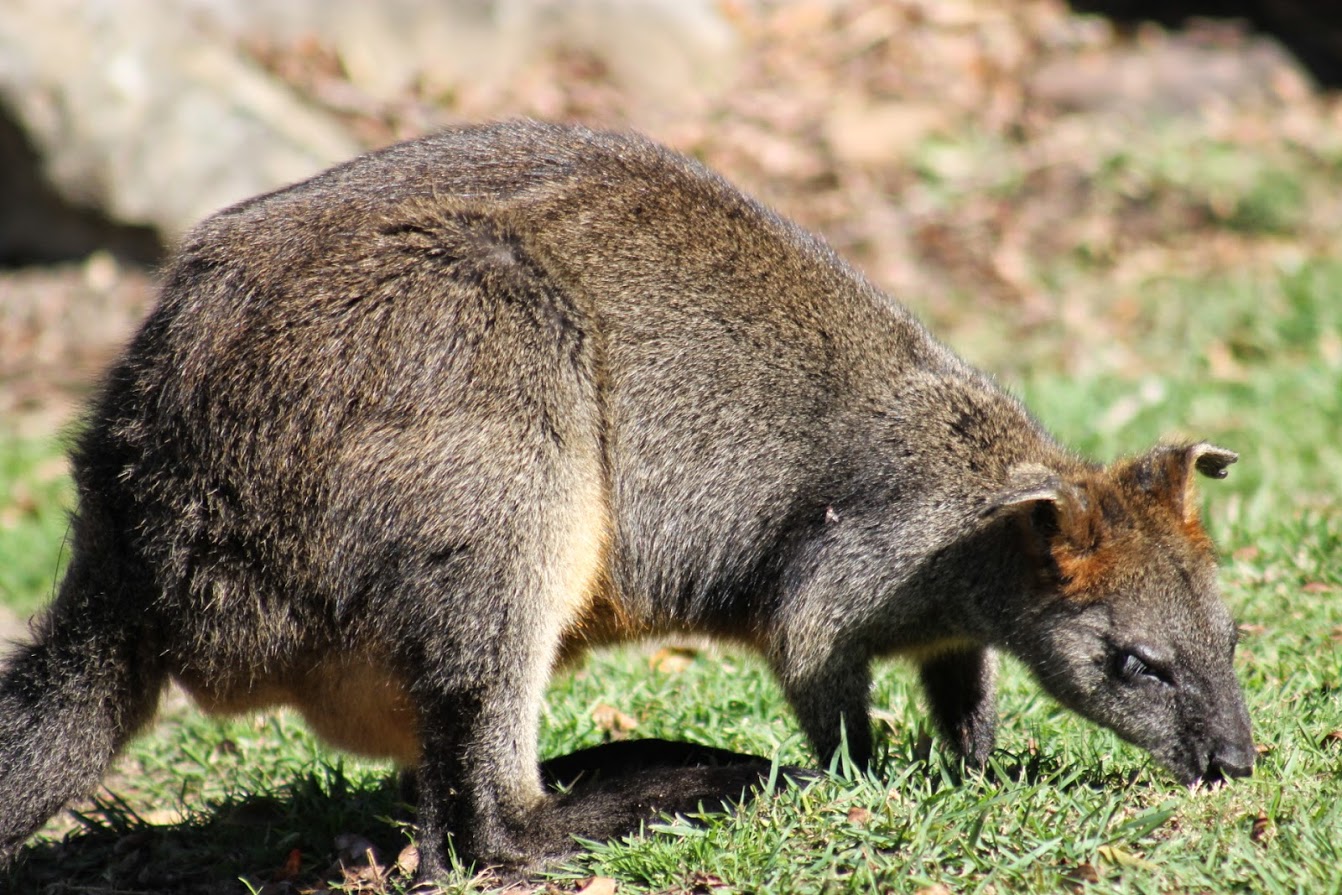
Bushcare In Pittwater
Where we work Which day What time
Avalon
Angophora Reserve 3rd Sunday 8:30 - 11:30am
Avalon Dunes 1st Sunday 8:30 - 11:30am
Avalon Golf Course 2nd Wednesday 3 - 5:30pm
Careel Creek 4th Saturday 8:30 - 11:30am
Toongari Reserve 3rd Saturday 9 - 12noon (8 - 11am in summer)
Bangalley Headland 2nd Sunday 9 to 12noon
Bayview
Winnererremy Bay 4th Sunday 9 to 12noon
Bilgola
North Bilgola Beach 3rd Monday 9 - 12noon
Algona Reserve 1st Saturday 9 - 12noon
Plateau Park 1st Friday 8:30 - 11:30am
Church Point
Browns Bay Reserve 1st Tuesday 9 - 12noon
McCarrs Creek Reserve Contact Bushcare Officer To be confirmed
Clareville
Old Wharf Reserve 3rd Saturday 8 - 11am
Elanora
Kundibah Reserve 4th Sunday 8:30 - 11:30am
 Mona Vale
Mona Vale Mona Vale Beach Basin 1st Saturday 8 - 11am
Mona Vale Dunes 2nd Saturday +3rd Thursday 8:30 - 11:30am
Newport
Bungan Beach 4th Sunday 9 - 12noon
Crescent Reserve 3rd Sunday 9 - 12noon
North Newport Beach 4th Saturday 8:30 - 11:30am
Porter Reserve 2nd Saturday 8 - 11am
North Narrabeen
Irrawong Reserve 2nd Saturday 2 - 5pm
Palm Beach
North Palm Beach Dunes 3rd Saturday 9 - 12noon
Scotland Island
Catherine Park 2nd Sunday 10 - 12:30pm
Elizabeth Park 1st Saturday 9 - 12noon
Pathilda Reserve 3rd Saturday 9 - 12noon
Warriewood
Warriewood Wetlands 1st Sunday 8:30 - 11:30am
Whale Beach
Norma Park 1st Friday 9 - 12noon
Western Foreshores
Coopers Point, Elvina Bay 2nd Sunday 10 - 1pm
Rocky Point, Elvina Bay 1st Monday 9 - 12noon
Gardens And Environment Groups And Organisations In Pittwater
Pittwater Reserves

Sydney's disastrous flood wasn't unprecedented: we're about to enter a 50-year period of frequent, major floods
Tom Hubble, University of SydneyLast month’s flood in the Hawkesbury-Nepean River region of western Sydney peaked at a staggering 12.9 metres, with water engulfing road signs and reaching the tops of many houses.
There hasn’t been a major flood on the Hawkesbury-Nepean for more than 30 years, with the last comparable one occurring in 1990. Long-term Sydneysiders, however, will remember that 12 major floods occurred during the 40 years before 1990. Five of these were larger than last month’s flood.
So what’s going on? The long-term rainfall pattern in the region and corresponding river flow is cyclic in nature. This means 40 to 50 years of dry weather with infrequent small floods are followed by 40 to 50 years of wet weather with frequent major floods.
As river and floodplain residents take stock of the recent damage to their homes and plan necessary repairs, it’s vital they recognise more floods are on the way. Large, frequent floods can be expected to occur again within 10 or 20 years if — as expected — the historical pattern of rainfall and flooding repeats itself.
Living In A Bathtub
Many of the 18,000 people who were evacuated live in and around a region known as the “Sackville Bathtub”. As the name suggests, this flat, low-lying section of the floodplain region was spectacularly affected.
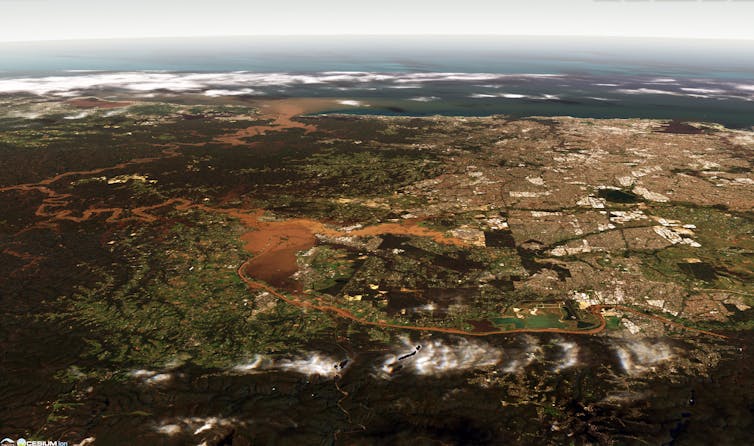
The Sackville Bathtub is located between Richmond and Sackville. It’s part of the Cumberland Plain area of Western Sydney and formed very slowly over 100 million years due to plate tectonic processes. The bathtub’s mudstone rock layers are folded into a broad, shallow, basin-shaped depression, which is surrounded by steep terrain.
Downstream of Sackville, the Hawkesbury-Nepean River flows through sandstone gorges and narrows in width. This creates a pinch-point that partially blocks the river channel.
Just as a bath plug sitting half-way over a plughole slows an emptying bath, the Sackville pinch-point causes the bathtub to fill during floods.
Will Raising The Dam Wall Work?
The NSW state government is planning to raise the wall of the Warragamba Dam to help mitigate catastrophic floods in the region. But this may not be an effective solution.
Typically, somewhere between 40% and 60% of the floodwater that fills up the Sackville Bathtub comes from unimpeded, non-Warragamba sources. So, when the Hawkesbury-Nepean River floods, the bathtub is already quite full and causing significant problems before Warragamba begins to spill. The Warragamba water then raises the flood level, but often by only a couple of metres.
Raising Warragamba Dam’s wall as a mitigation measure will only control about half the floodwater, and won’t prevent major floods delivered by the Nepean and Grose rivers, which also feed into the region. This represents a small potential benefit for a very large cost.
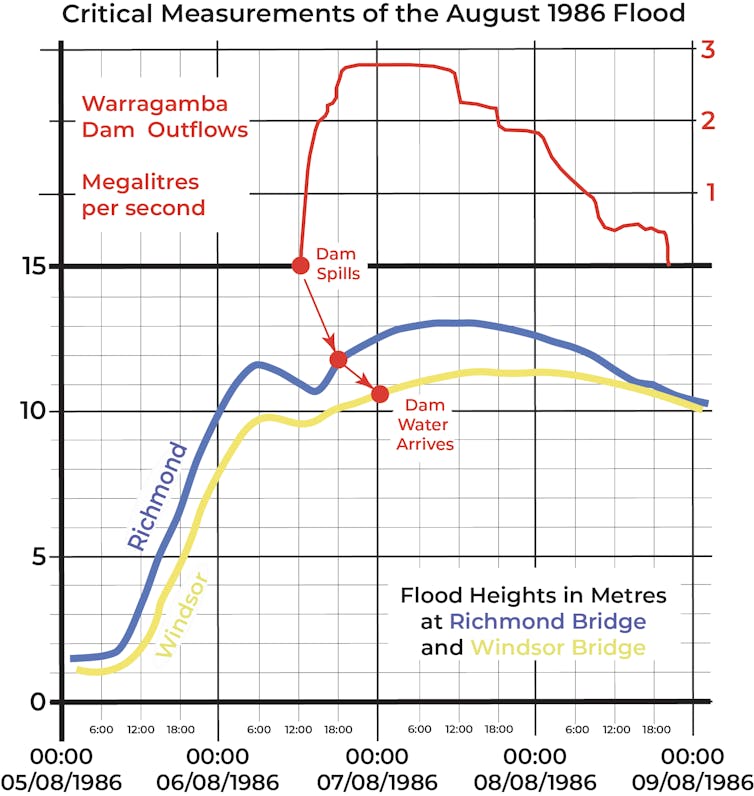
A Long Flooding Period Is On Our Doorstep
The idea of drought-dominated and flood-dominated periods for the Hawkesbury-Nepean River system was proposed in the mid-1970s by the University of Sydney’s Robin Warner. Since the late 1990’s, it hasn’t been the focus of much research.
Read more: What is a 1 in 100 year weather event? And why do they keep happening so often?
He showed a century-long cycle of alternating periods of dry weather and small floods followed by wet weather and big floods is normal for Sydney. This means the March flood may not have come as a surprise to older residents of the Sackville Bathtub, who have a lived experience of the whole 40-50 year flooding cycle.
As a rough average, one major flood occurred every four years during the last wet-weather period between 1950 and 1990. The largest of this period occurred in November 1961. It filled the Sackville Bathtub to a depth of 15 metres and — like the June 1964 (14.6 metres) and March 1978 (14.5 metres) events — caused more widespread flooding than this year’s flood.
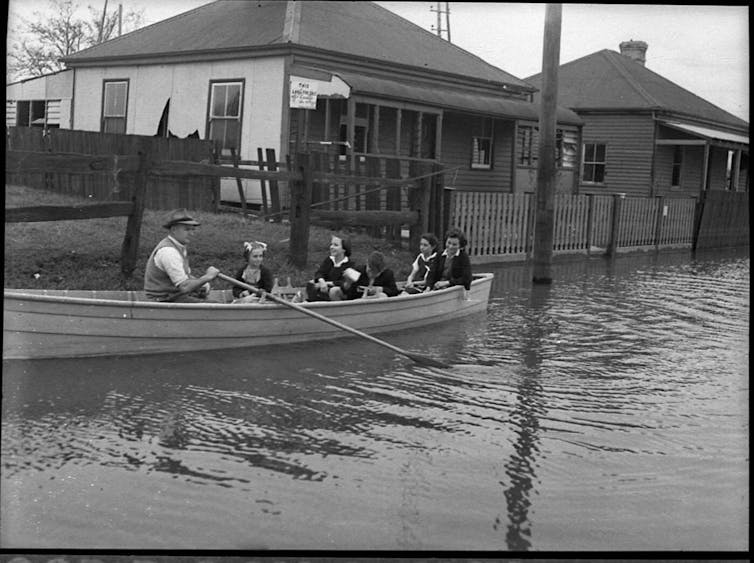
We’re currently 30 years into a dry period, which may be about to end. Conditions might stay dry for another 10 or 20 years.
These cycles are likely caused by natural, long-term “climate drivers” — long-term climatic fluctuations such as El Niño and La Niña, the Pacific Decadal Oscillation and the Indian Ocean Dipole, which are driven by oceanic current circulations. These global phenomena bring both benevolent weather and destructive weather to Australia.
Eastern Australia experiences decades-long periods of wetter weather when these climate drivers sync up with each other. When they’re out of sync, we get dry weather periods.
These long-term cycles are natural and have been operating for thousands of years, but climate change is amplifying and accelerating them. Dry periods are getting drier, wet periods are getting wetter.
The Good News And Bad News
The bad news is that 12-plus metre floods at Hawkesbury River (Windsor Bridge) are not all that unusual. There have been 24, 12-plus metre floods at Windsor Bridge since 1799.
The good news is meteorological forecasters are excellent at predicting when the storms that generate moderate, large and catastrophic floods are coming. We can expect several days’ to a week’s notice of the next big flood.
We can also prepare our individual and communal responses for more large and frequent floods on the Hawkesbury-Nepean. Residents of the area need to think about how they might live near the river as individuals. Decide what is precious and what you will fit into a car and trailer. Practice evacuating.
As a community, we must ensure the transport infrastructure and evacuation protocols minimise disruption to river and floodplain residents while maximising their safety. It’s particularly important we set up inclusive infrastructure to ensure disadvantaged people, who are disproportionately affected by disasters, also have a fighting chance to evacuate and survive.
Read more: Not 'if', but 'when': city planners need to design for flooding. These examples show the way
Upgrading the escape routes that enable people to evacuate efficiently is absolutely vital. As is rethinking whether we should continue urban expansion in the Sackville Bathtub.
So remember, the next major flood is going to occur sooner than we would like. If you live in this region, you must start preparing. Or as a wise elder once said, “Live on a floodplain, own a boat!”
This story is part of a series The Conversation is running on the nexus between disaster, disadvantage and resilience. Read the rest of the stories here.![]()
Tom Hubble, Associate Professor, University of Sydney
This article is republished from The Conversation under a Creative Commons license. Read the original article.
Is Malcolm Turnbull the only Liberal who understands economics and climate science – or the only one who'll talk about it?
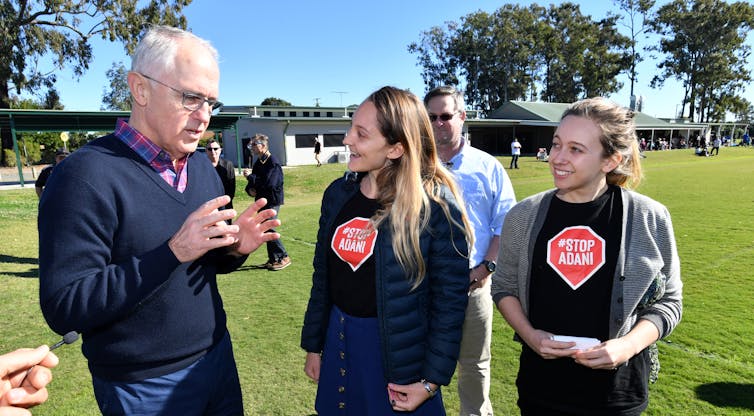
Yesterday, former Liberal prime minister Malcolm Turnbull was unceremoniously dumped as chair of the New South Wales government’s climate advisory board, just a week after being offered the role. His crime? He questioned the wisdom of building new coal mines when the existing ones are already floundering.
No-one would suggest building new hotels in Cairns to help that city’s struggling tourism industry. But among modern Liberals it’s patently heresy to ask how rushing to green light 11 proposed coal mines in the Hunter Valley helps the struggling coal industry.
Coal mines in the Hunter are already operating well below capacity and have been laying off workers in the face of declining world demand for coal, plummeting renewable energy prices and trade sanctions imposed by China. The problem isn’t a shortage of supply, but an abundance.
The simple truth is building new coal mines will simply make matters worse, especially for workers in existing coal mines that have already been mothballed or had their output scaled back.
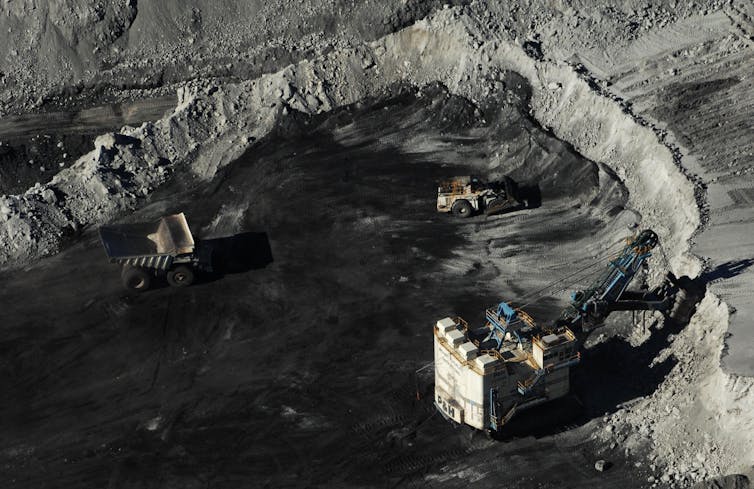
It gets worse. Once an enormous, dusty, noisy open cut coal mine is approved, the agriculture, wine, tourism and horse breeding industries – all major employers in the Hunter Valley – are reluctant to invest nearby. While building new coal mines hurts workers in existing coal mines, the mere act of approving new coal mines harms investment in job creation in the industries that offer the Hunter a smooth transition from coal.
The NSW planning department doesn’t have a plan for how many new coal mines are needed to meet world demand. Nor does it have a plan for how much expansion of rail and port infrastructure is required to meet the output of all the new mines being proposed.
That’s why my colleagues and I recently called for a moratorium on new coal mines in the Hunter until such plans were made explicit. Just as you wouldn’t approve 1,000 new homes in a town where the sewerage system was already at capacity, it makes no sense to approve 11 new coal mines in a region that couldn’t export that much coal if it tried.
But if there’s one thing that defines the debate about coal in Australia, its that it makes no sense.
Just as it made no sense for then-treasurer Scott Morrison to wave a lump of coal around in parliament in 2017, it makes no sense for right-wing commentators to pretend approving new mines will help create jobs in coal mining. And it makes no sense for the National Party to ignore the pleas of farmers to protect their land from the damage coal mines do.
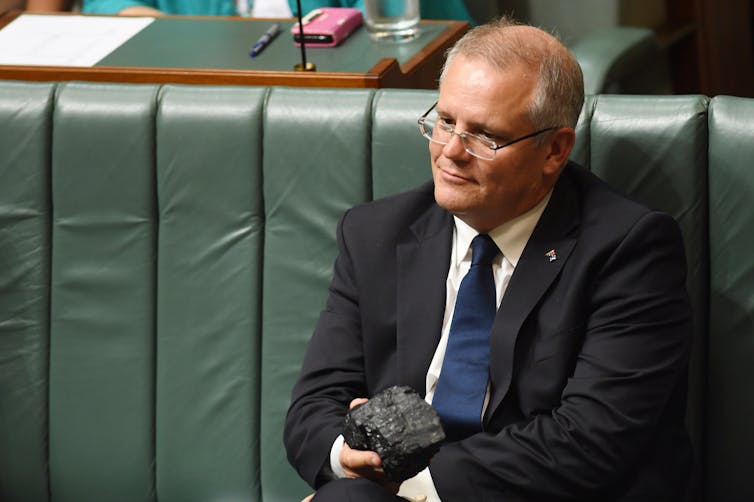
On the surface, Turnbull’s support for a pause on approving new mines while a plan is developed is old-fashioned centrism. It protects existing coal workers from new, highly automated mines, it protects farmers and it should make those concerned with climate change at least a bit happy. Win. Win. Win.
But there’s no room for a sensible centre in the Australian coal debate. And when someone even suggests the industry might not be set to grow, its army of loyal parliamentary and media supporters swing into action.
Labor’s Joel Fitzgibbon said Turnbull “wants to make the Upper Hunter a coal-mine-free zone”. The Nationals’ Matt Canavan suggested stopping coal exports was “an inhumane policy to keep people in poverty”. The head of the NSW Minerals Council suggested 12,000 jobs were at risk.
But of course, the opposite is true. Turnbull’s proposal to protect existing coal workers from competition from new mines would save jobs, not threaten them. He didn’t suggest coal mines be shut down tomorrow, or even early. And, given existing coal mines are running so far below capacity, his call has no potential to impact coal exports.
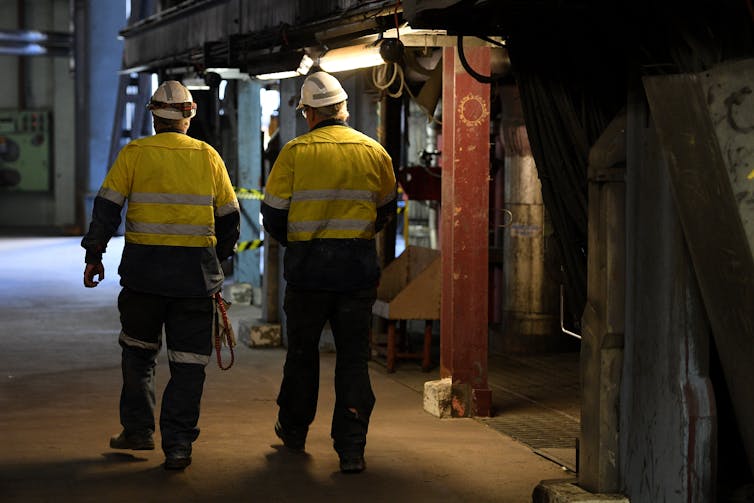
Predictably, the Murdoch press ran a relentlessly misleading campaign in support of the coal industry and in opposition to their least favourite Liberal PM. But surprisingly, the NSW government rolled over in record time.
While the government might think appeasing the coal industry will play well among some older regional voters, they must know such kowtowing is a gift to independents such as Zali Steggall, and a fundamental threat to inner-city Liberals such as Dave Sharma, Jason Falinski and Trent Zimmerman.
The decision to dump Turnbull might have bought NSW Premier Gladys Berejiklian some respite from attacks from the Daily Telegraph. But such denial of economics and climate science will provide no respite for existing coal workers in shuttered coal mines or the agriculture and tourism industry that is looking to expand.
No doubt the National Party are pleased with their latest scalp. But it must be remembered this is the party that last year wanted to wage a war against koalas on behalf of property developers. Such political instincts might help the Nationals fend off the threat from One Nation in regional areas but it does nothing to retain votes in leafy Liberal strongholds that deliver most Liberal seats.
Richard Denniss, Adjunct Professor, Crawford School of Public Policy, Australian National University
This article is republished from The Conversation under a Creative Commons license. Read the original article.
'Failure is not an option': after a lost decade on climate action, the 2020s offer one last chance

In May 2011, almost precisely a decade ago, the government-appointed Climate Commission released its inaugural report. Titled The Critical Decade, the report’s final section warned that to keep global temperature rises to 2℃ this century, “the decade between now and 2020 is critical”.
As the report noted, if greenhouse gas emissions peaked around 2011, the world’s emissions-reduction trajectory would have been easily manageable: net-zero by around 2060, and a maximum emissions reduction rate of 3.7% each year. Delaying the emissions peak by only a decade would require a trebling of this task – a maximum 9% reduction each year.
But, of course, the decade to 2020 did not mark the beginning of the world’s emissions-reduction journey. Global emissions accelerated before dropping marginally under COVID-19 restrictions, then quickly rebounding.
Our new report, released today, shows the immense cost of this inaction. It is now virtually certain Earth will pass the critical 1.5℃ temperature rise this century – most likely in the 2030s. Now, without delay, humanity must focus on holding warming to well below 2℃. For Australia, that means tripling its emissions reduction goal this decade to 75%.

Aim High, Go Fast
The Climate Council report is titled Aim High: Go Fast: Why Emissions Need To Plummet This Decade. It acknowledges the multiple lines of evidence showing it will be virtually impossible to keep average global temperature rise to 1.5℃ or below this century, without a period of significant overshoot and “drawdown”. (This refers to a hypothetical period in which warming exceeds 1.5℃ then cools back down due to the removal of carbon dioxide (CO₂) from the atmosphere.)
The increasing rate of climate change, insights from past climates, and a vanishing carbon budget all suggest the 1.5℃ threshold will in fact be crossed very soon, in the 2030s.
There is no safe level of global warming. Already, at a global average temperature rise of 1.1℃, we’re experiencing more powerful storms, destructive marine and land heatwaves, and a new age of megafires.
Read more: Cyclone Seroja just demolished parts of WA – and our warming world will bring more of the same
As the Intergovernmental Panel on Climate Change has warned, the consequences of breaching 1.5℃ warming will be stark. Heatwaves, droughts, bushfires and intense rain events will become even more severe. Sea levels will rise, species will become extinct and crop yields will fall. Coral reefs, including the Great Barrier Reef, will decline by up to 90%.
And perhaps most frighteningly, overshooting 1.5℃ runs a greater risk of crossing “tipping points”, such as the collapse of ice sheets and the release of natural carbon stores in forests and permafrost. Crossing those thresholds may set off irreversible changes to the global climate system, and destroy critical ecosystems on which life on Earth depends.
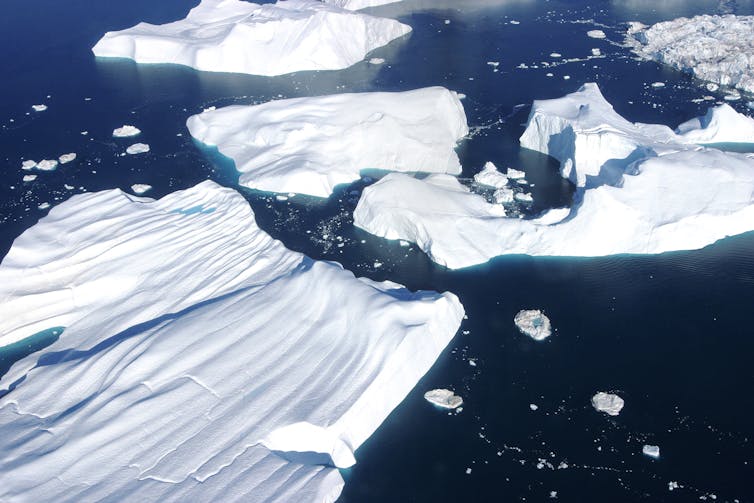
Every Fraction Of A Degree Matters
The outlook may be dire, but every fraction of a degree of avoided warming matters. Its value will be measured in terms of human lives, species and ecosystems saved. We can, and must, limit warming to well below 2℃. The goal is very challenging, but still achievable.
The strategies, technologies and pathways needed to tackle the climate challenge are now emerging as fast as the risks are escalating. And in the lead-up to the COP26 climate conference in Glasgow later this year, there’s widespread momentum for international cooperation and action.
Read more: Seriously ugly: here's how Australia will look if the world heats by 3°C this century
Many of Australia’s strategic allies and major trading partners – including the United States, Europe, the United Kingdom and China – are starting to move on climate change. But Australia is standing still. This is despite our nation being one of the most vulnerable to climate change – and despite us having some of the world’s best renewable energy resources.
We must urgently grab these opportunities. We propose Australia radically scale up its emissions-reduction targets – to a 75% cut by 2030 from 2005 levels (up from the current 26-28% target). Australia should also aim to reach net-zero emissions by 2035. Doing so by 2050 – a goal Prime Minister Scott Morrison says is his preference – is too late.
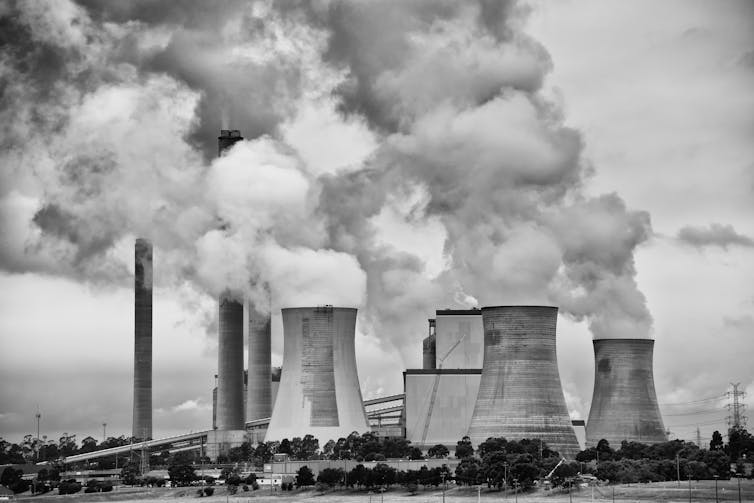
A Huge But Achievable Task
Such dramatic action is clearly daunting. There are political, technical and other challenges ahead because action has been delayed. But a 75% emissions-reduction target is a fair and achievable contribution to the global effort.
Australia’s unrivalled potential for renewable energy means it can transform the electricity sector and beyond. Electric vehicles can lead to carbon-free transport and renewably generated electricity and green hydrogen can decarbonise industry.
The emerging new economy is bringing jobs to regional Australia and building cleaner cities by reducing fossil fuel pollution. There is staggering potential for a massive new industry built on the export to Asia of clean energy and products made from clean hydrogen.
Read more: Scott Morrison has embraced net-zero emissions – now it's time to walk the talk
State, territory and local governments are leading the way in this transformation. The federal government must now join the effort.
The transition will no doubt be disruptive at times, and involve hard decisions. Industries such as coal will disappear and others will emerge. This will bring economic and social change which must be managed sensitively and carefully.
But the long-term benefits of achieving a stable climate far outweigh the short-term disruptions. As our report concludes:
The pathway we choose now will either put us on track for a much brighter future for our children, or lock in escalating risks of dangerous climate change. The decision is ours to make. Failure is not an option.
Climate Council researcher Dr Simon Bradshaw contributed to this article.![]()
Will Steffen, Emeritus Professor, Fenner School of Environment & Society, Australian National University
This article is republished from The Conversation under a Creative Commons license. Read the original article.
Seriously ugly: here's how Australia will look if the world heats by 3°C this century
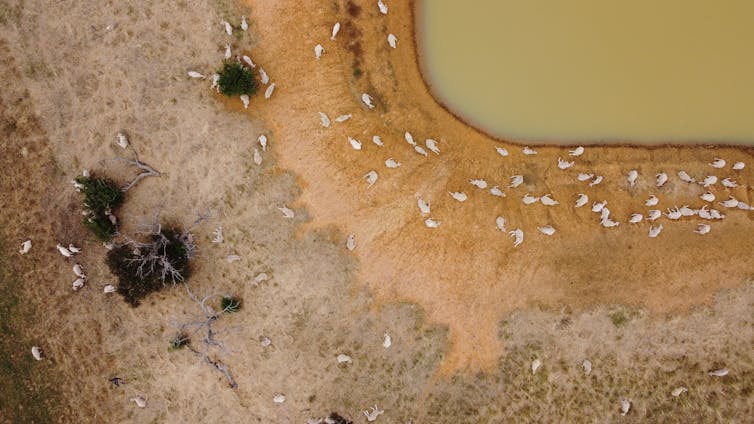
Imagine, for a moment, a different kind of Australia. One where bushfires on the catastrophic scale of Black Summer happen almost every year. One where 50℃ days in Sydney and Melbourne are common. Where storms and flooding have violently reshaped our coastlines, and unique ecosystems have been damaged beyond recognition – including the Great Barrier Reef, which no longer exists.
Frighteningly, this is not an imaginary future dystopia. It’s a scientific projection of Australia under 3℃ of global warming – a future we must both strenuously try to avoid, but also prepare for.
The sum of current commitments under the Paris climate accord puts Earth on track for 3℃ of warming this century. Research released today by the Australian Academy of Science explores this scenario in detail.
The report, which we co-authored with colleagues, lays out the potential damage to Australia. Unless the world changes course and dramatically curbs greenhouse gas emissions, this is how bad it could get.
A Spotlight On The Damage
Nations signed up to the Paris Agreement collectively aim to limit global warming to well below 2℃ this century and to pursue efforts to limit temperature increase to 1.5℃. But on current emissions-reduction pledges, global temperatures are expected to far exceed these goals, reaching 2.9℃ by 2100.
Australia is the driest inhabited continent, and already has a highly variable climate of “droughts and flooding rains”. This is why of all developed nations, Australia has been identified as one of the most vulnerable to climate change.
The damage is already evident. Since records began in 1910, Australia’s average surface temperature has warmed by 1.4℃, and its open ocean areas have warmed by 1℃. Extreme events – such as storms, droughts, bushfires, heatwaves and floods – are becoming more frequent and severe.
Today’s report brings together multiple lines of evidence such as computer modelling, observed changes and historical paleoclimate studies. It gives a picture of the damage that’s already occurred, and what Australia should expect next. It shines a spotlight on four sectors: ecosystems, food production, cities and towns, and health and well-being.
In all these areas, we found the impacts of climate change are profound and accelerating rapidly.
Read more: Yes, Australia is a land of flooding rains. But climate change could be making it worse

1. Ecosystems
Australia’s natural resources are directly linked to our well-being, culture and economic prosperity. Warming and changes in climate have already eroded the services ecosystems provide, and affected thousands of species.
The problems extend to the ocean, which is steadily warming. Heat stress is bleaching and killing corals, and severely damaging crucial habitats such as kelp forests and seagrass meadows. As oceans absorb carbon dioxide (CO₂) from the atmosphere, seawater is reaching record acidity levels, harming marine food webs, fisheries and aquaculture.
At 3℃ of global warming by 2100, oceans are projected to absorb five times more heat than the observed amount accumulated since 1970. Being far more acidic than today, ocean oxygen levels will decline at ever-shallower depths, affecting the distribution and abundance of marine life everywhere. At 1.5-2℃ warming, the complete loss of coral reefs is very likely.
Read more: The oceans are changing too fast for marine life to keep up
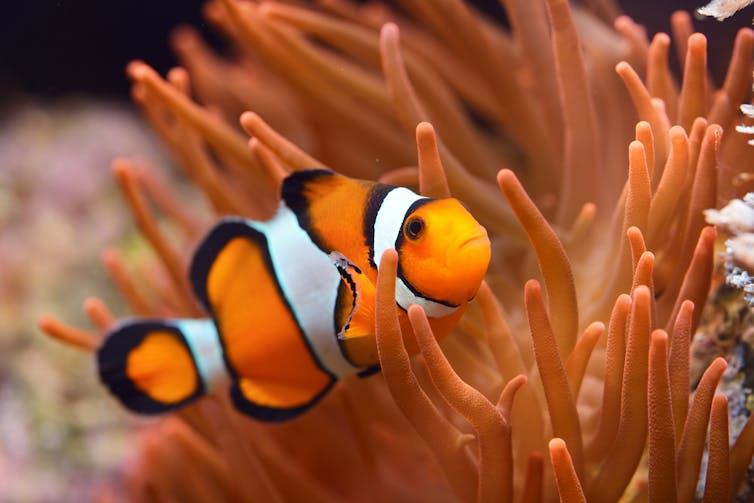
Under 3℃ warming, global sea levels are projected to rise 40-80 centimetres, and by many more metres over coming centuries. Rising sea levels are already inundating low-lying coastal areas, and saltwater is intruding into freshwater wetlands. This leads to coastal erosion that amplifies storm impacts and affects both ecosystems and people.
Land and freshwater environments have been damaged by drought, fire, extreme heatwaves, invasive species and disease. An estimated 3 billion vertebrate animals were killed or displaced in the Black Summer bushfires. Some 24 million hectares burned, including 80% of the Blue Mountains World Heritage Area and 50% of Gondwana rainforests. At 3℃ of warming, the number of extreme fire days could double.
Some species are shifting to cooler latitudes or higher elevations. But most will struggle to keep up with the unprecedented rate of warming. Critical thresholds in many natural systems are likely to be exceeded as global warming reaches 1.5℃. At 2℃ and beyond, we’re likely to see the complete loss of coral reefs, and inundation of iconic ecosystems such as the World Heritage-listed Kakadu National Park.
At 3℃ of global warming, Australia’s present-day ecological systems would be unrecognisable. The first documented climate-related global extinction of a mammal, the Bramble Cay melomys from the Torres Strait, is highly unlikely to be the last. Climate change is predicted to increase extinction rates by several orders of magnitude.
Degradation of Australia’s unique ecosystems will harm the tourism and recreation industries, as well as our food security, health and culture.
There are ways to reduce the climate risk for ecosystems – many of which also benefit humans. For example, preserving and restoring mangroves protects our coasts from storms, increases carbon storage and retains fisheries habitat.
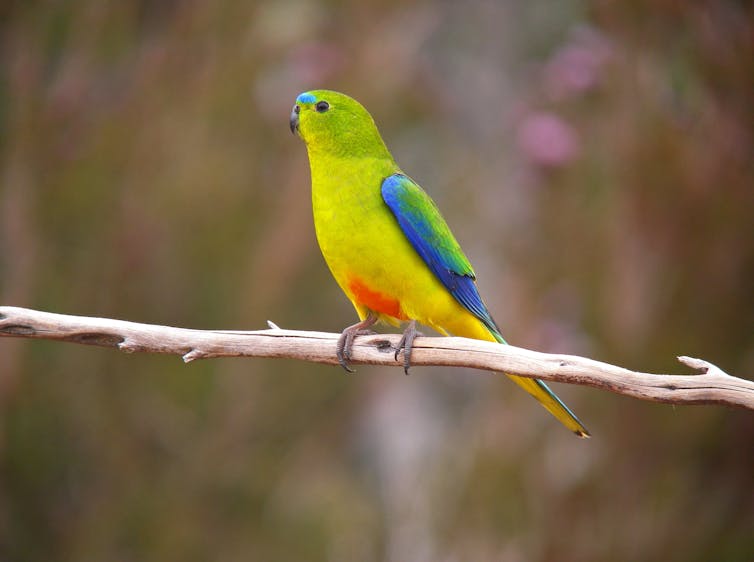
2. Food Production
Australian agriculture and food security already face significant risks from droughts, heatwaves, fires, floods and invasive species. At 2℃ or more of global warming, rainfall will decline and droughts in areas such as southeastern and southwestern Australia will intensify. This will reduce water availability for irrigated agriculture and increase water prices.
Heat stress affects livestock welfare, reproduction and production. Projected temperature and humidity changes suggest livestock will experience many more heat stress days each year. More frequent storms and heavy rainfall are likely to worsen erosion on grazing land and may lead to livestock loss from flooding.
Heat stress and reduced water availability will also make farms less profitable. A 3℃ global temperature increase would reduce yields of key crops by between 5% and 50%. Significant reductions are expected in oil seeds (35%), wheat (18%) and fruits and vegetables (14%).
Climate change also threatens forestry in hotter, drier regions such as southwestern Australia. There, the industry faces increased fire risks, changed rainfall patterns and growing pest populations. In cooler regions such as Tasmania and Gippsland, forestry production may increase as the climate warms. Existing plantations would change substantially under 3℃ warming.
As ocean waters warm, distributions and stock levels of commercial fish species are continuing to change. This will curb profitability. Many aquaculture fisheries may fundamentally change, relocate or cease to exist.
These changes may cause fisheries workers to suffer unemployment, mental health issues (potentially leading to suicides) and other problems. Strategic planning to create new business opportunities in these regions may reduce these risks.
Read more: Australia's farmers want more climate action – and they’re starting in their own (huge) backyards
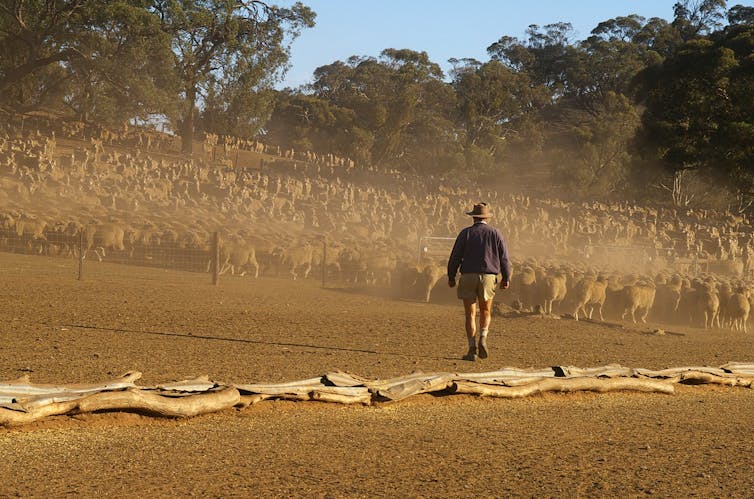
3. Cities And Towns
Almost 90% of Australians live in cities and towns and will experience climate change in urban environments.
Under a sea level rise of 1 metre by the end of the century – a level considered plausible by federal officials – between 160,000 and 250,000 Australian properties and infrastructure are at risk of coastal flooding.
Strategies to manage the risk include less construction in high-risk areas, and protecting coastal land with sea walls, sand dunes and mangroves. But some coastal areas may have to be abandoned.
Extreme heat, bushfires and storms put strain on power stations and infrastructure. At the same time, more energy is needed for increased air conditioning use. Much of Australia’s electricity generation relies on ageing and unreliable coal-fired power stations. Extreme weather can also disrupt and damage the oil and gas industries. Diversifying energy sources and improving infrastructure will be important to ensure reliable energy supplies.
The insurance and financial sector is becoming increasingly aware of climate risk and exposure. Insurance firms face increased claims due to climate-related disasters including floods, cyclones and mega-fires. Under some scenarios, one in every 19 property owners face unaffordable insurance premiums by 2030. A 3℃ world would render many more properties and businesses uninsurable.
Cities and towns, however, can be part of the climate solution. High-density urban living leads to a lower per capita greenhouse gas emission “footprint”. Also, innovative solutions are easier to implement in urban environments.
Passive cooling techniques, such as incorporating more plants and street trees during planning, can reduce city temperatures. But these strategies may require changes to stormwater management and can take time to work.
Read more: When climate change and other emergencies threaten where we live, how will we manage our retreat?
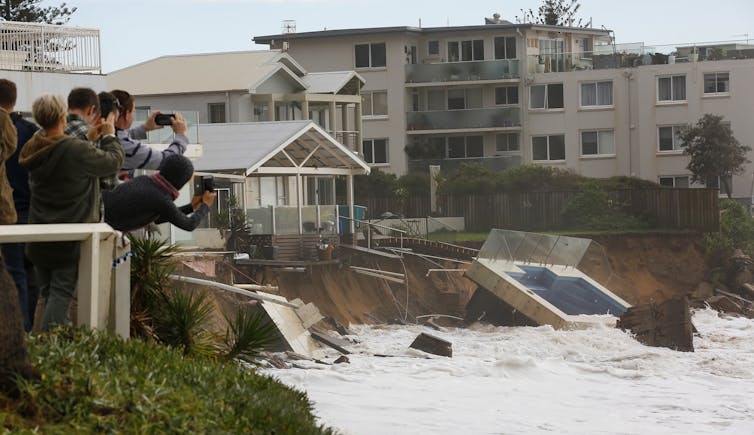
4. Human Health And Well-Being
A 3℃ world threatens human health, livelihoods and communities. The elderly, young, unwell, and those from disadvantaged socioeconomic backgrounds are at most risk.
Heatwaves on land and sea are becoming longer, more frequent and severe. For example, at 3℃ of global warming, heatwaves in Queensland would happen as often as seven times a year, lasting 16 days on average. These cause physiological heat stress and worsen existing medical conditions.
Bushfire-related health impacts are increasing, causing deaths and exacerbating pre-existing conditions such as heart and lung disease. Tragically, we saw this unfold during Black Summer. These extreme conditions will increase at 2℃ and further at 3℃, causing direct and indirect physical and mental health issues.
Under 3℃ warming, climate damage to businesses will likely to lead to increased unemployment and possibly higher suicide rates, mental health issues and health issues relating to heat stress.
At 3°C global warming, many locations in Australia would be very difficult to inhabit due to projected water shortages.
As weather patterns change, transmission of some infectious diseases, such as Ross River virus, will become more intense. “Tropical” diseases may spread to more temperate areas across Australia.
Strategies exist to help mitigate these effects. They include improving early warning systems for extreme weather events and boosting the climate resilience of health services. Nature-based solutions, such as increasing green spaces in urban areas, will also help.
Read more: How does bushfire smoke affect our health? 6 things you need to know
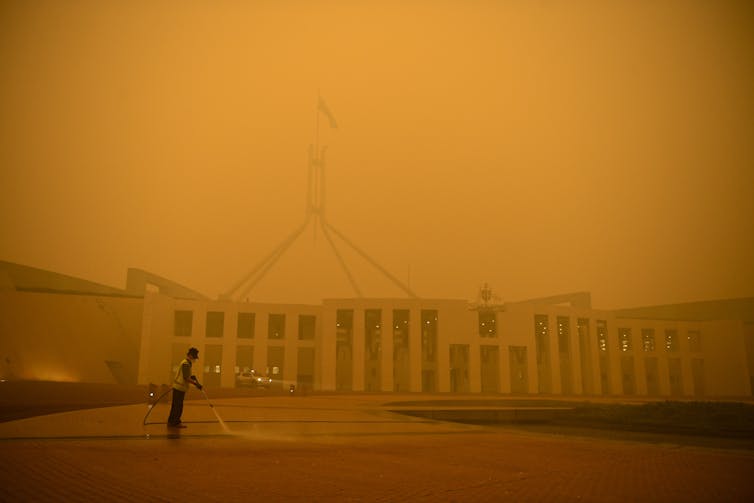
How To Avoid Catastrophe
The report acknowledges that limiting global temperatures to 1.5℃ this century is now extremely difficult. Achieving net-zero global emissions by 2050 is the absolute minimum required to to avoid the worst climate impacts.
Australia is well positioned to contribute to this global challenge. We have a well-developed industrial base, skilled workforce and vast sources of renewable energy.
But Australia must also pursue far more substantial emissions reduction. Under the Paris deal, we’ve pledged to reduce emissions by 26-28% between 2005 and 2030. Given the multiple and accelerating climate threats Australia faces, we must scale up this pledge. We must also display the international leadership and collaboration required to set Earth on a safer climate trajectory.
Our report recommends Australia immediately do the following:
join global leaders in increasing actions to urgently tackle and solve climate change
develop strategies to meet the challenges of extreme events that are increasing in intensity, frequency and scale
improve our understanding of climate impacts, including tipping points and the compounding effects of multiple stressors at global warming of 2℃ or more
systematically explore how food production and supply systems should prepare for climate change
better understand the impacts and risks of climate change for the health of Australians
introduce policies to deliver deep and rapid cuts in emissions across the economy
scale up the development and implementation of low- to zero-emissions technologies
review Australia’s capacity and flexibility to take up innovations and technology breakthroughs for transitioning to a low-emissions future
develop a better understanding of climate solutions through dialogue with Aboriginal and Torres Strait Islander peoples – particularly strategies that helped people manage Australian ecosystems for tens of thousands of years
continue to build adaptation strategies and greater commitment for meeting the challenges of change already in the climate system.
We don’t have much time to avert catastrophe. This decade must be transformational, and one where we choose a safer future.
The report upon which this article is based, The Risks to Australia of a 3°C Warmer World, was authored and reviewed by 21 experts.
Read more: Climate crisis: keeping hope of 1.5°C limit alive is vital to spurring global action ![]()
Ove Hoegh-Guldberg, Professor, The University of Queensland and Lesley Hughes, Professor, Department of Biological Sciences, Macquarie University
This article is republished from The Conversation under a Creative Commons license. Read the original article.
Like the ocean’s ‘gut flora’: we sailed from Antarctica to the equator to learn how bacteria affect ocean health
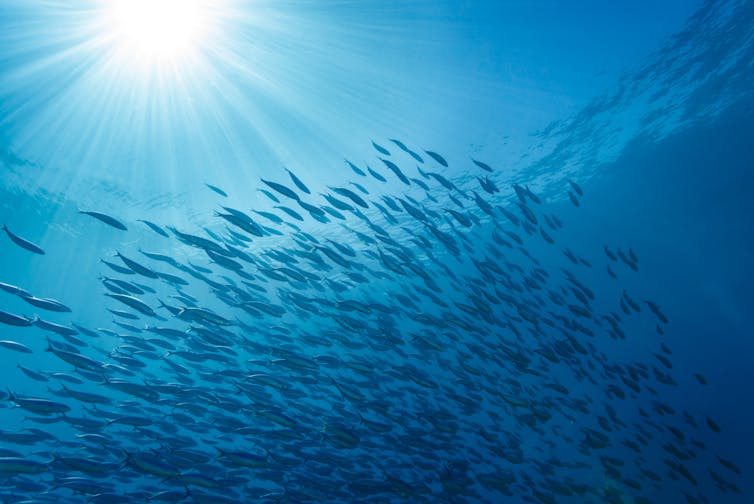
Aboard an Australian research vessel, the RV Investigator, we sailed for 63 days from Antarctica’s ice edge to the warm equator in the South Pacific and collected 387 water samples.
Our goal? To determine how the genetic code of thousands of different micro-organisms can provide insights into the ocean’s functional diversity — the range of tasks performed by bacteria in the ocean.
Our research was published yesterday in Nature Communications. It showed how bacteria can help us measure shifts in energy production at the base of the food web. These results are important, as they highlight an emerging opportunity to use genetic data for large-scale ecosystem assessments in different marine environments.
In light of our rapidly changing climate, this kind of information is critical, as it will allow us to unpack the complexity of nature step by step. Ultimately, it will help us mitigate human pressures to protect and restore our precious marine ecosystems.
Why Should We Care About Marine Bacteria?
The oceans cover 71% of our planet and sustain life on Earth. In the upper 100 meters, the sunlit part of the oceans, microscopic life is abundant. In fact, it’s responsible for producing up to 50% of all the oxygen in the world.
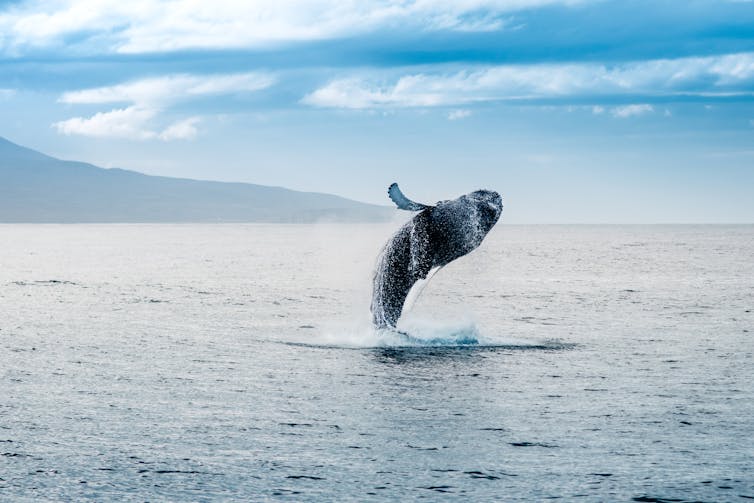
Much like the link recently established between human health and the human microbiome (“gut flora”), ocean health is largely controlled by its bacterial inhabitants.
But the role of bacteria go beyond oxygen production. Bacteria sustain, inject and control the fluxes of energy, nutrients and organic matter in our oceans. They provide the energy and food for the entire marine food web, from tiny crustaceans to fish larvae, whales and the fish we eat.
These micro-organisms also execute key roles in numerous biogeochemical cycles (the carbon, nitrogen, phosphorus, sulphur and iron cycles, to name a few).
So, it’s important to quantify their various tasks and understand how the different bacterial species and their functions respond to environmental changes.
Fundamental Questions
Global ocean research initiatives — such as GO-SHIP and GEOTRACES — have been measuring the state of oceans in expeditions like ours for decades. They survey temperature, salinity, nutrients, trace metals (iron, cobalt and more) and other essential ocean variables.
Only recently, however, have these programs begun measuring biological variables, such as bacterial gene data, in their global sampling expeditions.
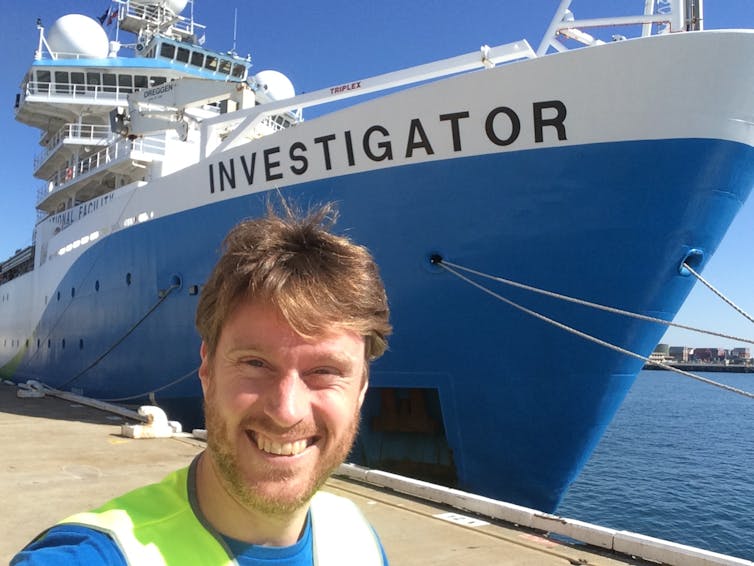
Including bacterial gene data to measure the state of the ocean means we can try to fill critical knowledge gaps about how the diversity of bacteria impacts their various tasks. One hypothesis is whether a greater diversity of bacteria leads to a better resilience in an ecosystem, allowing it to withstand the effects of climate change.
In our paper, we addressed a fundamental question in this global field of marine microbial ecology: what is the relationship between bacterial identity and function? In other words, who is doing what?
What We Found
We showed it’s possible to link the genetic code of marine bacteria to the various functions and tasks they execute, and to quantify how these functions changed from Antarctica to the equator.
The functions that changed include taking in carbon dioxide from the atmosphere, bacterial growth, strategies to cope with limited nutrients, and breaking down organic matter.
Another key finding is that “oceanographic fronts” can act as boundaries within a seemingly uniform ocean, resulting in unique assemblages of bacteria with specific tasks. Oceanographic fronts are distinct water masses defined by, for instance, sharp changes in temperature and salinity. Where the waters meet and mix, there’s high turbulence.
The change we recorded in energy production across the subtropical front, which separates the colder waters from the Southern Ocean from the warmer waters in the tropics, was a clear example of how oceanographic fronts influenced bacterial functions in the ocean.
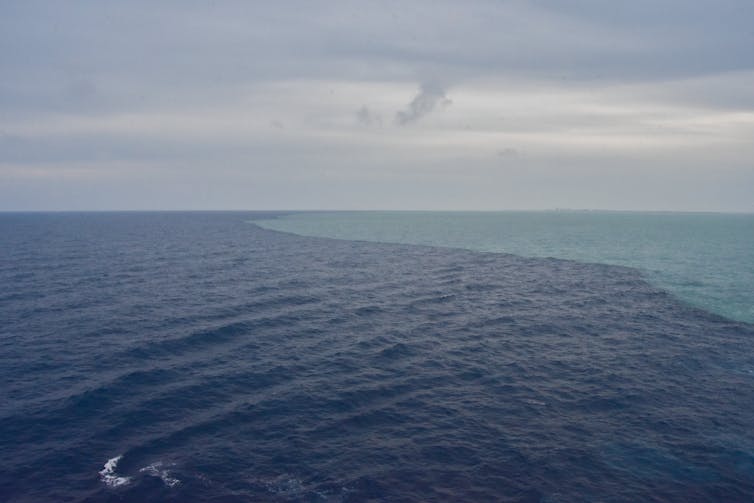
Tracking Changes In Our Ecosystems
As a result of our research, scientists may start using the functional diversity of bacteria as an indicator to track changes in our ecosystems, like canaries in a coal mine.
Read more: Half of global methane emissions come from aquatic ecosystems – much of this is human-made
So the functional diversity of bacteria can be used to measure how human growth and urbanisation impact coastal areas and estuaries.
For example, we can more accurately and holistically measure the environmental footprint of aquaculture pens, which are known to affect water quality by increasing concentrations of nutrients such as carbon, nitrogen and phosphorus – all favourite elements utilised by bacteria.
Likewise, we can track changes in the environmental services rendered by estuaries, such as their important role in removing excessive nitrogen that enters the waterways due to agriculture run-off and urban waste.
With 44% of the world’s population living along coastlines, the input of nitrogen to marine ecosystems, including estuaries, is predicted to increase, putting a strain on the marine life there.
Ultimately, interrogating the bacterial diversity using gene data, along with the opportunity to predict what this microscopic life is or will be doing in future, will help us better understand nature’s complex interactions that sustain life in our oceans.
Eric Jorden Raes, Postdoctoral researcher Ocean Frontier Institute, Dalhousie University
This article is republished from The Conversation under a Creative Commons license. Read the original article.
Marine life is fleeing the equator to cooler waters. History tells us this could trigger a mass extinction event
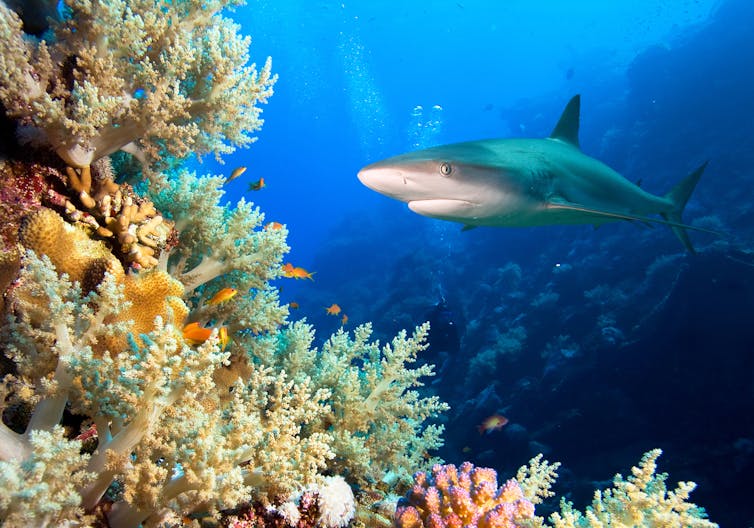
The tropical water at the equator is renowned for having the richest diversity of marine life on Earth, with vibrant coral reefs and large aggregations of tunas, sea turtles, manta rays and whale sharks. The number of marine species naturally tapers off as you head towards the poles.
Ecologists have assumed this global pattern has remained stable over recent centuries — until now. Our recent study found the ocean around the equator has already become too hot for many species to survive, and that global warming is responsible.
In other words, the global pattern is rapidly changing. And as species flee to cooler water towards the poles, it’s likely to have profound implications for marine ecosystems and human livelihoods. When the same thing happened 252 million years ago, 90% of all marine species died.
The Bell Curve Is Warping Dangerously
This global pattern — where the number of species starts lower at the poles and peaks at the equator — results in a bell-shaped gradient of species richness. We looked at distribution records for nearly 50,000 marine species collected since 1955 and found a growing dip over time in this bell shape.
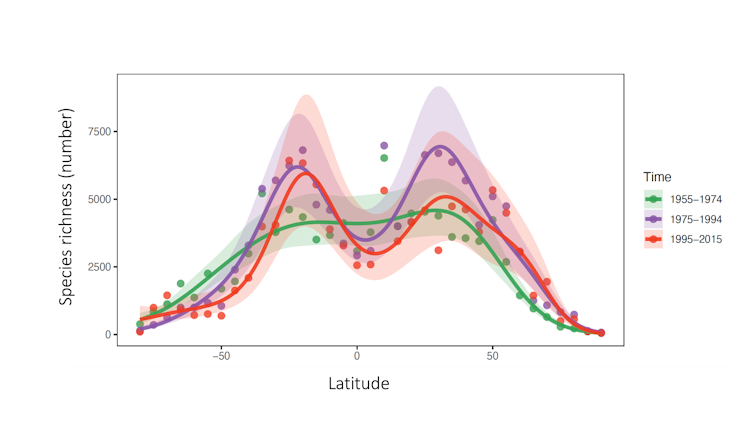
So, as our oceans warm, species have tracked their preferred temperatures by moving towards the poles. Although the warming at the equator of 0.6℃ over the past 50 years is relatively modest compared with warming at higher latitudes, tropical species have to move further to remain in their thermal niche compared with species elsewhere.
As ocean warming has accelerated over recent decades due to climate change, the dip around at the equator has deepened.
We predicted such a change five years ago using a modelling approach, and now we have observational evidence.
Read more: The ocean is becoming more stable – here's why that might not be a good thing
For each of the 10 major groups of species we studied (including pelagic fish, reef fish and molluscs) that live in the water or on the seafloor, their richness either plateaued or declined slightly at latitudes with mean annual sea-surface temperatures above 20℃.
Today, species richness is greatest in the northern hemisphere in latitudes around 30°N (off southern China and Mexico) and in the south around 20°S (off northern Australia and southern Brazil).
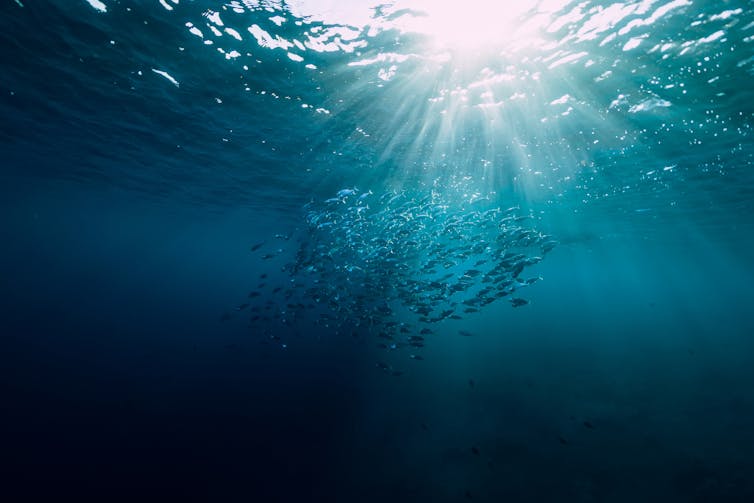
This Has Happened Before
We shouldn’t be surprised global biodiversity has responded so rapidly to global warming. This has happened before, and with dramatic consequences.
252 million years ago…
At the end of the Permian geological period about 252 million years ago, global temperatures warmed by 10℃ over 30,000-60,000 years as a result of greenhouse gas emissions from volcano eruptions in Siberia.
A 2020 study of the fossils from that time shows the pronounced peak in biodiversity at the equator flattened and spread. During this mammoth rearranging of global biodiversity, 90% of all marine species were killed.
125,000 years ago…
A 2012 study showed that more recently, during the rapid warming around 125,000 years ago, there was a similar swift movement of reef corals away from the tropics, as documented in the fossil record. The result was a pattern similar to the one we describe, although there was no associated mass extinction.
Authors of the study suggested their results might foreshadow the effects of our current global warming, ominously warning there could be mass extinctions in the near future as species move into the subtropics, where they might struggle to compete and adapt.
Today…
During the last ice age, which ended around 15,000 years ago, the richness of forams (a type of hard-shelled, single-celled plankton) peaked at the equator and has been dropping there ever since. This is significant as plankton is a keystone species in the foodweb.
Our study shows that decline has accelerated in recent decades due to human-driven climate change.
The Profound Implications
Losing species in tropical ecosystems means ecological resilience to environmental changes is reduced, potentially compromising ecosystem persistence.
In subtropical ecosystems, species richness is increasing. This means there’ll be species invaders, novel predator-prey interactions, and new competitive relationships. For example, tropical fish moving into Sydney Harbour compete with temperate species for food and habitat.
This could result in ecosystem collapse — as was seen at the boundary between the Permian and Triassic periods — in which species go extinct and ecosystem services (such as food supplies) are permanently altered.
The changes we describe will also have profound implications for human livelihoods. For example, many tropical island nations depend on the revenue from tuna fishing fleets through the selling of licenses in their territorial waters. Highly mobile tuna species are likely to move rapidly toward the subtropics, potentially beyond sovereign waters of island nations.
Read more: Tropical fisheries: does limiting international trade protect local people and marine life?
Similarly, many reef species important for artisanal fishers — and highly mobile megafauna such as whale sharks, manta rays and sea turtles that support tourism — are also likely to move toward the subtropics.
The movement of commercial and artisanal fish and marine megafauna could compromise the ability of tropical nations to meet the Sustainable Development Goals concerning zero hunger and marine life.
Is There Anything We Can Do?
One pathway is laid out in the Paris Climate Accords and involves aggressively reducing our emissions. Other opportunities are also emerging that could help safeguard biodiversity and hopefully minimise the worst impacts of it shifting away from the equator.
Currently 2.7% of the ocean is conserved in fully or highly protected reserves. This is well short of the 10% target by 2020 under the UN Convention on Biological Diversity.

But a group of 41 nations is pushing to set a new target of protecting 30% of the ocean by 2030.
This “30 by 30” target could ban seafloor mining and remove fishing in reserves that can destroy habitats and release as much carbon dioxide as global aviation. These measures would remove pressures on biodiversity and promote ecological resilience.
Designing climate-smart reserves could further protect biodiversity from future changes. For example, reserves for marine life could be placed in refugia where the climate will be stable over the foreseeable future.
We now have evidence that climate change is impacting the best-known and strongest global pattern in ecology. We should not delay actions to try to mitigate this.

This story is part of Oceans 21
Our series on the global ocean opened with five in-depth profiles. Look out for new articles on the state of our oceans in the lead-up to the UN’s next climate conference, COP26. The series is brought to you by The Conversation’s international network.
Anthony Richardson, Professor, The University of Queensland; Chhaya Chaudhary, , University of Auckland; David Schoeman, Professor of Global-Change Ecology, University of the Sunshine Coast, and Mark John Costello, Professor, University of Auckland
This article is republished from The Conversation under a Creative Commons license. Read the original article.
Climate change is a security threat the government keeps ignoring. We'll show up empty handed to yet another global summit
Cheryl Durrant, UNSWClimate change is a hot topic in Australian security circles, as it poses an emerging threat to our national resilience and way of life. As a new report from the Australian Strategic Policy Institute (ASPI) last week warned, the federal government is unprepared to meet these challenges.
The report, authored by Dr Robert Glasser, said the government has largely overlooked the security threat posed by rising seas, climate-induced famine, extreme weather events, mass migrations and other climate change damage in Southeast Asia. Australia is sitting on the frontline of this vulnerable region.
Glasser’s report focuses on Southeast Asia, but in the bigger picture, climate security is an existential global risk which the Australian government is yet to fully grasp. It is this global aspect of climate and security which will be on the agenda in two weeks time at the Biden Leaders Summit in the US.
Why Should We Be Worried?
The global risk is broader than traditional security threats, such as the rise of China, terrorism and separatist movements. As the ASPI report emphasises, there is a relationship between climate security and other sectors such as food, health and environmental security.
Unlike traditional national security threats, climate threats have no respect for national or sector borders and cannot be solved with missiles.
The threat is urgent. With the end of the Donald Trump presidency, climate change is back on regional and international security action agendas. The penny has dropped on how little time is left to take action to prepare for the worst of consequences.
This is especially the case when there are long lead times to implement action, such as infrastructure development and military capability development.
ASPI’s key recommendations to the government include:
improving understanding of climate change risks through a broad whole-of-government process
building capacity in government agencies to assess ongoing risks
identifying opportunities for regional aid and investments.
These make sense, as the first step of preparedness is understanding the risk.
Security Risks Go Beyond Natural Disasters
The ASPI report notes Southeast Asia “has the world’s highest sea-level rise per kilometre of coastline and the largest coastal population affected by it”. The region is a hot spot for cyclones, with some nations vulnerable to catastrophic heat or fires.
The ASPI report notes:
Those hazards will not only exacerbate the traditional regional security threats […] but also lead to new threats and the prospect of multiple, simultaneous crises, including food insecurity, population displacement and humanitarian disasters that will greatly test our national capacities, commitments and resilience.
The report focuses on Southeast Asia and natural disasters, but the risks and the affected regions are bigger than that.
The Indo-Pacific region may see the displacement of millions of people due to climate change-related extreme weather events, heatwaves, droughts, rising seas and floods. We’re already seeing this occur in Bangladesh and small island developing states.
We could also see conflict arise as climate change affects global food or water resources. A particular concern is the potential geopolitical tensions between India and China over dwindling Tibetan water resources.
Australia Is Getting Left Behind
Urgency and risk are central to an executive order from President Joe Biden in January. The order requires a US national security estimate on the economic and national security impacts of climate change by June. The US Department of Defence must also complete an analysis of the security implications of climate change in the same timeframe.
Most tellingly, the US is taking an integrated approach to climate security. Foreign policy, defence and economic risk analysis are being conducted in a joined-up, systemic way.
In contrast, the Australian Defence Strategic Update 2020 was conducted in isolation from foreign policy and economic reviews. Taking a narrow military perspective, it does mention climate change, but only once, as a subset of human security threats.
Australia risks being left behind as other countries follow the US lead. Across the Tasman, our Kiwi friends are already well advanced in turning risk awareness into action. The New Zealand government completed its first national climate risk assessment last year, with a national adaptation plan to be completed by August 2022.
What Are The Consequences?
Being left behind has consequences for Australia’s international standing, national resilience and economic position.
From a diplomatic perspective, Australia’s influence in the Indo-Pacific region is diminished, relative to other actors, especially in states where climate change risk is a top priority, such as Vanuatu or Kiribati.
Risks offer opportunities as well. For example, Australia has an abundance of critical minerals and rare earths needed for modern communications, space technologies, and renewable energy generation and transmission. These are key for business, as well as critical for defence forces.
Read more: Critical minerals are vital for renewable energy. We must learn to mine them responsibly
However, processing and manufacturing is largely conducted offshore — in countries vulnerable to climate risks such as Malaysia — before returning to Australia as finished products.
This puts Australian defence and space and energy sectors at risk of disruption, and Australian businesses at risks of economic loss.
What Needs To Happen Next?
ASPI’s report echoes the earlier recommendation from a 2018 Senate inquiry into the implications of climate change for Australia’s national security. The inquiry also called for a coordinated whole-of-government response to climate change risks.
Three years later, the federal government has yet to act on its recommendations.
The Australian government now needs to have a greater sense of urgency to act on the growing national and international calls to act on climate risk. But first, our leaders need a changed mindset. They must accept that climate change is an immediate threat to Australia.
Read more: Senate report: climate change is a clear and present danger to Australia's security ![]()
Cheryl Durrant, Adjunct Associate Professor, UNSW
This article is republished from The Conversation under a Creative Commons license. Read the original article.
New Shorebirds WingThing For Youngsters Available To Download
A Shorebirds WingThing educational brochure for kids (A5) helps children learn about shorebirds, their life and journey. The 2021 revised brochure version was published in February 2021 and is available now. You can download a file copy here.
If you would like a free print copy of this brochure, please send a self-addressed envelope with A$1.10 postage (or larger if you would like it unfolded) affixed to: BirdLife Australia, Shorebird WingThing Request, 2-05Shorebird WingThing/60 Leicester St, Carlton VIC 3053.

 Shorebird Identification Booklet
Shorebird Identification Booklet
The Migratory Shorebird Program has just released the third edition of its hugely popular Shorebird Identification Booklet. The team has thoroughly revised and updated this pocket-sized companion for all shorebird counters and interested birders, with lots of useful information on our most common shorebirds, key identification features, sighting distribution maps and short articles on some of BirdLife’s shorebird activities.
The booklet can be downloaded here in PDF file format: http://www.birdlife.org.au/documents/Shorebird_ID_Booklet_V3.pdf
Paper copies can be ordered as well, see http://www.birdlife.org.au/projects/shorebirds-2020/counter-resources for details.
Download BirdLife Australia's children’s education kit to help them learn more about our wading birdlife
Shorebirds are a group of wading birds that can be found feeding on swamps, tidal mudflats, estuaries, beaches and open country. For many people, shorebirds are just those brown birds feeding a long way out on the mud but they are actually a remarkably diverse collection of birds including stilts, sandpipers, snipe, curlews, godwits, plovers and oystercatchers. Each species is superbly adapted to suit its preferred habitat. The Red-necked Stint is as small as a sparrow, with relatively short legs and bill that it pecks food from the surface of the mud with, whereas the Eastern Curlew is over two feet long with a exceptionally long legs and a massively curved beak that it thrusts deep down into the mud to pull out crabs, worms and other creatures hidden below the surface.
Some shorebirds are fairly drab in plumage, especially when they are visiting Australia in their non-breeding season, but when they migrate to their Arctic nesting grounds, they develop a vibrant flush of bright colours to attract a mate. We have 37 types of shorebirds that annually migrate to Australia on some of the most lengthy and arduous journeys in the animal kingdom, but there are also 18 shorebirds that call Australia home all year round.
What all our shorebirds have in common—be they large or small, seasoned traveller or homebody, brightly coloured or in muted tones—is that each species needs adequate safe areas where they can successfully feed and breed.
The National Shorebird Monitoring Program is managed and supported by BirdLife Australia.
This project is supported by Glenelg Hopkins Catchment Management Authority and Hunter Local Land Services through funding from the Australian Government’s National Landcare Program. Funding from Helen Macpherson Smith Trust and Port Phillip Bay Fund is acknowledged.
The National Shorebird Monitoring Program is made possible with the help of over 1,600 volunteers working in coastal and inland habitats all over Australia.
The National Shorebird Monitoring program (started as the Shorebirds 2020 project initiated to re-invigorate monitoring around Australia) is raising awareness of how incredible shorebirds are, and actively engaging the community to participate in gathering information needed to conserve shorebirds.
In the short term, the destruction of tidal ecosystems will need to be stopped, and our program is designed to strengthen the case for protecting these important habitats.
In the long term, there will be a need to mitigate against the likely effects of climate change on a species that travels across the entire range of latitudes where impacts are likely.
The identification and protection of critical areas for shorebirds will need to continue in order to guard against the potential threats associated with habitats in close proximity to nearly half the human population.
Here in Australia, the place where these birds grow up and spend most of their lives, continued monitoring is necessary to inform the best management practice to maintain shorebird populations.
BirdLife Australia believe that we can help secure a brighter future for these remarkable birds by educating stakeholders, gathering information on how and why shorebird populations are changing, and working to grow the community of people who care about shorebirds.
To find out more visit: http://www.birdlife.org.au/projects/shorebirds-2020/shorebirds-2020-program
Aussie Bread Tags Collection Points

Northern Composure Unplugged 2021: Voting Time!
Watch this year’s Northern Composure Unplugged entrants battle it out online during National Youth Week and vote for your favourite! Performances were filmed live at Glen Street Theatre and each participant had 1 song filmed and recorded.
Public voting has kicked off, sit back and tune into the playlist of the unplugged entrants. Once you're done, please vote for your favourite for the Audience Choice Award.
Vote for your favourite performance by Sunday 25 April 2021, 11:59pm via http://bit.ly/NCU2021
Star Jump This Youth Week
Northern Beaches Council Mayor Michael Regan is supporting the PCYC NSW Star Jump Challenge. Unfortunately Mr. Regan has a foot injury so he put his jumping on hold and instead is taking a star jump stance. Everyone in the PCYC Northern Beaches school holiday program had a lot of fun jumping around him with Star Jump Challenge mascot, Twinkle.
Star Jump every day of Youth Week this April 16 - 24 and raise much needed funds to support PCYC's brand new mental health program!
Join the challenge and sign up to jump or donate at www.starjumpchallenge.org.au
Balgowlah Boys Campus Videographer Wins Inaugural Excelsia & Sydney Film School Award: Congratulations Luke!
Luke O’Donnell, photographer and videographer from Balgowlah Boys Campus - Northern Beaches Secondary College participated in the inaugural short film competition, run through the Excelsia and Sydney Film School.
The Excelsia & Sydney Film School Award is a Scholarship Film Festival for Australian High School Students.
Entrants had to submit a 3 minute short film expressing thematic content around the nature of morality, existence, spirituality, philosophy, reality and truth. His film "Until The End" has won the competition, and a scholarship to study the Bachelor of Screen Production.
Excelsia stated;
'Thank you to all our entrants and the creativity they have expressed through their projects. The team are delighted with the finalists for the inaugural Excelsia & Sydney Film School Award and have the bar set high for following years. We had a mix of narrative, animation, experimental and documentary films among our submissions. The emerging voices we have seen through these films brings exciting energy for the future of our industry.
Congratulations to Luke O'Donnell, the winner of the first Excelsia & Sydney Film School Award for his film 'Until the End'
Luke has written a blurb for his film on his You Tube page which reads;
''This year, I was fortunate enough to participate in a short film competition, run by Excelsia College and Sydney Film school. Entrants had to submit a 3 minute short film expressing thematic content around the nature of morality, existence, spirituality, philosophy, reality and truth. My film "Until The End" was lucky enough to win the competition, and a $60,000 scholarship to study the Bachelor of Screen Production, and I am so glad I can share it with you here :)'
“Until the End” is a film predicated upon a longing for the past. It recalls the fleeting nature of existence within the human experience and seeks to lament the true reality of relationships which often mean so much to us.
The film communicates the inherent desire for the restoration of human relationships, even when this desire may appear to be futile. The different cinematic techniques portray the emotions of the characters, and ultimately their position in the world. Through our identification with the characters, we develop empathy for their struggles, recalling the innocence of youth and its belief in the existence of a universal morality.
More holistically, the film reveals how deeper and more meaningful connections with others add richness and depth to human existence, even if it is fleeting, and attempts to deliver a simple yet meaningful didactic message that, despite the uncertainty concomitant in our relationships with others, human connection is essential to cognitive maturity and through it we grow.''
Cast and Crew:
Written and Directed by Luke O'Donnell
Audio recorded by Kyan Paltoft
"Sophie" played by Nicola Bartholomew
"Tom" played by Gordon Carroll
Congratulations Luke! Everyone here is STOKED for you.
For those who haven't seen it yet:
Avalon Dancer Winner Of Telstra Ballet Dancer Awards: Congratulations Nathan!


AUSSIES Wrap – Day 1 Youth Championships – 16 April
More than 700 young surf life savers from the U14 and U15 age groups gathered from across the country, with Maroochydore and Mooloolaba Beaches hosting the first day of competition.
In the U14’s it was Cooks Hills’ Alexander Walker who had the crowd on their feet, claiming the triple crown with gold in the U14 Ironman, Swim and Board.
“It’s incredible, it is so overwhelming it is such an amazing feeling to have completed the triple,” Walker said.
“The team at Cooks Hill and everyone is just so friendly, and we all work together at training to help each other improve as athletes and it is just a great atmosphere. It was great to come out here today and do it for them,” he said.
In the U15 Male Ironperson Newport's Conner Maggs has commenced his club's campaign with a bang securing silver and then following that up with gold in the U/15 Male Surf Race.

In the U14 Ironwoman final, a close run up the beach saw North Curl Curl’s Dominique Melbourn claim her first Australian gold medal after taking silver earlier in the day in the swim race.
“It’s such an unreal experience and I’m so lucky to have achieved the Australian title,” Dominique said.
“It’s surf and anything can happen, so I wasn’t confident until the end – but once I got down that last wave I got pretty excited.
“The club is really a team environment and we all work together so well, pushing each other through training. But nothing pushes us more than our coach Michael Clues.
“He’s such a determined coach and he just wants the best out of us and as it’s shown so far this weekend he’s definitely done that,” she said.
Former NSW Ironman legend and proud Wanda man Nathan Smith is helping usher through the next generation, with one of the Club’s stars Fletcher Warn taking out the U15 Ironman crown.
“Shout out to Nathan Smith and Greg Pierce for entering all the kids, none of this would have happened without you guys so thank you very much,” Warn said.
“To win it is just incredible. That was one of the scariest moments I have ever been in, I can’t, I pulled up onto the wave and I was like oh no cause I know he could run fast, so I had to get off and just run to get there.”
Jayda Kempton from Burleigh Heads Mowbray Park SLSC won the U15 Female Surf Race, a win that took her a bit by surprise.
“I’m a bit shocked actually – I went in to just have a go and I had no expectations to do as well as I did so I’m super happy,” Kempton said.
In the beach arena at Maroochydore the crowd was on it’s feet for the teams from Coogee, taking out both the U15 Female Beach Relay and the U15 Mixed Beach Relay Aussies titles and a Bronze medal in the U15 Male Beach Relay.
Eden Levitt from Coogee SLSC also took out a Bronze in the U15 Female Sprint and said she had no doubt in her mind that the two Beach Relay teams could get the Gold.
“Definitely two, I trust the relay team a lot, but it’s all experience it’s all new for all of us, there’s a lot to learn and A lot more to go,” Levitt said.
The local crew from Maroochydore took out the U15 Male Beach Relay ahead of Metropolitan Calounrda and Coogee with their coach saying the crew practiced changeovers multiple times to make sure they got it right.
“It’s exceptional for the young lads, they raced their hearts out and in such amazing competition awesome stringing a run together like that,” the Maroochydore coach said.
“The practiced over and over and over on the wrong side, upside down and forward and backwards and they’ve done it.”
The Australian Surf Life Saving Championships will be held on the Sunshine Coast from 16-24 April, with more than 5,900 competitors going head-to-head across three beaches and nine action packed days of competition.
Results
For a full list of today’s results, click here.
Live stream
To watch today’s livestream, featuring the U14 and U15 Surf, Board and Ironperson Finals, click here.
Event Updates
For any updates and changes to schedules and timetables please download the Team App and join – Aussies 2021 to stay up to date with all the latest changes.
For further details about the Aussies and any other information head to – https://sls.com.au/aussies/
Nine New Champions Crowned At The 2021 Billabong Oz Grom Cup
April 11, 2021 at Park Beach, Coff Harbour
Nine new champions were crowned today at the 2021 Billabong Oz Grom Cup pres. by Coopers Surf Australia following a giant day of action in playful two-foot surf.
Lennix Smith (Barrack Point, NSW) wrapped up his final year in the 2021 Billabong Oz Grom Cup pres. by Coopers Surf Australia with a bang, taking out the 16-and-Under Boys division. Smith surfed impeccably over the course of the event, consistently posting mammoth scores for mature manoeuvres and the final was no exception with the Illawarra natural-footer finishing the final with a solid 15.67 two-wave heat total.

Lennix Smith (Barrack Point, NSW) wrapped up his final year in the 2021 Billabong Oz Grom Cup pres. by Coopers Surf Australia with a bang taking out the 16-and-Under Boys division. photo by Ethan Smith / Surfing NSW
Charlotte Mulley (Burleigh Waters, Qld) surfed like a seasoned veteran who had honed their backhand on the long righthanders of the Gold Coast as she claimed victory in the 16-and-Under Girls division. Mulley nailed a chain of massive backhand snaps to finish the heat with a 17.23 two-wave total and take the win ahead of Oceanna Rogers (Shellcove, NSW) who claimed the runner-up position.
Sierra Kerr (USA) capped off a stellar Billabong Oz Grom Cup campaign, taking victory in the 14-and-Under Girls division. Despite a slow start in the final, Kerr was able to maintain composure in the dying moments of the heat and notch up a near-perfect 9.33 wave score for a chain of powerful snaps and carves – that appeared eerily similar to the same style as her Dad (former Championship Tour surfer Josh Kerr) – to jump from third position into the winner’s chair.
Following on Sierra Kerr’s victory, Samuel Lowe (Port Kembla, NSW) became the second child of a former WSL Championship Tour star to take a win. Samuel appeared to channel his father Michael’s performance at the 2004 Quiksilver Pro at Snapper Rocks as he found a handful of beautifully tapered righthanders to post a massive 9.00 wave score and gain the upper-hand against some fancied opposition, including perennial standout Fletcher Kelleher (Freshwater, NSW).
Following the recent Rip Curl Newcastle Cup that wrapped up yesterday, Ocean Lancaster (Newcastle, NSW) made sure he did his best to continue representing Novocastrian surfing abroad, smashing the 12-and-Under Boys division. Lancaster dominated the impressive final, executing a barrage of gigantic snaps and carves to finish the heat with a 17.07 two-wave heat total.

Ocean Lancaster. photo by Ethan Smith / Surfing NSW
Pipi Taylor (Peregian Beach, Qld) did the Sunshine Coast proud as she took out the 12-and-Under Girls division. Taylor posted a respectable 9.10 total to take the win ahead of her fancied opponents.
Lucas Deffenti (Miami, Qld) showed he is a star on the rise as he took out the highly contended 10-and-Under Boys division. Deffenti stood out in the final, effortlessly linking a chain of giant snaps and carves to post a 15.23 two-wave total and earn the top spot on the dais.
Leihani Kaloha Zoric (Byron Bay, NSW) claimed her second Billabong Oz Grom Cup title, taking out the 10-and-Under Girls division. Zoric surfed well beyond her years in the final exchange, nailing an array of beautiful snaps and carves to finish with a giant 16.34 two-wave heat total.
Pheonix Talbot (Yamba, NSW) will be heading back to Yamba with his head held high after an impressive victory in the 8-and-Under Mixed division with a heat total of 10.60. The victory confirmed Talbot’s nous in Coffs beachbreak conditions, with the young up-and-comer taking out the same division in the Woolworths Surfer Groms Comp event back in late 2020.
The prestigious five-day event – now in its eighth year – ran from the 7th – 11th April and catered for over 200 competitors in nine different divisions.
Former champions include 2016 World Junior Champion and current WSL World Championship Tour surfer Macy Callaghan who claimed her respective division in the event’s inaugural year. Since then, the event has been won by a range of Australia’s best and most promising junior surfers.
In addition to all the action in the ocean, the final days of the event were webcast through Surfing NSW’s social channels.
All event presentations were hosted at the Hoey Moey.
Boys and Girls divisions for the event included 8-and-Under Mixed, 10-and-Under, 12-and-Under, 14-and-Under and 16-and-Under.
The Billabong Oz Grom Cup pres. by Coopers Surf Australia is proudly supported by Billabong, Coopers Surf Australia, Coffs Harbour Boardriders, Coffs Harbour City Council, Park Beach Plaza, Hoey Moey and Surfing NSW.

Locana Cullen. photo by Ethan Smith / Surfing NSW
Event results:
16-and-Under Boys
1 – Lennix Smith (Barrack Point, NSW)
2 – Eden Hasson (Port Stephens, NSW)
3 – Ty Richardson (Palm Beach, Qld)
4 – Kyan Falvey (Cabarita, NSW)
16-and-Under Girls
1 – Charlotte Mulley (Burleigh Waters, Qld)
2 – Oceanna Rogers (Shell Cove, NSW)
3 – Holly Wishart (Gerringong, NSW)
4 – Imojen Enfield (Port Macquarie, NSW)
14-and-Under Boys
1 – Samuel Lowe (Port Kembla, NSW)
2 – Fletcher Kelleher (Manly, NSW)
3 – Joshua Marsh (Barrack Point, NSW)
4 – Landen Smales (Peregian Beach, Qld)
14-and-Under Girls
1 – Sierra Kerr (USA)
2 – Shyla Short (Austinmer, NSW)
3 – Juniper Harper (Lennox Head, NSW)
4 – Ruby Trew (Manly, NSW)
12-and-Under Boys
1 – Ocean Lancaster (Newcastle, NSW)
2 – Hunter Anderson (Moffatt Beach, Qld)
3 – Ben Zanatta Creagh (Dee Why, NSW)
4 – Caden Francis (Palm Beach, Qld)
12-and-Under Girls
1 – Pipi Taylor (Peregian Beach, Qld)
2 – Avalon Vowels (Scotts Head, NSW)
3 – Charli Hatley (Currumbin, Qld)
4 – Lucy Darragh (Gerringong, NSW)
10-and-Under Boys
1 – Lucas Deffenti (Miami, Qld)
2 – Locana Cullen (Avalon, NSW)
3 – Luca Martin (Coffs Harbour, NSW)
4 – Jaggar Phillips (Maroubra, NSW)
10-and-Under Girls
1 – Leihani Kaloha Zoric (Byron Bay, NSW)
2 – Talia Tebb (Kincumber, NSW)
3 – Malia Watson (Tweed Heads, NSW)
4 – Henley Smith (Suffolk Park, NSW)
8-and-Under Mixed
1 – Pheonix Talbot (Yamba, NSW)
2 – Sage Lewis (Sandy Beach, NSW)
3 – Jaya Suhendra (Byron Bay, NSW)
4 – Bali Dobson (Byron Bay, NSW)
Phone wet and won't turn on? Here's how to deal with water damage (hint: soaking it in rice won't work)

If you’ve ever gotten your phone wet in the rain, dropped it in water or spilt liquid over it, you’re not alone. One study suggests 25% of smartphone users have damaged their smartphone with water or some other kind of liquid.
Liquid penetrating a smartphone can affect the device in several ways. It could lead to:
- blurry photos, if moisture gets trapped in the camera lens
- muffled audio, or no audio
- liquid droplets under the screen
- an inability to charge
- the rusting of internal parts, or
- a total end to all functionality.
While new phones are advertised as “water resistant”, this doesn’t mean they are waterproof, or totally immune to water. Water resistance just implies the device can handle some exposure to water before substantial damage occurs.
Samsung Australia has long-defended itself against claims it misrepresents the water resistance of its smartphones.
In 2019, the Australian Competition and Consumer Commission (ACCC) took Samsung to Federal Court, alleging false and misleading advertisements had led customers to believe their Galaxy phones would be suitable for:
use in, or exposure to, all types of water (including, for example, oceans and swimming pools).
Samsung Australia subsequently denied warranty claims from customers for damage caused to phones by use in, or exposure to, liquid.
Similarly, last year Apple was fined €10 million (about A$15.5 million) by Italy’s antitrust authority for misleading claims about the water resistance of its phones, and for not covering liquid damage under warranty, despite these claims.
How Resistant Is Your Phone?
The water resistance of phones is rated by an “Ingress Protection” code, commonly called an IP rating. Simply, an electrical device’s IP rating refers to its effectiveness against intrusions from solids and liquids.
The rating includes two numbers. The first demonstrates protection against solids such as dust, while the second indicates resistance to liquids, specifically water.

A phone that has a rating of IP68 has a solid object protection of 6 (full protection from dust, dirt and sand) and a liquid protection of 8 (protected from immersion in water to a depth of more than one metre).
Although, for the latter, manufacturers are responsible for defining the exact depth and time.
The popular iPhone 12 and Samsung Galaxy S21 phones both have a rating of IP68. However, regarding exposure to water, the iPhone 12 has a permissible immersion depth of a maximum of 6m for 30 minutes, whereas the Galaxy 21’s immersion limit is up to 1.5m, also for 30 minutes.
While IP ratings indicate the water-repellent nature of phones, taking most phones for a swim will land you in deep trouble. The salt content in oceans and swimming pools can corrode your device and cost you a hefty replacement.
Moreover, phone manufacturers carry out their IP testing in fresh water and Apple recommends devices not be submerged in liquids of any kind.
Luckily, water resistant phones are generally able to survive smaller liquid volumes, such as from a glass tipping over.
Read more: Screwed over: how Apple and others are making it impossible to get a cheap and easy phone repair
Checking For Liquid Damage
Exposure to water is something manufacturers have in mind when designing phones. Most Apple and Samsung phones come with a liquid contact/damage indicator strip located inside the SIM card tray.
This is used to check for liquid damage that may be causing a device to malfunction. An indicator strip that comes in contact with liquid loses its usual colour and becomes discoloured and smudgy.

A discoloured strip usually renders your phone ineligible for a standard manufacturer warranty.
If you have any of the more recent smartphones from Apple or Samsung, then your device will be able to detect liquid or moisture in its charging port and will warn you with an alert. This notification only goes away once the port is dry.
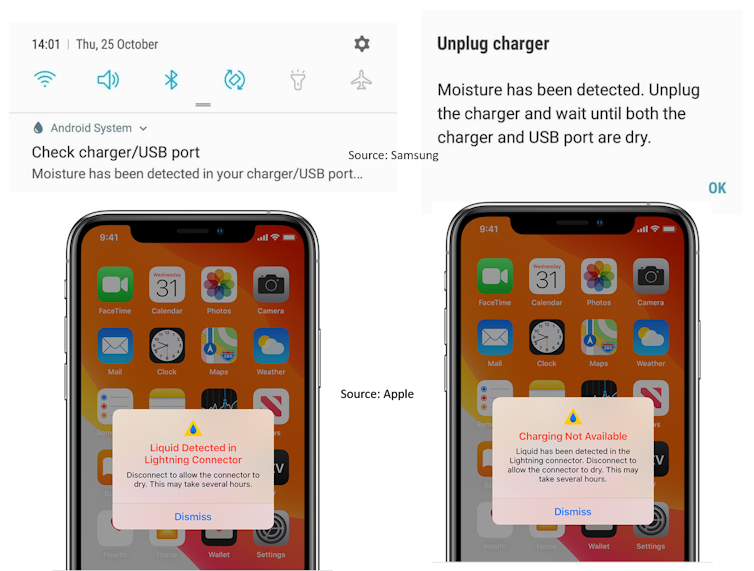
But what should you do if this dreadful pop-up presents itself?
Fixing A Water-Logged Phone
Firstly, do not put your phone in a container of rice. It’s a myth that rice helps in drying out your phone. Instead, follow these steps:
Turn off the device immediately and don’t press any buttons.
If your phone is water resistant and you’ve spilt or submerged it in a liquid other than water, both Apple and Samsung recommend rinsing it off by submerging it in still tap water (but not under a running tap, which could cause damage).
Wipe the phone dry with paper towels or a soft cloth.
Gently shake the device to remove water from the charging ports, but avoid vigorous shaking as this could further spread the liquid inside.
Remove the SIM card.
Use a compressed aerosol air duster to blow the water out if you have one. Avoid using a hot blow dryer as the heat can wreck the rubber seals and damage the screen.
Dry out the phone (and especially the ports) in front of a fan.
Leave your phone in an airtight container full of silica gel packets (those small packets you get inside new shoes and bags), or another drying agent. These help absorb the moisture.
Do not charge the phone until you are certain it’s dry. Charging a device with liquid still inside it, or in the ports, can cause further damage. Apple suggests waiting at least five hours once a phone appears dry before charging it (or until the alert disappears).
If the above steps don’t help and you’re still stuck with a seemingly dead device, don’t try opening the phone yourself. You’re better off taking it to a professional.
Read more: Upgrade rage: why you may have to buy a new device whether you want to or not ![]()
Ritesh Chugh, Senior Lecturer – Information Systems and Analysis, CQUniversity Australia
This article is republished from The Conversation under a Creative Commons license. Read the original article.
'Your government makes us go': the hidden history of Chinese Australian women at a time of anti-Asian immigration laws

Chinese Australian history is primarily told as a history of men. Population figures suggest why — in 1901, there were almost 30,000 Chinese men in Australia, yet fewer than 500 women.
But despite their small numbers, emerging research reveals surprising and inspiring stories of Chinese Australian women’s lives.
Have you ever heard, for example, of Darwin-born Lena Lee — teacher, book-keeper and vice-president of the Chinese Nationalist Party in Darwin in the late 1920s? Or of Gwen Fong — activist, student Communist and doctor, who graduated from Medicine at Melbourne University in 1947?
What happens to our understanding of Australian history when we look at the lives of women like these?
By the turn of the 20th century, the Chinese community was an established, although marginalised, part of Australian society. For more than half a century, migrants from southern China had come to the Australian colonies in pursuit of new opportunities to support themselves and their families.

Almost all of the Chinese who came to colonial Australia were men. Most were labour migrants who came to the colonies to work and send money home — often known as “sojourners”. Over time some established lives and livelihoods in Australia and saw a future for themselves there.
A comparatively small number of wives and children came out to join their husbands, while other men formed local families with white women or Aboriginal women.
Read more: Twelve charts on race and racism in Australia
Barriers To Migration
From the earliest days of Chinese immigration to Australia, Chinese men noted how the difficulties they faced meant that they would not, for the most part, contemplate relocating their families. As well as laws and policies that restricted the rights of Chinese, the day-to-day living conditions in the colonies could be harsh and isolating, particularly in goldmining settlements and rural districts.

“Can it be wondered at?”, asked Louis Ah Mouy, Cheok Hong Cheong and Lowe Kong Meng in their famous 1879 treatise on The Chinese Question in Australia. Since Chinese were treated as “outcasts and pariahs” and “subject to be insulted and assaulted by the ‘larrikins’ of Australia”, why would they bring out their wives and families too?
From the Chinese perspective, there were also strong reasons for women to stay put.
Most Chinese in Australia came from the rural Pearl River Delta region in the southern province of Guangdong. In their home communities, life was centred around the ancestral home and village, and married women took on the role of caring for their parents-in-law, bearing and raising their husband’s children, and tending to the ancestral shrines of their husband’s family.
Few women had the autonomy to migrate overseas except as wife or daughter, or perhaps as a maid servant. The migration of women and girls to Australia mostly therefore took place within the context of the family.

Overlooked, Not Absent
Population figures show the comparatively small numbers of Chinese women in Australia over the 19th and early 20th centuries — but they also show that Chinese women and girls were, in fact, present.
The numbers of Chinese women and girls in Australia grew as the decades passed, through migration and, more significantly, through the birth of daughters on Australian soil.
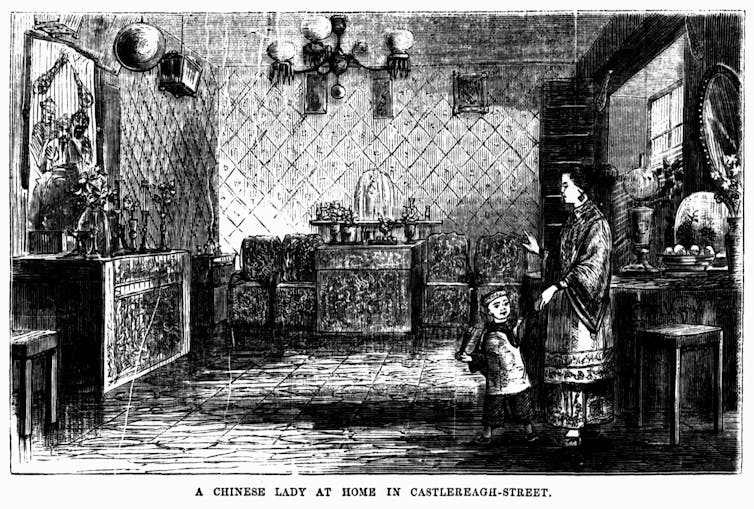
This was despite 19th-century anti-Chinese immigration laws and the continuation of discriminatory measures under the White Australia Policy after 1901. Keeping Chinese women out was central to the maintenance of White Australia. As Prime Minister Alfred Deakin remarked in parliament in 1905:
If we were to throw open the door to an influx of Chinese women and children we should reverse the policy […] and undo all the good we have accomplished.
Read more: Australian politics explainer: the White Australia policy
Researching the lives of Chinese Australian women in the past poses particular challenges, from the seemingly simple task of identifying their names to locating historical sources that tell us about their lives. The fragmentary traces of Chinese Australian women’s lives — particularly those in the 19th century — necessitate a creative approach. We need to use a diverse range of sources — from birth certificates to wedding photographs to interviews with descendants.
Locating Women In The Past

Our new book reveals the surprising, engaging and inspiring stories that emerge when we take the time to look for evidence of Chinese Australian women’s lives.
Ham Hop and Mary Chong are two examples.
Ham Hop was born in c. 1883 and came to Australia as the wife of a Geelong businessman in 1910. The couple had married a decade earlier in China but had lived apart ever since.
Arriving on a temporary permit under the Immigration Restriction Act, Ham Hop became a cause célèbre as her husband fought for her to be allowed to remain in the country permanently.
Despite widespread public support, particularly from the Christian churches, Ham Hop and her two Australian-born daughters left Australia in 1913 on the threat of deportation. Ham Hop was reported to have said on her departure:
It is your Government I don’t like. The people would let us stay. The people are very nice. But your Government makes us go.
Mary Chong, like Ham Hop’s two daughters, was born Australia, in Dubbo in 1908. Mary became the first Chinese woman to graduate from an Australian university (USyd, BA 1929, DipEd 1930). Fluent in English and Cantonese, after graduating she became English Secretary for the Consul General of China in Australia.
Mary’s career then took her to China, where she learnt Mandarin and worked in government and the media in the 1930s and 1940s. Later in life she returned to Australia with her Chinese American husband and their children.
By looking closely at the stories of Chinese Australia women and girls — like Mary Chong, Ham Hop, Gwen Fong and Lena Lee — we learn new things about our nation’s history and about its long connections with China.
We also see how, growing up in and between countries and cultures, Chinese Australian women’s lives were shaped — but not necessarily defined – by social, familial and political forces around them.![]()
Kate Bagnall, Senior Lecturer in Humanities, University of Tasmania and Julia T. Martínez, Associate Professor, University of Wollongong
This article is republished from The Conversation under a Creative Commons license. Read the original article.
'Smell like a woman, not a rose': Chanel No. 5 100 years on, an iconic fragrance born from an orphanage

When Marilyn Monroe was asked, “What do you wear to bed?”, she famously replied, “Just a few drops of No. 5″.
Monroe was perhaps the most famous fan of the French perfume celebrating its 100th birthday next month. Since it was launched by Coco Chanel on May 5, 1921, Chanel No.5 has endured in popularity. Indeed, in 2019 an estimated 1.92 millon women purchased a bottle in Great Britain alone.
Already a successful fashion designer and businesswoman, Chanel became an icon at a time when women were mostly employed in agricultural or domestic duties. She trained as a seamstress, later working as a shop girl and cafe singer, and in 1910, opened her hat shop Chanel Modes at Number 21 rue Cambon, in the centre of Paris.
By 1913, she had opened stores in the resort towns of Deauville and Biarritz, selling hats and a limited line of garments.
Having been raised by nuns in an orphanage, the perfume she went on to create was inspired by their cleanliness and stark simplicity.
Fresh Linens And Yellow Soap
Chanel was born Gabrielle Bonheur Chanel, on August 19, 1883 in Saumur, France. After her mother died, Chanel was sent at the age of 12 to the Abbey of Aubazine Orphanage in Corrèze.
According to her biographers, her company logo, her signature colour of black, her minimalist style and, indeed, the number five (as one story has it, she would cross a series of five paths that led to the cathedral for daily prayer) were all inspired by life in Aubazine.

During the summer of 1920, on holiday on the Cote d'Azur, Chanel learned of a sophisticated perfumer called Ernest Beaux, who had worked for the Russian royal family and lived close by in Grasse, the centre of Europe’s perfume industry.
The fresh linens and the smell of the yellow soap used by girls at the orphanage had left an impression on Chanel. She asked Beaux to create a scent that would make "its wearer smell like a woman, and not a rose”.
Just like the fragrance, Chanel’s perfume bottle was as plain and minimalist “as a laboratory vial”. Since the 1920s, it has only been modified eight times.

Up until the first half of the 20th century, fashion houses were not in the business of creating perfumes, but the launch of Chanel No. 5 inspired many. The English House of Worth launched Dans La Nuit in 1922. In France, Jeanne Lanvin launched My Sin in 1925, and Jean Patou launched Joy in 1930.
Today, couture and fragrances are nearly synonymous, with brands such as Yves Saint Laurent, Karl Lagerfeld, Guy Laroche, Pierre Cardin and Paco Rabanne all making perfume.
Iconic No. 5
An iconic brand has five key elements: it is aspirational, with strong visual identity and persona, it is omnipresent throughout society, and consumers feel a personal connection with it. Chanel No. 5 ticks all these boxes.
Such brands transcend simple purchases. Brand charisma has been described as “sophisticated, iconic and magical” - offering consumers a touch of magic simply through owning the item.
It is, of course, not just the power of the brand that makes No. 5 successful, but also the fragrance itself, with floral scents blended over what has been described as a “warm, woody base”.
Read more: Improving the fragrant harvest
Have you ever experienced the fragrance of Chanel No. 5 in a crowded shopping centre, or at a party, and immediately thought of someone who wore it? Studies have determined a clear link between smell and emotions and memories

For iconic brands, such as Chanel No. 5, it isn’t just the perfume being sold: it is also the history — a history enhanced by the bittersweet quality of nostalgia in the ways our brains link scent and memory.
No.5 And Tomorrow
Coco Chanel’s focus remained on fashion, running Chanel Couture until her death in 1971. In 1924, she had handed control of the distribution and production of all Chanel cosmetics and fragrances to her business partner, the venture capitalist Pierre Wertheimer.
Wertheimer launched the company’s perfume branch, Les Parfums Chanel in that year. It has created many more scents – but none as enduring or popular as Chanel No. 5.
Chanel and Marilyn Monroe weren’t the only faces of the perfume. Celebrities such as Audrey Tautou and Brad Pitt were paid the promote No.5. In 2004, the brand spent US$33 million on a three-minute ad starring Nicole Kidman and directed by Baz Luhrmann — that’s roughly 300,000 bottles of perfume worth.
Today, the company Chanel started as a small hat shop is ranked 52 in the world on Forbes’ list of most valuable brands, valued at US$12.8 billion.
Through it all, No. 5 has lived on.![]()
Gary Mortimer, Professor of Marketing and Consumer Behaviour, Queensland University of Technology and Rebekah Russell-Bennett, Social Marketing Professor, School of Advertising, Marketing and Public Relations, Queensland University of Technology
This article is republished from The Conversation under a Creative Commons license. Read the original article.
The discovery of the lost city of 'the Dazzling Aten' will offer vital clues about domestic and urban life in Ancient Egypt
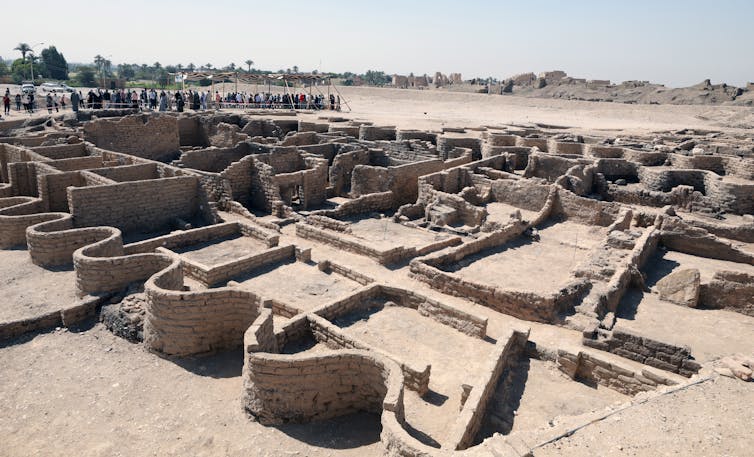
An almost 3,400-year-old industrial, royal metropolis, “the Dazzling Aten”, has been found on the west bank of the Nile near the modern day city of Luxor.
Announced last week by the famed Egyptian archaeologist Dr Zahi Hawass, the find has been compared in importance to the discovery of Tutankhamen’s tomb almost a century earlier.
Built by Amenhotep III and then used by his grandson Tutankhamen, the ruins of the city were an accidental discovery. In September last year, Hawass and his team were searching for a mortuary temple of Tutankhamen.
Instead, hidden under the sands for almost three and a half millennia, they found the Dazzling Aten, believed to be the largest city discovered in Egypt and, importantly, dated to the height of Egyptian civilisation. So far, Hawass’ excavations have unearthed rooms filled with tools and objects of daily life such as pottery and jewellery, a large bakery, kitchens and a cemetery.
The city also includes workshops and industrial, administrative and residential areas, as well as, to date, three palaces.
Ancient Egypt has been called the “civilisation without cities”. What we know about it comes mostly from tombs and temples, whilst other great civilisations of the Bronze Age, such as Mesopotamia, are famous for their great cities.
The Dazzling Aten is extraordinary not only for its size and level of prosperity but also its excellent state of preservation, leading many to call it the “Pompeii of Ancient Egypt”.
The rule of Amenhotep III was one of the wealthiest periods in Egyptian history. This city will be of immeasurable importance to the scholarship of archaeologists and Egyptologists, who for centuries have struggled with understanding the specifics of urban, domestic life in the Pharaonic period.
Foundations Of Urban Life
I teach a university subject on the foundations of urban life, and it always comes as a surprise to my students how little we know about urbanism in ancient Egypt.
The first great cities, and with them the first great civilisations, emerged along the fertile valleys of great rivers in Mesopotamia (modern day Iraq), the Indus Valley (modern day India and Pakistan) and China at the beginning of the Bronze Age, at least 5,000 years ago.
Just like cities today, they provided public infrastructure and roads, and often access to sanitation, education, health care and welfare. Their residents specialised in particular professions, paid taxes and had to obey laws.
But the Nile did not support the urban lifestyle in the same way as the rivers of other great civilisations. It had a reliable flood pattern and thus the second longest river in the world could be easily tamed, allowing for simple methods of irrigation that did not require complex engineering and large groups of workers to maintain. This meant the population didn’t necessarily need to cluster in organised cities.

Excavations of Early Dynastic (c. 3150-2680 BCE) Egyptian cities such as Nagada and Hierakonpolis have provided us with a plethora of information regarding urban life in the early Bronze Age . But they are separated from the Dazzling Aten by some 1,600 years — as long as separates us from the Huns of Attila attacking ancient Rome.
One city closer in age to the Dazzling Aten we do know a little more about is the short-lived capital of Amenhotep’s III son, Akhenaten, known as the “Horizon of the Aten”, or Tell el-Amarna. Amarna was functional for only 14 years (1346-1332 BCE) before being abandoned forever. It was first described by a travelling Jesuit monk in 1714 and has been excavated on and off for the last 100 years.
Very few other Egyptian cities from the Early Dynastic Period (3150 BCE) to the Hellenistic period (following Alexander the Great’s conquest of Egypt in 332 BCE), have been excavated. This means that domestic urban life and urban planning have long been contentious research areas in the study of Pharaonic Egypt.
The scientific community is impatiently waiting for more information to draw comparisons between Akhenaten’s city and the newly discovered capital founded by his father.
The Magnificent Pharaoh
Amenhotep III, also known as Amenhotep the Magnificent, ruled between 1386 and 1349 BCE and was one of the most prosperous rulers in the Egyptian history.
During his reign as the ninth pharaoh of the 18th Dynasty, Egypt achieved the height of its international power, climbing to an unprecedented level of economic prosperity and artistic splendour. His vision of greatness was immortalised in his great capital, which is believed to have been later used by at least Tutankhamen and Ay.
In 2008, for the first time in history, the majority of world’s inhabitants lived in the cities. Yet, with globalisation, the differences between the “liveability” of modern cities are striking.
As a society we need to understand where cities come from, how have they formed and how they shaped the development of past urban communities to learn lessons for the future. We look forward to research and findings being published from the ancient city of Amenhotep III to enlighten us about the daily lives of ancient Egyptians at their height.![]()
Anna M. Kotarba-Morley, Lecturer, Archaeology, Flinders University
This article is republished from The Conversation under a Creative Commons license. Read the original article.
Friday essay: what do the 5 great religions say about the existence of the soul?

A recent survey found almost 70% of Australians believed in or were open to the existence of the soul — meaning they believe we are more than the stuff out of which our bodies are made.
The soul can be defined as the spiritual or non-material part of us that survives death.
Western pop culture is currently bewitched by what happens to us after death with TV shows such as The Good Place and Miracle Workers set largely in the afterlife. And the Disney film Soul depicts the soul of a jazz pianist separating from his earthly body to journey into the afterlife.
Read more: Disney Pixar's Soul: how the moviemakers took Plato's view of existence and added a modern twist
The five great world religions — Judaism, Christianity, Islam, Buddhism, and Hinduism — all believe in some version of a “self”, variously named, which mostly survives death. But they imagine its origin, journey, and destination in some quite different and distinctive ways.
The Origin Of The Soul – Judaism, Christianity, And Islam
These three religions all believe there was a time when souls were not. That is to say, before God created the world, there was nothing at all.
Within Christianity, how the soul was united with its body was a matter of uncertainty. But all were agreed that the soul was present within the foetus, if not at the moment of conception, then within the first 90 days. When it comes to contemporary Christian debate about abortion, this moment is a crucial one. Most Christians today believe the soul enters the body at the time of conception.

Christianity adopted the Greek philosopher Plato’s view that we consist of a mortal body and an immortal soul. Death is thus the separation of the soul from the body.
According to Judaism, the soul was created by God and joined to an earthly body. But it did not develop a definitive theory on the timing or nature of this event (not least because the separation between body and soul was not an absolutely clear one). Modern Judaism remains uncertain on when, between birth and conception, a human being is fully present.
Similarly, in Islam, the soul was breathed into the foetus by God. As in Christianity, opinions vary on when this occurred, but the mainstream opinion has it that the soul enters the foetus around 120 days after conception.
For all three religions, souls will live forever.
The Origin Of The Soul – Hinduism And Buddhism
Within Hinduism, there has been never been a time when souls did not exist. All of us have existed into the infinite past. Thus, we are all bound to Samsara – the infinite cycle of birth, death, and rebirth.

Our souls are continually reincarnated in different physical forms according to the law of karma — a cosmic law of moral debit and credit. Each moral deed, virtuous or otherwise, leaves its mark on the individual. At the time of death, the sum total of karma determines our status in the next life.
Like Hinduism, Buddhism accepts there was no time when we were not bound to the cycle of birth and rebirth. But unlike Hinduism, it does not believe there is an eternal, unchanging “soul” that transmigrates from one life to the next. There is nothing permanent in us, any more than there is any permanence in the world generally.
Nevertheless, Buddhists believe our consciousness is like a flame on the candle of our body. At the moment of death, we leave the body but this flame, particularly our flame of moral credit or debit, goes into a new body. In Buddhism, this “karmic flame of consciousness” plays the same role as the “soul” in other religions.

The Destiny Of The Soul – Judaism, Christianity, And Islam
Within Christianity, it is believed the soul continues its existence immediately after death. Most believe it will do so consciously (rather than in a sleep-like state). At the point of death, God will determine the soul’s ultimate fate — eternal punishment or eternal happiness.
Still, by the end of the first millennium, there was a recognition that most of us had not been sufficiently good to merit immediate happiness, nor sufficiently evil to merit eternal misery. Catholicism thus developed an intermediate state — purgatory — offering the slightly or moderately wicked a chance to be purified of their sins. All souls will be reunited with their resurrected bodies on Judgement Day when Christ returns and God finally confirms their destiny.

Judaism remains uncertain about the consciousness of the dead in the afterlife, although the dominant view holds that, after death, the soul will be in a conscious state.
Orthodox Judaism is committed to the idea of the resurrection of the body on Judgement Day and its reunion with the soul, together with heavenly bliss for the saved. Liberal forms of modern Judaism, like modern liberal Christianity, sit lightly on the idea of the resurrection of the body and emphasise spiritual life immediately after death.

Within Islam, souls await the day of resurrection in their graves. It is a limbo-like state: those destined for hell will suffer in their graves; those destined for heaven will wait peacefully.
There are two exceptions to this: those who die fighting in the cause of Islam go immediately into God’s presence; those who die as enemies of Islam go straight to hell.
On the final Day of Judgement, Muslims believe the wicked will suffer torments in hell. The righteous will enjoy the pleasures of Paradise.
The Destiny Of The Soul – Hinduism
In the modern West, reincarnation has a positive flavour as a desirable alternative to the traditional Western afterlife. But the Indian traditions all agree it is the ultimate horror — their aim is to escape from it.
They do, however, differ radically in their views of the destiny of the soul beyond the eternal cycle of birth, death, and rebirth. Within Hinduism, we can distinguish four different schools of thought on this.
In the first of these, known as Samkhya-Yoga, the aim is to realise the essential separateness of the soul from its material body, thus enabling us to live in the here and now without attachment to the things of the world. At death, the liberated soul will exist eternally beyond any further entanglements with the world. Modern Western postural yoga derives from this, although it is intended, not so much to remove us from the world, as to enable us the better to function within it.
The second view, known as the Dvaita Vedanta school, is completely focused on the soul’s loving devotion to God, which will help liberate souls beyond death. As George Harrison sang, by chanting the names of the Lord (Krishna and Rama) “you’ll be free”. This is the dominant philosophy underlying the Hare Krishna movement and of all the Indian traditions, most closely resembles Christianity.
The third view is that of the Vishishtadvaita Vedanta school. Here, liberation occurs when the soul enters into the oneness of God, rather as a drop of water merges into the ocean, while paradoxically maintaining its individual identity.
The final view of the destiny of the soul within Hinduism is that of the Advaita Vedanta school. Liberation is attained when the soul realises its essential identity with Brahman — the impersonal Godhead beyond the gods.
The Destiny Of The Karmic Flame – Buddhism
Although there are divinities galore in Buddhism, the gods are not essential for liberation. So, it is possible to be a Buddhist atheist. Liberation from endless rebirth comes from our realisation that all is suffering and nothing is permanent, including the self.
In Theravada Buddhism (present in Sri Lanka, Thailand, Cambodia, Myanmar, and Laos), the realised person enters Pari-Nirvana at death. The flame of consciousness is “extinguished”. The “soul” is no more.
In Mahayana Buddhism (in Japan, Vietnam and China, including Tibet)), liberation is attained when the world is seen as it really is, with the veil of ignorance removed — as having no ultimate reality. This means that, although at one level the many gods, goddesses, Buddhas, and Bodhisattvas can assist us on the path to liberation, they too, like us, have never really existed.
At the everyday level, we can distinguish between truth and falsity. But from the perspective of what is ultimately real, there is only Emptiness or Pure Consciousness. Liberation consists of coming to know that the idea of the individual soul was always an illusory one. In short, the individual soul never really was. It was part of the grand illusion that is the realm of Samsara.

The practice of Buddhist “mindfulness”, now becoming popular in the West in a secular form, is the continual attentiveness to the impermanence or unreality of the self and the world, and the suffering caused by thinking and acting otherwise.
The Meaning Of The Soul
Within the Christian tradition, the idea that each individual was both mortal body and immortal soul distinguished humans from other creatures.
It made humanity qualitatively unique; ensuring the life of each individual soul had an ultimate meaning within the grand, divine scheme. However, even without a belief in the transcendent, atheistic humanists and existentialists still affirm the distinct value of each human person.
The question of souls is still one that matters. It is, in effect, wrestling with the meaning of human life — and whether each of us has more ultimate significance than a rock or an earthworm.
This is why the belief in souls persists, even in this apparently secular age.![]()
Philip C. Almond, Emeritus Professor in the History of Religious Thought, The University of Queensland
This article is republished from The Conversation under a Creative Commons license. Read the original article.
How to actually fix a lost voice, according to science (hint: lemon and honey doesn't work)

Losing our voice, having a hoarse voice, or having any difficulties with our voice can be challenging, especially for those who need to use it for work.
For centuries, and across different cultures, people have believed home remedies to be a handy solution for different illnesses. Losing our voice isn’t an exception.
Websites abound with proposed solutions including ginger, lemon, salt water gargles, and tea with honey.
However, put simply, there’s no evidence these home remedies work to recover a lost voice. And there’s a dearth of information out there on what actually works for treating voice issues.
As a speech pathologist and lecturer in voice disorders, I help people with voice issues every day. Here’s what actually helps you recover a lost voice.
Read more: Curious Kids: why might you wake up without a voice?
Why Have I Lost My Voice?
Research suggests up to 30% of us will develop some form of voice disorder in our lifetimes.
There are many reasons we can develop problems with our voice. Voice quality issues can be brought on by viral infections, overuse or misuse of our voice, damage to the vocal folds, or nodules and polyps which are benign, noncancerous growths than can form on the vocal folds.
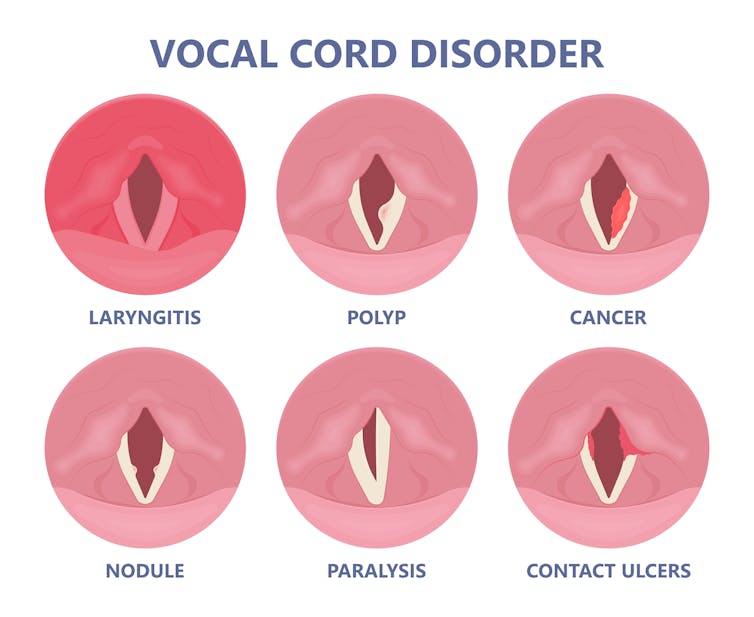
Some people such as teachers, singers, actors, clergy and lawyers are at a greater risk of developing voice difficulties. This is because they talk a lot for a living, often very loudly.
More often than not, what you might call “losing your voice” is the result of laryngitis, which is inflammation of the voice box (larynx). It’s often caused by a virus or overuse, and will tend to resolve in a couple of weeks.
Most Home Remedies Don’t Work For Your Voice
Home remedies like salt water gargles and tea with honey are mostly harmless, although there’s no evidence they work for fixing laryngitis. If you have a sore throat, they might temporarily alleviate some of this pain. But they definitely won’t reduce the roughness, hoarseness or “breathiness” of your voice.
These remedies can’t improve our voice because our vocal folds are protected by the epiglottis, so when swallowing tea or honey (or anything!), the epiglottis comes down and covers the vocal folds. The epiglottis also prevents food and drink from entering our lungs. Nothing should have direct contact with your vocal folds — if something did, it could get into the lungs and cause aspiration and pneumonia.
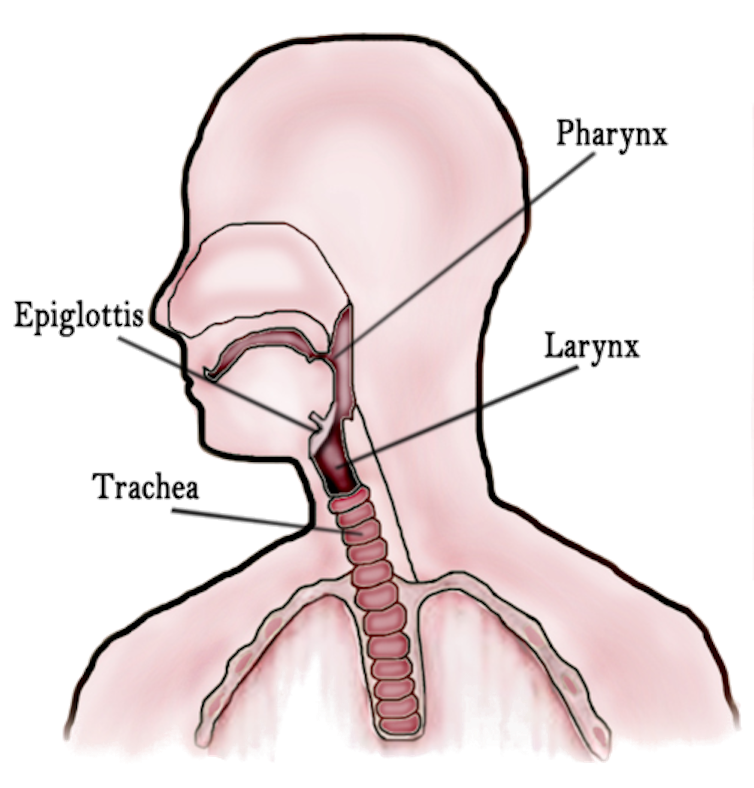
One thing to beware, especially if you have a reflux disorder, is consuming excessive amounts of tea and lemon. Lemon is acidic, and so are some teas, so having a lot of them could actually lead to acid reflux coming up the oesophagus and irritating your throat and vocal folds.
Read more: Explainer: what is gastric reflux?
What’s more, if you’re using home remedies, you might delay seeking professional medical attention, for example from a speech pathologist or an ear, nose and throat specialist (ENT). Delaying treatment could have further negative consequences if your voice issues are due to something more sinister than a cold or flu.
If your voice takes more than a week or two to recover, or you’re worried about your voice, it’s good to seek medical advice. Make sure to visit your GP at first, who may recommend a speech pathologist or ENT specialist.
So What Does Work For A Lost Voice?
Research suggests using a humidifier might be an effective option. This can help by keeping vocal folds hydrated, helping with the vibration of the vocal folds and therefore reducing roughness and hoarseness. Because the tiny water droplets in humidified air are inhaled rather than swallowed, they can bypass the epiglottis and have direct contact with our vocal folds.
Drinking lots of water can also benefit our vocal folds. Even though water doesn’t have direct contact with our voice box, it hydrates the cells in our body.

You should also rest your voice, although it depends on what’s causing your symptoms. In a case of acute laryngitis caused by an infection, your doctor might suggest you completely rest your voice. Similarly, if you’ve had trauma or surgery to your voice box, your doctor might suggest refraining from talking at all for a certain period.
But some ENTs won’t recommend completely resting your voice in other instances. For some voice disorders, your specialist might recommend you start doing voice exercises. One example is “straw phonation”, where you put a straw into a glass of water and speak through it in various ways, depending on the desired outcomes of the treatment.
If you have a hoarse voice but cannot rest it, it’s better to talk at a low volume in a consistent tone — but don’t whisper! Whispering too much can put more strain on your voice box than regular speech.
So if you lose your voice, don’t forget: drink lots of water, use a humidifier if you can, rest your voice, and don’t worry about gargling salt water or drinking lemon and honey tea.![]()
Sandra Rojas, Speech pathologist and Lecturer in Voice Disorders, Department of Speech Pathology, Orthopedics & Audiology, La Trobe University
This article is republished from The Conversation under a Creative Commons license. Read the original article.
Woodland Babies – Special Scenes Of Six Bird Species In The Capertee Valley
Published April 12, 2021 by BIBY TV
These delightful woodland “babies” (aka fledglings or juveniles) of the species Jacky Winter (Microeca fascinans), Restless Flycatcher (Myiagra inquieta), Hooded Robin (Melanodryas cucullata), White-winged Chough (Corcorax melanorhamphos), Noisy Friarbird (Philemon corniculatus) and Speckled Warbler (Pyrrholaemus sagittatus) were filmed during three visits (late November 2020, early January 2021 and early February 2021) to the stunning Capertee Valley (NSW). This geological marvel is not only Australia’s largest enclosed valley or canyon (in fact, widest in the world), it is also recognised internationally as an Important Bird Area (IBA). Fragmented or remnant Box Gum Woodland (an EEC - Endangered Ecological Community) and adjoining wilderness areas provide refuge for several threatened or declining bird species. Moreover, decades of tree-planting (largely for the critically endangered Regent Honeyeater) has extended or recreated woodland vegetation on various (often covenanted) private properties.
The filming site is one such property and one of the first in the planting program. As such, it is reaping the benefits of maturing planted trees (1995 – 2013), original woodland and open forest bordering Wollemi National Park, a magnificent old paddock tree (Yellow Box) looming over its offspring, remnant stands (e.g. on a small hill) and natural regrowth of trees, shrubs and native grasses in once denuded paddocks. The retention of standing and fallen dead timber also contributes to habitat quality. Many BIBY TV productions showcase the success of this revegetation (enter “Capertee Valley” into the search function on this channel). Again, this video is just a small window onto the way birds survive and thrive at this location. It’s particularly heartening to observe that the six species here (and many others) forage and nest in both existing and restored woodland (and often in transition zones, such as the lightly-timbered house area). The opening photo and scene at the 3.14 mark give a glimpse of relatively natural woodland, while the final photo reveals a regeneration area.
Except for the Speckled Warbler section, the footage includes parent(s) and/or carers (in the case of the communal breeders, White-winged Choughs). The starring “babies” range from recently fledged (see early Jacky Winter scenes, White-winged Chough and Noisy Friarbird) to an older juvenile that closely resembles its parents (i.e. Speckled Warbler). Most of the families had two visible offspring; only the Speckled Warbler and Noisy Friarbird seemed to be without a sibling. Five out of six families were filmed across one to three days during a specific visit (i.e. late Nov for choughs, early Feb for warbler, and early Jan for robins, flycatchers and friarbirds). Only the Jacky Winter section includes “follow-up” footage (i.e. early Jan and early Feb). We are quite sure it’s the same family because of the short walking distance between the second filming location and the nesting/fledging area. We can though happily report sightings of older juveniles of other species in subsequent months. Given the “Vulnerable” status of Hooded Robins in NSW, it was especially cheering to see at least one of the youngsters in March 2021.
Credits: Bird footage and editing – Darren Broughton; Landscapes and text – Thalia Broughton
Twelve Aged Care Consumer Peaks Propose Aged Care Reform Plan
- Immediately increase home care and home support funding; ensure a maximum 30-day wait period for home care by no later than December 2022; and implement a single Care at Home program that provides individualized care by 2023.
- Require providers to publish real-time data on staffing, quality performance, financial information, and consumer experience.
- Abolish the Aged Care Approvals Round/bed licenses and give older people control of their residential care funding and put some competitive pressure on poor providers.
- Establish an Independent Pricing Authority just for aged care.
- Initiate a program of independent Care Finders to help navigate aged care, better information and more advocacy services.
- Develop a comprehensive workforce development plan to ensure we have the right numbers and mix of better paid, better skilled, consumer-focused and continuously improving workers.
- Provide much greater support for family and friend Carers including a major increase in accessible respite care and a network of Carer Hubs,
- Require a commitment to respecting diversity throughout aged care - in standards, in training, in accountability and in access pathways and service design, inclusive of Aboriginal and Torres Strait Islander, CALD, LGBTI and rural communities and people living with dementia, with a mandatory Diversity Framework and Action Plans.
- Provide equitable access to health services including dental care, medication reviews, mental health services, allied health, and restorative care and reablement.
- Legislate a commitment to ensuring the lived experience of older people using care services is given real weight in accreditation, reviews, quality measurement, recruitment and every aspect of the aged care system.
- Develop a funding model that grows with needs and ensures sufficient taxpayer funding, balanced with consumer contributions that are fair, sustainable and simple to understand and administer.
- Commit to a timetable detailing when reforms will be commenced and implemented, and to codesigning them with older Australians.
Profound Loss Of Pleasure Related To Early-Onset Dementia
Better Housing Campaign
Glasscraft: Artisans Of Australia
Design makes a place a prison or a home. Turning 'human-centred' vision for aged care into reality
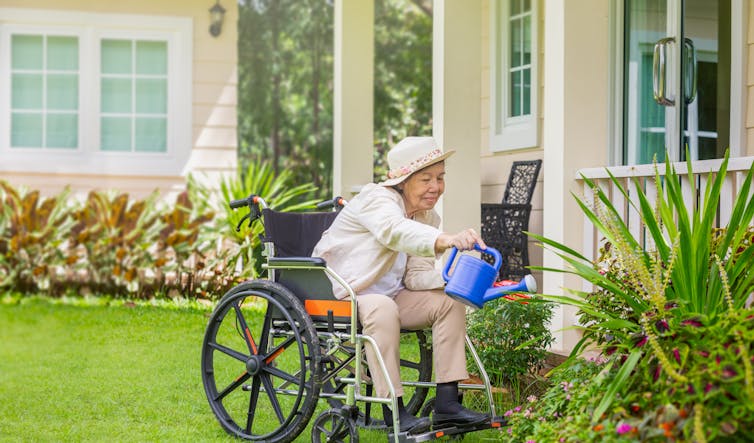
The Royal Commission into Aged Care left organisations that provide housing for aged care wondering how they will put its recommendations into effect. Most of these recommendations relate to the models of care and levels of staffing in homes. Put simply, in the architectural rabbit warrens that typify aged-care facilities, there can never be enough staff to manage every nook.
Models of care are also difficult to change when the architecture is obsolete. Yet these difficulties aren’t detailed in the report. It barely mentions architecture. Only two of the 148 recommendations relate specifically to architecture, numbers 45 and 46: to improve the design of residential care accommodation; and to provide “small household” models of accommodation.
But don’t be mistaken. Architecture has a profound impact on how we live our lives, work and respond socially.
Read more: 4 key takeaways from the aged care royal commission's final report
If architects are able to work with some basic design rules – to design to a vision, with simplicity and a non-institutional design language – architecture can play a role in implementing the bulk of the recommendations. But, if the importance of design is neglected, obsolete architectural models will undermine the best efforts to reform the models of care.
We Can Design To Remove Restraint
Architecture is a critical element of “embedding a human rights-based and human-centred approach to care”, the focus of chapter 3 of the royal commission’s report. To understand the relationship between architecture and human rights, consider how human rights are taken away: look at prisons, detention centres, mental health facilities and even the residences where we care for our elderly citizens. Invariably, it’s architecture that stifles the freedom of movement, the dignity, the freedom of association, choice and other rights.
Read more: The bad buildings scream – lessons from Don Dale and other failed institutions
The commission estimates architectural solutions to seclusion and other forms of physical restraint are used on 25-50% of all residents of high-care residences. These restraints can look innocuous – including “seating residents in chairs with deep seats, or rockers and recliners, that the resident cannot stand up from”. But for residents who can’t get up on their own, deep seats restrict their freedom of movement and ability to make their own choices about as much as handcuffs do.

The forms of restraint (including in high-care aged-care residences) are increasingly disguised, but a locked door remains impenetrable even if it’s made of clear glass. Along with fences and high walls, such features are designed to keep some people in and others out.
Read more: Retire the retirement village – the wall and what’s behind it is so 2020
Or We Can Design For Quality Of Life
If people fail to see how the design of a prison is the primary instrument for imprisonment, then it’s also hard to comprehend just how much good architecture improves people’s circumstances and well-being. But a well-designed aged-care building is replete with wholesome invitations to do such things as explore gardens without putting residents at undue risk.
In turn, spending time outdoors helps prevent “sundowning” – people with dementia may become more confused, restless or insecure late in the afternoon or early evening. It also improves the resident’s experience (personal well-being and satisfaction). Recent unpublished data (in review) shows time outdoors even protects against viral flu-like infections.
And that’s just one example of the benefits of good design. All good architectural choices have similarly positive effects.
3 Principles For Human-Centred Design In Aged Care
Principle 1: projects are driven by a vision that maintains and enables human dignity, even for people with cognitive impairment.
A vision includes a single, well-articulated concept that cannot be dismissed or ignored. The vision creates a hierarchy in which important things are valued more than anything else. A vision that makes human dignity a priority ensures other functional or pragmatic concerns do not lead to human rights being deprioritised.
A good vision isn’t just words or intentions. It involves concrete decisions that are armed with bravery and honesty. Bravery because a good vision always aspires beyond known benchmarks and guidelines. Honesty, because a good vision isn’t shy about speaking the truth.
The diagram below shows an example of a vision in which high-care aged-care residences were to be incorporated into a new precinct for the University of Wollongong. The vision prioritised human centredness – a human-centred workplace, a student-centred learning environment, patient-centred aged-care residences and a person-centred environment overall.
The above vision led to this conceptual diagram.
The conceptual diagram was developed as a masterplan.
In this concept, the educational, residential (non-aged-care) and health facilities make natural walls around a shared village. Car-free streets, cafes, shops, parklands and a distributed residential aged-care facility create a pleasant and safe environment for everybody. The exterior buildings are accessible from both sides for students and staff, but not for high-care residents unless they are accompanied.
Read more: Aged care isn't working, but we can create neighbourhoods to support healthy ageing in place
Principle 2: keep it simple.
As cognitive abilities decline, this reduces people’s capacity to deal with complexity. So keep design simple, with destinations that are visible and clear.
Think about turning all bedrooms inwards to provide immediate access to common spaces, activities and gardens. The reception, all offices and commercial facilities can face outwards, and be invisible to residents.
Simplifying the layout also aids staff. Hidden spaces and doors to unsafe places cause anxiety for residents and staff alike, adding to the staffing burden.
Simple design doesn’t mean plain. It means keeping plans simple - especially for the residents, who have all they might need (and all they want) immediately visible. All no-go areas are hidden.
Principle 3: Residential means non-institutional.
Much as they assist with routines of care, residences are residences. They are ruined by staff stations and institutional touches like vinyl flooring, strip lighting and furniture lined up against the walls.
Residents’ bedrooms must be customisable – meaning people should be able to hang their own art, listen to their own music, and have their own furniture and belongings. After all, these rooms are where people live. And how can people feel at home, unless they are allowed to feel at home with their surroundings?
The left image shows a relatively typical scene in an Australian residential-care facility. The details are institutional – the windows, the lighting, the residents lined up along a wall. The opposite (right) is a residential milieu. Which one would you choose?![]()
Jan Golembiewski, Researcher, University of Technology Sydney
This article is republished from The Conversation under a Creative Commons license. Read the original article.
Dementia Action Now – Call To Address Recommendations
- Dementia Support Pathways: An integrated and specialist service response with a single access point, that is a centralised, national telephone and online service that sits alongside My Aged Care.
- Transformed Dementia Workforce Capability: An integrated approach to build dementia capability and expertise of the aged care workforce by mandating minimum levels of dementia education. Developing dementia practice leaders will support the application of this learning as well as promote practice change. This will ensure the aged care workforce has the necessary skills, knowledge and capability to provide quality care and support to people living with dementia.
- Dementia-Friendly Design: Developing and embedding a set of robust, evidence-based and practice-informed dementia-friendly standards. This will enable physical environments that support people living with dementia to be as independent as possible.
Creative Ageing Framework A Work Of Art
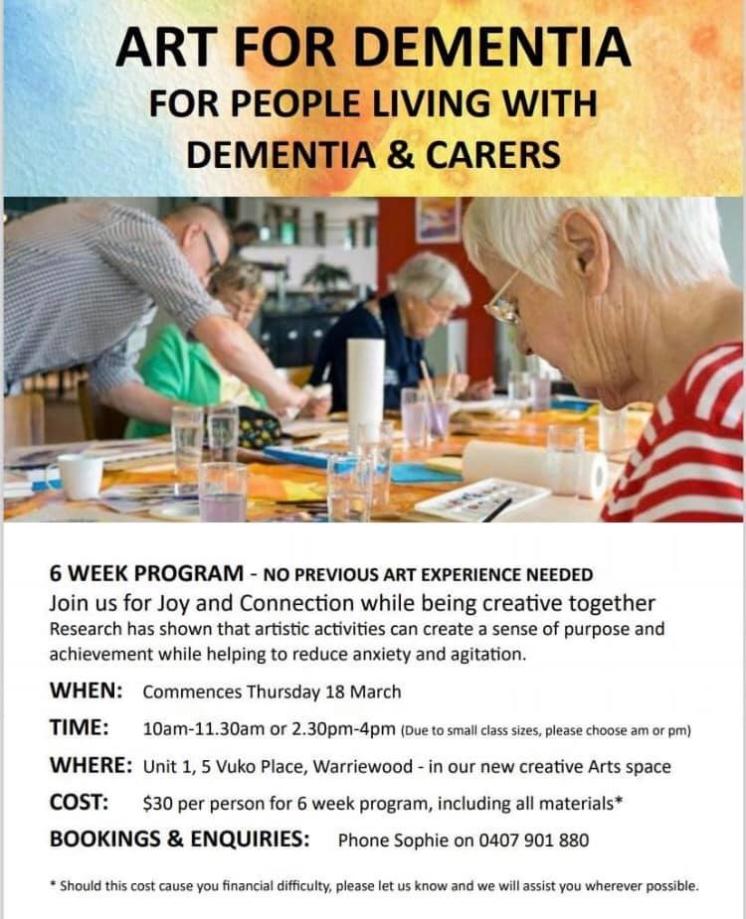
We asked two experts to watch The Father and Supernova. These new films show the fear and loss that come with dementia

Two new films explore the fear of forgetting, loss of control, and other complexities that accompany a dementia diagnosis. The Father and Supernova, both released this month, grapple with the challenges confronting people living with dementia and those who love them.
Dementia is the seventh leading cause of death worldwide, and the second leading cause of death in Australia. The media has an important role in shaping public understanding of poorly understood conditions such as dementia, and it is pleasing to see it considered thoughtfully in both films.
We watched these films through our lenses as a clinician and a neuroscientist. The different causes and conditions that make up the umbrella term of dementia mean the experiences of people living with it — and their loved ones — can differ widely. These films illustrate this well.
Read more: Why people with dementia don't all behave the same
Marching Through The Brain
Because different parts of the brain control different functions, the type of dementia is defined by its pathology, origin in the brain and progression.
In Supernova, directed by British filmmaker Harry Macqueen and starring Colin Firth and Stanley Tucci, we see a fairly accurate representation of frontotemporal dementia. Specifically, this is the type where certain language skills are impaired, known as semantic dementia.
The Father, meanwhile, directed by French playwright Florian Zeller and based on his play of the same name, centres on a protagonist, Anthony (played by Anthony Hopkins), with Alzheimer’s disease, the most common cause of dementia.
Owing to the neurodegenerative nature of dementia, people with this diagnosis experience a progressive deterioration of memory, thinking and behaviour, and gradually lose the ability to perform daily tasks and other physical functions, ultimately leading to death.
Both films accurately reflect many of the key early features of these forms of dementia and provide insight into the varied presentations and issues associated with the conditions.
Whereas The Father focuses more heavily on the experience of the individual living with dementia, Supernova gives more attention to shared grief and loss.
Read more: Alzheimer's could be diagnosed and treated before symptoms occur
Caring And Sharing
In Supernova, Tusker (Tucci) and Sam (Firth) take a roadtrip through stunning northern England. We soon learn the journey is as much an adventure to visit Sam’s family, as it is an exploration of their own mortality.
“You’re still the same person, Tusker,” says Sam. “No I’m not, I just look like him,” his partner responds.
Unlike many other illnesses, those living with dementia frequently show no outward physical signs of their condition until late in its course, and Tusker appears in good physical health.
We witness Sam’s panic when Tusker and their dog Ruby go missing. Impulsivity and spatial disorientation are common phenomena experienced in dementia. Later, Sam masks his distress (as carers often do), attributing his tears to cutting an onion while preparing dinner.
Dementia is a condition that affects the person progressively and globally; we initially only see subtle symptoms of Tusker’s language loss, for example, when he can’t find the word “triangle”. Later we note his loss of instrumental function: needing two hands to guide a glass to his mouth, negotiating which arm goes into which sleeve while dressing. Sam tenderly maintains Tusker’s dignity while helping him dress.
When Sam finds Tusker’s notebook, the writing in it has deteriorated across the pages to an indecipherable scrawl. The last pages are blank.
Tusker declares he is dying — dementia is a terminal illness — but how long he has left is unknown. The median time from dementia diagnosis to death is five years. For a previously high-achieving person like Tusker, the loss of his cognitive ability feels more profound to the viewer.
Frightening Experience
While The Father may appear to be an imagined horror story, it masterfully presents the disorientating and frightening reality for a person living with dementia.
Anthony is a powerful and compelling character who draws us into his internal chaos – unaware that he is losing his sense of self in place and time. We learn he has been an engineer and father of two daughters, and lives in a comfortable dwelling in a leafy London suburb. He is by turns irascible and charming. Like Tusker, he appears physically fit, well-groomed and fed.
The early narrative tension revolves around Anthony refusing home help. He denies verbally abusing a recent carer and accuses her of stealing his watch; when this is shown to be false he shows no insight or remorse. Those living with dementia may strive to make sense of things they cannot remember by imaginatively filling in the gaps.
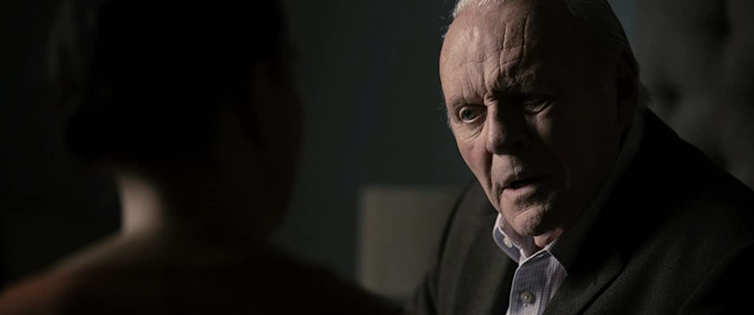
Seeing the world through Anthony’s eyes is a masterful plot device as we the viewers are not quite sure of what is “real”. At some early points we wonder if Anthony is being abused or gaslighted as we are drawn into his perceptions; later we learn that the lens through which we see Anthony’s world is distorted, but a terrifying reality to him.
Like all of us, Anthony is capable of harshness and tenderness, of charm and cruelty. Those experiencing dementia often have diminished control over their emotions and behaviours and this can be exacerbated by stress.
A small weakness of the film is that we gain no real sense of Anthony’s earlier life. Anthony’s temper may indeed be an enduring part of his personality, though it’s more likely a consequence of his serious disease. This is an important point for carers to understand. When his son-in-law challenges him to stop “getting on everyone’s tits” we have some sympathy for Anthony, who we begin to realise is behaving fearfully rather than deliberately.
Eventually Anthony is reduced to sobs: “Lost all my leaves. Branches. Wind. Rain”. As he moves from the moderate to advanced stage of dementia, the need for tender and humane care is clear.
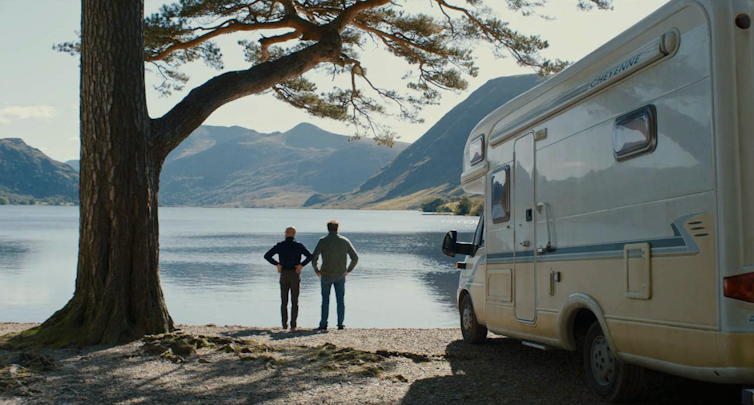
Read more: We all hope for a 'good death'. But many aged-care residents are denied proper end-of-life care
Still Inside
A key theme with many films exploring dementia, is the end — not just the end of the story, but the end of life.
In The Father we are drawn into Anthony’s agonising reality, the quiet chaos of tomorrow. In Supernova, we understand that Tusker chooses to write the end of his own story. Individuals living with dementia may be altered by the disease process, but it’s important to remember that who they are as a person endures.
The nihilistic vision of these films, while powerful and thought-provoking, is not the only possible construction of dementia. Though we must come to terms with the fact that dementia is a terminal disease, the end point does not negate the imperative to respond to the needs of the person; indeed, it highlights the need for empathy.
The Father is in cinemas now. Supernova opens in Australian cinemas from 15 April.![]()
Lila Landowski, Neuroscientist, Lecturer, University of Tasmania and Fran McInerney, Professor of Dementia Studies & Education, University of Tasmania
This article is republished from The Conversation under a Creative Commons license. Read the original article.
'I Was 44 Years Old When Diagnosed With Parkinson's Disease': Parkinson’s Awareness Month
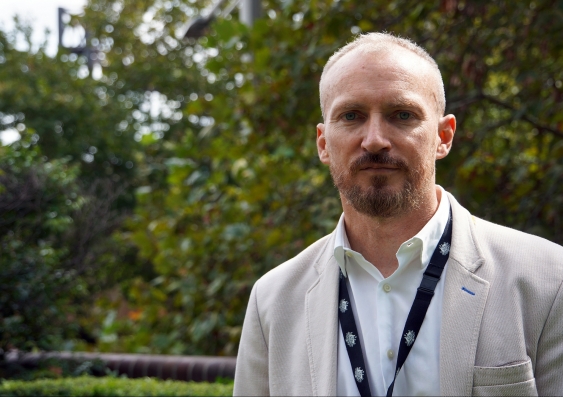
Poor Air Quality In Australian Classrooms Detrimental To Kids' Wellbeing And Learning
“School kids aren’t just little adults...they need specific environmental conditions to be comfortable.”
“Improving indoor thermal and environmental quality is as important as improving the teaching material in the classroom.”
North Shore Parole Officers Share Their Stories In Podcast


World's Smartest Computer Recruited For Future NSW Transport
Plastic Planet: Tracking Pervasive Microplastics Across The Globe
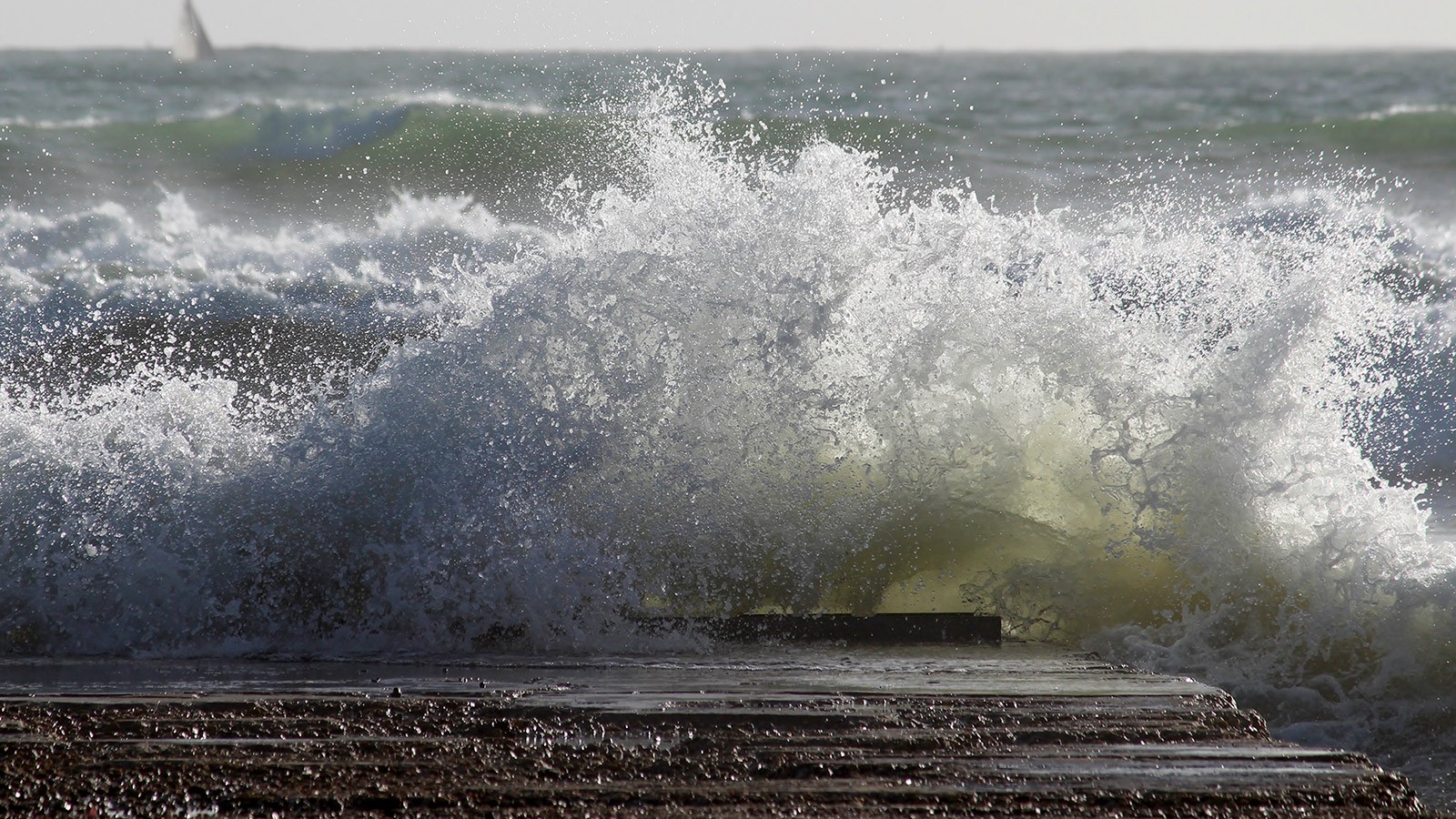
Introduced Honeybee May Pose Threat To Native Bees

Secret Genetic Switch In Zebrafish Key To Heart Regeneration
More kids are being diagnosed with ADHD for borderline (yet challenging) behaviours. Our new research shows why that’s a worry

During my daughter’s challenging first year of school, we discovered how much effort it took her to sit and learn.
She was the youngest in her class, placing her at higher risk of being diagnosed with ADHD (attention deficit hyperactivity disorder).
While she struggled with attention and hyperactivity, her problems were always more frustrating than truly impairing. Still, constant battles over finishing tasks, the amount of time (and nerves) spent on a child that needs that extra bit of attention and the anger or sadness on her face made me wonder if we should try to get some support.
Maybe a diagnosis could be a straightforward fix to the problem?
What’s The Problem?
Increasing awareness of ADHD has led to consistent rises in the number of children diagnosed with and treated for it, both internationally and in Australia. This would be good if it meant we were getting better at finding, diagnosing and helping children impaired by inattention or hyperactivity.
However, my newly published study in JAMA Network Open finds these increases in ADHD diagnoses may be largely due to children like my daughter, whose behaviours fall within a normal (but frustrating) range. I conducted this research with colleagues from the University of Sydney and Bond University.
Our study concluded these children are unlikely to benefit from being labelled with ADHD and may, in fact, be harmed by it.
This surge in diagnoses also results in limited resources being stretched thinner among more children, ultimately taking away from those with severe problems who would benefit from more support.
Read more: How do I know if my child is developing normally?
What Is ADHD? And Why Is It So Controversial?
ADHD is a “persistent pattern of inattention and/or hyperactivity-impulsivity that interferes with functioning or development”.
It’s one of the most common childhood disorders, affecting about 5-7% of children. Over the past decades, debate on the appropriateness of diagnoses has grown in line with the rate of diagnosis.
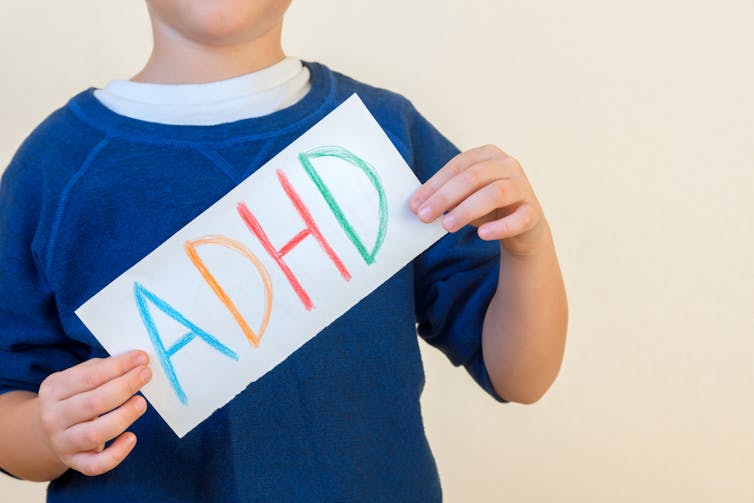
Allen Frances, a prominent American psychiatrist, has been one of the most vocal critics of the trend. He describes it as the medicalisation of “every day experiences that are part of the human condition”.
However, others suggest the increases in diagnosed children are largely due to improved detection in previously undiagnosed children.
Both sides of the debate claim to have proof. But we were surprised to discover no-one had ever summarised the scientific evidence for the key reasons behind increasing diagnosis rates.
So we reviewed the results from over 300 studies on ADHD over the past 40 years to determine which children are being newly diagnosed and if they benefit. Our study design allowed us to summarise a huge variety of studies in a way not done before.
What We Did And What We Found
We found that since the 1980s, increasing numbers of school-aged children and adolescents around the world have been diagnosed with ADHD and medicated for it.
We know ADHD-related behaviours exist on a spectrum with no or minimal hyperactivity and inattention on one end and severe ADHD on the other.
Many children can get distracted easily, are forgetful, find it difficult to sit still or wait their turn. In most children, these behaviours are mild enough to not interfere with a “normal” life.
However, there is no clear biological cut-off point above which someone just “has” ADHD. Ways of diagnosing ADHD also vary between countries and change over time, with criteria generally becoming less stringent.
Together, this ensures many potentially new cases could be discovered, depending on how low the bar is set.
Read more: Five warning signs of overdiagnosis
In the US, for example, almost half of all children diagnosed with ADHD have mild symptoms, with only around 15% presenting with severe problems. Only about 1% of all children in an Italian study had severe ADHD-related behaviours. And, in general, children today are no more hyperactive or inattentive than 20 years ago.
All this led us to conclude a substantial proportion of these additional diagnoses (children who would not have been diagnosed 20 years ago) are, at best, borderline cases.
For example, one study shows while diagnoses increased more than five-fold over ten years in Sweden, there was no increase in clinical ADHD symptoms over the same time. This means that with the lowering of the diagnostic bar, children diagnosed with ADHD are, on average, less impaired and more similar to those without an ADHD diagnosis.
As a result children like my daughter, who are the youngest in their class, are at risk of being labelled with ADHD because their relative immaturity can be enough to push them over the threshold into the zone of “abnormal” behaviour.
Why It’s Important To Get It Right
For children with mild symptoms
Children with mild ADHD symptoms are unlikely to benefit from a diagnosis. They (and their families) also incur substantial costs as well as potential harms from the diagnosis and treatment. That’s because:
instead of drumming up extra support, an ADHD label can have negative social, psychological and academic effects, when compared to similar young people without a diagnosis
medication reduces symptoms to a lesser extent in children with mild ADHD (however it is beneficial in many severe cases)
medication for young people with milder symptoms also has no positive, but a potential negative, effect on academic outcomes (such as maths and reading scores) when compared to unmedicated young people with similar behaviour. Also, medication doesn’t reduce the risks of injuries, criminal behaviour and social impairment as much as in those with severe symptoms.
Read more: Weekly Dose: Ritalin, helpful for many with ADHD but dangerous if abused by those without it
For children with severe symptoms
It’s also important children with more severe ADHD symptoms are correctly diagnosed so they don’t miss out on much-needed support.
With ever-increasing diagnosis rates of ADHD, schools are increasingly struggling to adequately support every child with a diagnosis: the slice of funding and support every child can receive gets smaller and smaller, the more children are included.
In turn, this often means those with the most severe problems get left behind.
Read more: ADHD prescriptions are going up, but that doesn't mean we're over-medicating
What Can We Do?
In light of the potential risks associated with diagnosing a child with milder ADHD symptoms, we recommend doctors, parents and teachers work together following a “stepped diagnosis approach”. This ensures swift and efficient diagnosis and treatment in severe cases. For those with milder symptoms, taking some time to watch and wait may mean many of them won’t need to be labelled or treated.
Not only will this avoid potential harm for individual children, it also ensures resources are allocated where they are needed most and will be most effective.
Co-authors on this article were: Alexandra Barratt, Professor of Public Health, University of Sydney; Katy Bell, Associate Professor in Clinical Epidemiology, Sydney School of Public Health, University of Sydney; and Rae Thomas, Associate Professor, Bond University.![]()
Luise Kazda, PhD candidate, University of Sydney
This article is republished from The Conversation under a Creative Commons license. Read the original article.
Yuri Gagarin's boomerang: the tale of the first person to return from space, and his brief encounter with Aussie culture
Alice Gorman, Flinders UniversitySixty years ago, Russian cosmonaut Yuri Gagarin became the first human to travel in space when he completed his historic orbit of Earth on April 12, 1961.
It was an extraordinary achievement, but created a dilemma for a world embroiled in the Cold War. Gagarin’s spaceflight heralded a vision of a unified planet.
However, in the battle between communism and capitalism, space technology was also a weapon to demonstrate the superiority of one political system over the other.
The Soviet Union was winning the battle. In 1957, it orbited the first satellite with Sputnik 1. Two years later, the Luna 2 probe was the first human artefact to make contact with the Moon. In February 1961 the Russians launched the Venera 1 probe towards Venus.
As congratulations for Gagarin’s feat poured in from around the world, the vehemently anti-communist Australian prime minister Robert Menzies stayed silent.
His views were echoed by members of the Australian scientific establishment. Sir John Eccles, president of the Australian Academy of Science, said the flight was of little value to humanity. Nuclear scientist Sir Mark Oliphant described it as a stunt.
Physicist Harry Messel said:
scientifically I am happy, but from the cold-war perspective I am sad […] it could very well threaten the freedom of the world if Russia continues to triumph in space.
Sputniks And Vodka At The Sydney Trade Fair
The Australian public had other ideas. In August 1961, Sydney hosted an international trade fair with a large Russian pavilion.
Such was the buzz that Henry F. Jensen, the Labor Lord Mayor of Sydney, invited Gagarin to visit as part of his post-flight world tour. A request was sent through the Soviet embassy in Canberra, which passed it on to Moscow. Jensen said:
I am certain Sydney citizens will give him a very warm welcome if he comes here.
Throughout July and August, newspapers reported on whether the invitation had been answered. Anticipation was building.
The Russian pavilion had two life sized replicas of Soviet spacecraft and the public flocked to see them. It was the most popular pavilion at the trade fair (although the mini-bottles of vodka that were given away may have helped too).
Not everyone was happy about it. On August 12, an anonymous caller told police there was a bomb in the Russian pavilion. After evacuation, the bomb threat was proven to be a hoax.
It’s not known if the Lord Mayor’s invitation ever reached Gagarin. Over the next year the cosmonaut visited more than 25 countries on his world tour, but Australia was not among them.
The Space Boomerang
That said, Gagarin still had a close encounter with Australian culture. Australian journalist Wilfred Burchett and his British colleague Anthony Purdy were the first Western journalists invited to interview him privately.
Burchett was the first foreign war correspondent to enter Hiroshima in 1945, and had been hounded out of Australia by the government for his communist sympathies.
Burchett and Purdy met with Gagarin and his interpreters at the State Committee of Foreign Cultural Relations in Moscow, on July 9 1961. They wrote a book about it, contextualising the interview within the broader Soviet space program.
Burchett’s father George was on holidays in Moscow at the time. Just as Gagarin was leaving, George walked in with a boomerang he had in his luggage. He offered it to the cosmonaut, saying “please take this as a symbol of safe return”.
“It always comes back, and I hope you and your colleagues do too.”
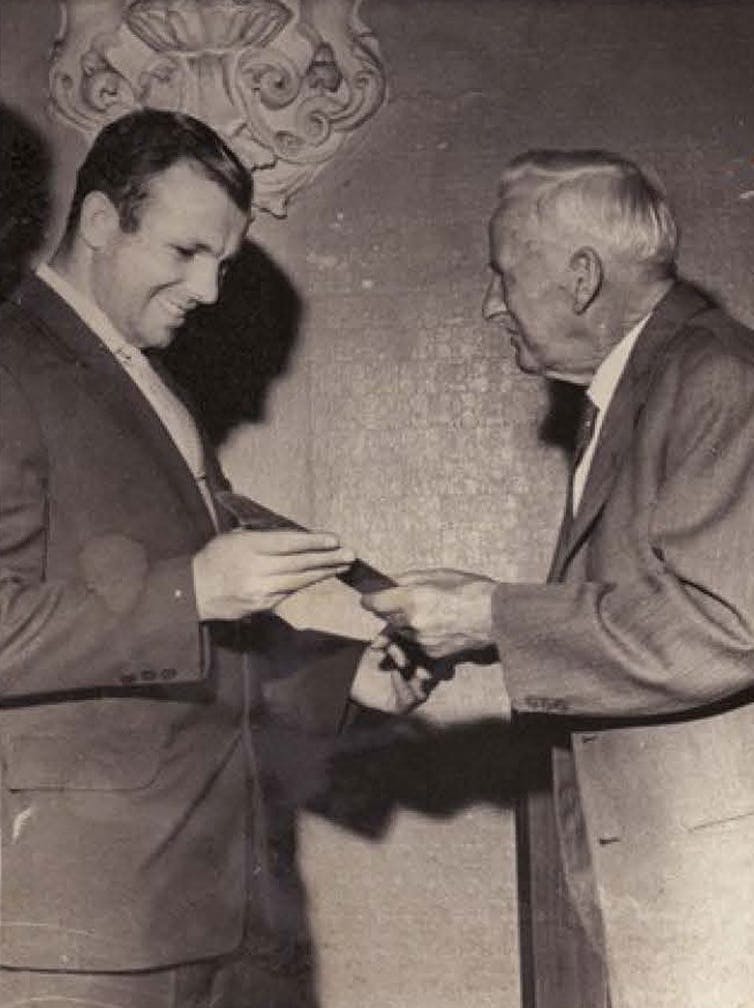
Gagarin was delighted, examining the boomerang closely while the interpreters explained its use. They returned his thanks to George Burchett: “I shall treasure it. It’s a nice sort of symbol to have”.
The label on the back of the photograph, now in the National Library of Australia, says:

In January this year, nearly 60 years after Gagarin’s epic flight, a boomerang carved by Kaurna and Narungga man Jack Buckskin was taken onto the International Space Station by astronaut Shannon Walker.
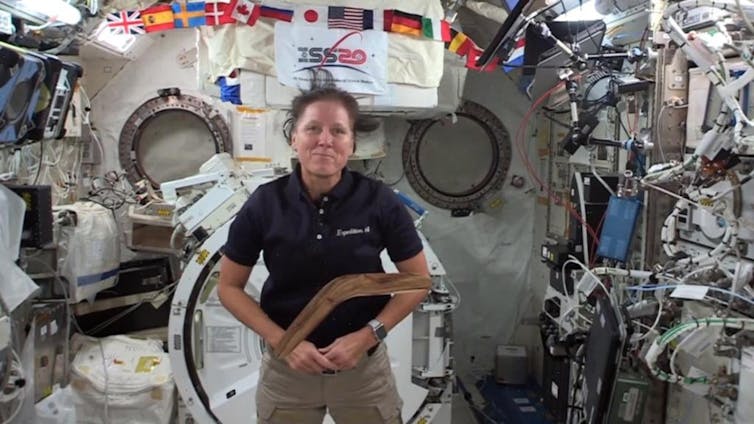
Space Politics In The Global South
On one hand, Gagarin’s spaceflight was a symbol of unity and peace. On the other, it fostered the fear of Soviet aggression from space that started with Sputnik 1. The US also had to obscure its military objectives in space to create a public perception of peaceful intent.
The world tour was an important exercise in soft diplomacy, particularly when Gagarin visited countries such as Ghana and Brazil, which were not aligned with either the US or USSR.
Soviet technology’s promise of modernisation, as seen at the Sydney Trade Fair, was a powerful lure for nations in Africa, Latin America and Asia.
But many rejected the premise of the Cold War. In May 1961, a newspaper in Uruguay asked readers to imagine
the benefits to be gained if the American and Soviet scientists were to unite their efforts […] if these feats were intended to unite rather than divide.

The paradox is captured in one of the most famous photographs of Yuri Gagarin, where he holds a dove, an international symbol of peace, while wearing his military uniform and decorations.
This image is frequently displayed in the Russian segment of the International Space Station.
Gagarin never flew in space again. He was tragically killed in a jet crash in 1968. Around the world civil, revolutionary and international wars were being waged, the most well-known being the American War (also called the Vietnam War) which continued until 1975.
Perhaps no space traveller has ever returned to a world at peace.![]()
Alice Gorman, Associate Professor in Archaeology and Space Studies, Flinders University
This article is republished from The Conversation under a Creative Commons license. Read the original article.
Less than half of Australian adults know how to identify misinformation online

For most of us, it’s hard to imagine a media-free day.
Understanding what’s happening in the world, maintaining our social media profiles, staying in touch with family, being entertained, making new friends, engaging with governments, and with our democracy, are all activities that usually require media participation.
To do these activities regularly and effectively, we need to have at least a moderate level of media literacy.
Media literacy is about more than having a set of technical skills and knowledge about media. It is also about the ability to critically engage with media: to discern fact from fiction, decide which digital technologies and platforms to use and which to avoid, and to critique the power and influence media and technology companies have.
We carried out a national survey of 3,510 Australian adults to investigate their media literacy. We believe this is the first nationally representative survey to investigate the media literacy needs, attitudes and experiences of adult Australians.
We found most Australian adults have a low level of confidence in their media abilities including in areas such as checking if information online is true and checking if a website can be trusted.
This is a problem because people who are less adept at critically engaging with media are more vulnerable to influence from manipulative actors. Lower levels of media ability will result in fewer opportunities to participate in society socially and economically.
Lack Of Confidence For Basic Media Tasks
Overall, we found Australian adult media literacy is low. Most adults had either no or a low level of confidence in ten out of 12 media abilities we listed.
While most people felt confident in their ability to perform a basic online search, far fewer were confident they could verify if information is true or not. And even fewer were confident they could create or edit media such as videos and photos.
Our survey also showed many people lacked the ability to safely navigate online environments: less than half (45%) of Australian adults had a high level of confidence in their ability to change the privacy settings on social media. And only 39% said they were confident they knew how to identify misinformation.
Even fewer adults (35%) were confident they knew what to do when they were harassed online and only a quarter (26%) were confident they could make sense of the terms and conditions of social media platforms.
Older Australians, people who have a lower level of education and people living in a low income household were far more likely to have a lower media ability. This is also true for people living with a disability or in a regional area.
Limited Sources Of Support
We also found 30% of adults had received no help from any of the eight sources of support we listed which would help them analyse, use or create media. This included help from schools, friends, family and libraries.
Read more: 3 ways to help children think critically about the news
Among those who have access to support, the most common source they turned to was online resources (45%) followed by friends (42%) and family (41%).
Those with a low level of education were the least likely to have had any support to help them with media participation.
Strong Support For Media Literacy Education In Schools
Four out of five Australians (81%) said children should receive media literacy education in school.
This significant level of support indicates people believe formal education should play a more central role in the development of media literacy.
But we found schools are not currently fulfilling this need. Only 14% of adults said they had received media literacy support in primary school, 22% received support in secondary schools and 25% received support via tertiary education.
Even for younger adults aged 18-24, schools were far from being a consistent source of media literacy support. Slightly more than half of this group (57%) reported having received media literacy support in high school, while 32% received support in primary school.
Thriving In A Digital World
Misinformation has become one of the great challenges of our time. We have witnessed misinformation influence elections, threaten public health and safety and hamper democratic processes.
Most Australians (67%) said knowing how to recognise and prevent the flow of misinformation was extremely important or very important to them.
Yet our findings suggest some Australians are more likely to be vulnerable to the harms associated with misinformation.
Read more: Fake news was a thing long before Donald Trump — just ask the ancient Greeks
While most Australians said it was important to think critically about the media they consumed, those with lower educational attainment and lower household income were less likely to believe this was important.
Those who have had access to more sources of media literacy support over their lifetime tended to place greater importance on critical thinking skills when using media (78% for those with two or more sources of support) compared with those who didn’t receive any support (55%).
A lack of media literacy will contribute to increasing levels of social, cultural and economic exclusion for individuals, families and groups. In addition, a lack of media literacy may exacerbate the potential for broader social divisions and threats to our democracy due to the influence of misinformation.
Despite this, there is no federal funding or a national policy to advance media literacy in Australia. Given what is at stake, the responsibility for being media literate should no longer be simply left for people to work out for themselves.![]()
Tanya Notley, Senior Lecturer in Digital Media, Western Sydney University; Michael Dezuanni, Associate professor, Creative Industries Faculty, Queensland University of Technology; Simon Chambers, Research Assistant, Western Sydney University, and Sora Park, Lead Author of Digital News Report: Australia 2020, Associate Dean of Research, Faculty of Arts & Design, University of Canberra
This article is republished from The Conversation under a Creative Commons license. Read the original article.
Disclaimer: These articles are not intended to provide medical advice, diagnosis or treatment. Views expressed here do not necessarily reflect those of Pittwater Online News or its staff.